




















THEPOEMREADS:
THEPOEMREADS:
Dear Reader,
Dear Reader,
The drawing you see above is called The Promise It is completely composed of dots of ink. After writing the poem, I worked with a quill pen and placed thousands of these dots, one at a time, to create this gift in honor of my youngest brother and his wife.
Dear Reader,
The drawing you see above is called “The Promise.” It is completely composed of dots of ink. After writing the poem, I worked with a quill pen and placed thousands of these dots, one at a time, to create this gift in honor of my youngest brother and his wife.
Now, I have decided to offer The Promise to those who share and value its sentiment. Each litho is numbered and signed by hand and precisely captures the detail of the drawing. As a wedding, anniversary or Valentine’s gift or simply as a standard for your own home, I believe you will find it most appropriate.
The drawing you see above is called “The Promise.” It is completely composed of dots of ink. After writing the poem, I worked with a quill pen and placed thousands of these dots, one at a time, to create this gift in honor of my youngest brother and his wife.
Now, I have decided to offer “The Promise” to those who share and value its sentiment. Each litho is numbered and signed by hand and precisely captures the detail of the drawing. As a wedding, anniversary or Valentine’s gift or simply as a standard for your own home, I believe you will find it most appropriate.
Measuring 14" by 16", it is available either fully-framed in a subtle copper tone with hand-cut double mats of pewter and rust at $135*, or in the mats alone at $95*. Please add $14.50 for insured shipping and packaging. Your satisfaction is completely guaranteed.
My best wishes are with you.
Measuring 14" by 16", it is available either fully framed in a subtle copper tone with hand-cut mats of pewter and rust at $110, or in the mats alone at $95. Please add $14.50 for insured shipping and packaging. Your satisfaction is completely guaranteed.
Now, I have decided to offer “The Promise” to those who share and value its sentiment. Each litho is numbered and signed by hand and precisely captures the detail of the drawing. As a wedding, anniversary or Valentine’s gift or simply as a standard for your own home, I believe you will find it most appropriate.

My best wishes are with you.
The Art of Robert Sexton • P.O. Box 581 • Rutherford, CA 94573
Measuring 14" by 16", it is available either fully framed in a subtle copper tone with hand-cut mats of pewter and rust at $110, or in the mats alone at $95. Please add $14.50 for insured shipping and packaging. Your satisfaction is completely guaranteed.

All major credit cards are welcomed. Please send card name, card number, address and expiration date, or phone (415) 989-1630 between 10 a.m.-6 P.M. PST, Monday through Saturday. Checks are also accepted. Please allow up to 2 weeks for delivery. *California residents- please include 8.0% tax
My best wishes are with you.
MASTERCARD and VISA orders welcome. Please send card name, card number, address and expiration date, or phone (415) 989-1630 between noon-8 P.M.EST. Checks are also accepted. Please allow 3 weeks for delivery.
Please visit my Web site at www.robertsexton.com
“The Promise” is featured with many other recent works in my book, “Journeys of the Human Heart.” It, too, is available from the address above at $12.95 per copy postpaid. Please visit my Web site at www.robertsexton.com
and VISA orders welcome. Please send card name,
“Across the years I will walk with you— in deep, green forests; on shores of sand: and when our time on earth is through, in heaven, too, you will have my hand.”
“Across the years I will walk with you— in deep, green forests; on shores of sand: and when our time on earth is through, in heaven, too, you will have my hand.”
Presenting Yankee ’s picks for New England’s 10 best snow-season destination towns, where warmth is where you find it, both indoors and out. by Steve
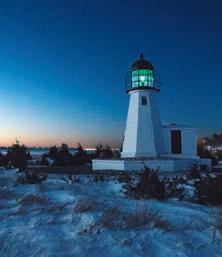
 Jermanok
Jermanok
When the citizens of three tiny New Hampshire communities gather at midnight to cast their votes, more than politics is at stake. by Ian
When you fall into a freezing river in the mountains of western Maine, the will to live can be measured by the need to save one you love. by Elizabeth Cooke
First in a new series celebrating New England’s heritage trades: For more than two centuries, lumber from New Hampshire’s Wilkins sawmill has built barns and homes, redone kitchens, and framed additions. Today, Tom Wilkins is keeping his family’s legacy alive. by Ian Aldrich
First in a two-part series on New England’s energy landscape: Citizen activists in Massachusetts and southern New Hampshire take a real-life crash course in engineering and policy when proponents of a natural-gas pipeline stake a claim to their land. by Howard Mansfield
A portrait of a world apart in the heart of Rhode Island’s Narragansett Bay, a hidden place where “time has a different sensibility.”
text by Mel Allen, photographs by Ron


































































54
54 /// A New Look at Casseroles
Nothing beats the warm comfort of a homey, flavorful, one-dish dinner. by Kathy Gunst

60 /// Local Flavor
Amaral’s Fish & Chips: a family-owned Rhode Island eatery serving irresistible coastal fare and Portuguese American classics. by Amy Traverso
64 /// Could You Live Here?
Uniquely Vermont: Montpelier, smallest state capital in the nation, is quirky, proud, and very much the People’s City. by Annie Graves

70 /// The Best 5
Fireside dining spots: For maximum cold-weather romance, unwind over a satisfying meal beside a blazing hearth. by Kim Knox Beckius
72 /// Local Treasure
Boston’s Nichols House Museum offers an intimate look at Brahmin life on Beacon Hill at the turn of the last century. by Aimee Seavey
74 /// Out & About
Top flower and garden shows, plus 75 other favorite seasonal events. compiled by Joe Bills
departments
8
YANKEE ALL ACCESS
10
DEAR YANKEE
12
INSIDE YANKEE
14
MARY’S FARM
On the Pond by Edie Clark
16
LIFE IN THE KINGDOM
Starting Over by Ben Hewitt
20
FIRST LIGHT
It’s a “Cool Tradition” as folks in South Bristol, Maine, come together every February to harvest the ice from Thompson Pond. by Aimee Seavey
24
64
ONLY IN NEW ENGLAND
Snow Business by Ken Sheldon
26
KNOWLEDGE & WISDOM
Hearty foods, snowy owls, and expert advice on registering your historic property.
29
UP CLOSE
Camden Toboggan Chute compiled by Joe Bills
122
HOUSE FOR SALE
The Bath Sweet Shoppe, in the heart of Maine’s famous shipbuilding city.
126
POETRY BY D.A.W.
140
TIMELESS
BACK TO BASICS: WHERE TO LEARN CHEESEMAKING, CARPENTRY, BREAD BAKING, WEAVING, AND 26 OTHER USEFUL DIY SKILLS.
 by Bridget Samburg, Joe Yonan, and Amy Traverso p. 30
by Bridget Samburg, Joe Yonan, and Amy Traverso p. 30
Kosti






























































































































































1121 Main St., P.O. Box 520, Dublin, NH 03444, 603-563-8111; editor@YankeeMagazine.com
EDITORIAL
EDITOR Mel Allen
ART DIRECTOR Lori Pedrick
MANAGING EDITOR Eileen T. Terrill
SENIOR LIFESTYLE EDITOR Amy Traverso
SENIOR EDITOR Ian Aldrich
PHOTO EDITOR Heather Marcus
ASSOCIATE EDITORS Joe Bills, Aimee Seavey
VIDEO EDITOR Theresa Shea
INTERNS Michele Hirsch, Heather Tourgee
CONTRIBUTING EDITORS Kim Knox Beckius, Annie Card, Edie Clark, Annie Graves, Ben Hewitt, Justin Shatwell, Ken Sheldon, Julia Shipley
CONTRIBUTING PHOTOGRAPHERS Julie Bidwell, Kindra Clineff, Sara Gray, Corey Hendrickson, Joe Keller, Matt Kalinowski, Joel Laino, Jarrod McCabe, Michael Piazza, Heath Robbins, Kristin Teig, Carl Tremblay
PRODUCTION
PRODUCTION DIRECTORS David Ziarnowski, Susan Gross
SENIOR PRODUCTION ARTISTS Jennifer Freeman, Rachel Kipka
DIGITAL
VP NEW MEDIA & PRODUCTION Paul Belliveau Jr.
DIGITAL EDITOR Brenda Darroch
NEW MEDIA DESIGNERS Lou Eastman, Amy O’Brien
PROGRAMMING Reinvented Inc.
YANKEE PUBLISHING INC. established 1935
PRESIDENT Jamie Trowbridge
EDITOR-IN-CHIEF Judson D. Hale Sr.
VICE PRESIDENTS Paul Belliveau Jr., Jody Bugbee, Judson D. Hale Jr., Brook Holmberg, Sherin Pierce
CHIEF FINANCIAL OFFICER Ken Kraft
CORPORATE STAFF Mike Caron, Linda Clukay, Sandra Lepple, Nancy Pfuntner, Bill Price, Christine Tourgee
BOARD OF DIRECTORS
CHAIRMAN Judson D. Hale Sr.
VICE CHAIRMAN Tom Putnam
DIRECTORS Andrew Clurman, H. Hansell Germond, Daniel Hale, Judson D. Hale Jr., Joel Toner, Cor Trowbridge, Jamie Trowbridge
FOUNDERS
ROBB & BEATRIX SAGENDORPH
PUBLISHER Brook Holmberg
ADVERTISING: PRINT/DIGITAL
VICE PRESIDENT/SALES Judson D. Hale Jr.
SALES IN NEW ENGLAND
TRAVEL, NORTH Kelly Moores
(NH North, VT, ME, NY) KellyM@yankeepub.com
TRAVEL, SOUTH Dean DeLuca
(NH South, CT, RI, MA) DeanD@yankeepub.com
DIRECT RESPONSE Steven Hall
SteveH@yankeepub.com
CLASSIFIED Bernie Gallagher, 203-263-7171 classified@yankeepub.com
SALES OUTSIDE NEW ENGLAND
NATIONAL Susan Lyman, 646-221-4169, susan@selmarsolutions.com
CANADA Alex Kinninmont, Françoise Chalifour, Cynthia Jollymore, 416-363-1388
AD COORDINATOR Janet Grant
For advertising rates and information: 800-736-1100 x149 YankeeMagazine.com/adinfo
MARKETING
CONSUMER
MANAGERS Kate McPherson, Kathleen Rowe
ASSOCIATE Kirsten O’Connell
ADVERTISING
DIRECTOR Joely Fanning
ASSOCIATE Valerie Lithgow
COORDINATOR Christine Anderson
PUBLIC RELATIONS
BRAND MARKETING DIRECTOR Kate Hathaway Weeks
NEWSSTAND
VICE PRESIDENT Sherin Pierce
DIRECT SALES
MARKETING MANAGER Stacey Korpi

SALES ASSOCIATE Janice Edson
SUBSCRIPTION SERVICES
To subscribe, give a gift, or change your mailing address, or for other questions, please contact our Customer Service Department: online: YankeeMagazine.com/contact phone: 800-288-4284
mail: Yankee Magazine Customer Service P.O. Box 422446 Palm Coast, FL 32142-2446
We occasionally make our mailing list available to advertisers whose offers we think may be of interest to subscribers. If you would prefer not to receive such offers, please contact us using one of the methods listed above.















New England was the birthplace of the American diner, and these classic establishments still serve as community gathering places. Diner expert Mike Urban dishes up his picks for the best spots in the region:
n O’Rourke’s Diner Middletown, Connecticut
n Agawam Diner Rowley, Massachusetts
n Becky’s Diner Portland, Maine
n Modern Diner Pawtucket, Rhode Island

n Chelsea Royal Diner West Brattleboro, Vermont
For the rest of the list, go to: YankeeMagazine.com/Diners
And DON’T MISS the recipe for the most popular diner dish at: YankeeMagazine.com/Diner-Food

Journey to Cuba in 2016 with Pearl Seas Cruises on an 11-day people to people experience focused on the rich history, heritage, and contemporary life of the Cuban people. The brand new 210-passenger luxury Pearl Mist allows access to more of Cuba’s ports and regions, while providing a relaxed means to interact with Cubans and explore the rich fabric of Cuban culture. These cultural voyages are subject to final government approvals.































































































We received so many wonderful letters about our special 80th-anniversary issue (Sept./Oct.). Here are a few of our favorites. —Eds.
I grew up in Rhode Island and first read Yankee as a child at my grandparents’ house; I remember being captivated by the cover art. Fast-forward to the early ’80s in Minneapolis, where I was living at the time. I went to an estate sale and found a cardboard box filled with old Yankees from the ’40s and ’50s, which I bought for something like a dollar. I read every one cover to cover, missing my grandparents and my beloved New England. I’ve had a subscription for more than 40 years now and will never stop reading Yankee.
 —Steven Thompson
—Steven Thompson


I take exception to your statement in which you supposed that “every person reading these words could get along in the world just fine without Yankee ” [p. 168]. Not true! Thirty-three years ago, this Massachusetts-based Yankee moved to Florida for reasons I’m still trying to fathom. I quickly realized that I’d need a regular dose of New England to keep me at least half sane once I crossed the Mason–Dixon Line.



I used to frame certain Yankee covers that were particularly evocative, so that I could gaze at the beauty of a maple tree in full fall glory while the long fronds of the palm trees just outside the window swayed in the breeze. Though my body resides here, my heart and soul are forever in New England. Each month Yankee reminds me of that truth, and I thank you mightily for it.
Barbara Yoresh Vero Beach, Florida
While sitting here reading the 80th anniversary issue, I just realized that I’ve been looking at the photo of Baxter State Park [p. 102] for almost 20 minutes, and my mind just wandered off to all the places I’ve been to and how lucky I am to have lived in New England. Not everyone can say that they’ve touched Paul Revere’s house or been in the Old North Church or walked the Mohawk Trail. I’m 84 now and have been reading Yankee since I was 12. It made me want to see as much of the world (New England) as I could. My life has been full, and you’ve helped make it so.
 Fred Bousquet Shelton, Connecticut
Fred Bousquet Shelton, Connecticut
Many years ago, prior to my daughter’s wedding, I took the family to Boston for a ballgame and to Durgin–Park for dinner. Gina Schertzer was our waitress [p. 124]. She was telling us the lobster


“Quite possibly the best @yankeemagazine ever. 80 gifts #NewEngland Gave to America. Love it!!”
Sarah Beals @JoyFilledDays
prices, and I asked which was the cheapest. She asked why, and I told her about my daughter’s upcoming wedding. And that I was going to be broke. She asked how many daughters I had, and I told her, “One.” In true Durgin–Park fashion, she never let up on my being cheap. When she brought the bill, she sat on my lap and wiped my eyes with a napkin because she said she knew I would cry. I paid, thanked her for the heckling, and left. Afterwards, I found that everyone in my family had slipped her an extra tip because she was so funny. Your article brought back a fond memory.
Earl Cossaboom Springfield, MassachusettsI am very grateful for being included in the commemorative issue [p. 133], proud to be part of the New England region, and appreciative of your thinking of me.
Bill BelichickFoxborough, Massachusetts

Thanks, Coach, but we’re on to March/ April. —Eds.

I noticed two “gifts” that were omitted: Samuel Colt and Wallace Nutting. Whether or not you’re a proponent of firearms, Colt’s invention helped open the West to settlement. Nutting’s work was how folks in the rest of the country became acquainted with New England. His hand-colored photo prints were famous for depicting the region’s beauty. We have multiple ones in our home to remind us of his “eye” and to help us feel as though we’ve never left.
Maria DaBica Dardano Orange City, Florida
I’m disappointed that you didn’t include two of New England’s most famous writers, Henry David Thoreau and Ralph Waldo Emerson. Their works exerted great influence during their lifetimes and to this day are widely read.
 Joan Chalmers Harris Shrewsbury, Massachusetts
Joan Chalmers Harris Shrewsbury, Massachusetts
Write us at 1121 Main St., Dublin, NH 03444, or editor@YankeeMagazine.com. Please include where you reside. Letters may be edited for length and clarity.


ut there in the land of New Year’s Resolutions, where we promise ourselves that we’ll eat more greens, shed some pounds, walk more, get rid of the clutter, and begin to write in the journal that we received for Christmas five years ago, here’s one more resolution to make. A resolution that can carry you through not only this year but many more to boot, long after that gym membership has languished and the greens have wilted in the fridge: Rekindle the curiosity and desire to learn that we’re all born with. Take those first sometimes-hesitant steps to find new skills, maybe even discover a new passion.
That’s what our special home section is all about. “A Guide to Simple Living: A More Handmade Life” (pp. 30–49) is filled with new chances to test that curiosity. We think that when you read it and consider the 30 different workshops, classes, schools, and learning getaways listed there, it may inspire you to call upon abilities you didn’t even know you could acquire. Skills that know no age boundaries, that require neither wealth nor impressive degrees. The only requirement is wanting to tap into the self-reliant ways in which New Englanders have lived for generations: with resourcefulness, pride in workmanship, willingness to try something new. These are skills that, once learned, can then be passed on to others— friends, children, grandchildren. It’s the way we’ve always learned: teacher to student, who then becomes teacher.
The experts at these workshops differ in what they know but share a love of passing along their knowledge. Then it’s in your hands to enrich your life—as if you yourself become seed, soil, rain, and sun, watching what grows inside. Will knowing how to make a block of delicious cheese or a loaf of wholesome crusty bread, or how to weave a scarf, or how to frame a simple small dwelling, change your life? Probably not. But if these mentors help you to remember what it felt like when you finally got off training wheels and for the first time steadied the bike and shouted, “Look what I can do!” you’ll no doubt add “learn something new” to every list of New Year’s resolutions to come.
Coming back home from a workshop with fresh knowledge is better than a gym, or a bag of lettuce or arugula—as fine as those things are for you. Maybe this is the time to surprise yourself with the gift of childlike enthusiasm. You can learn to ride a bike only once in a lifetime, but there are so many other ways—as the pages ahead will show—to say “Look what I can do now.”
Mel Allen, Editor editor@YankeeMagazine.com






























For a child, watching her grandfather skate created a memory where truth and myth lived side by side.
y grandfather, whom we called Bim, loved to skate. He loved to do anything outdoors. He’d climbed the Matterhorn and surfed in Honolulu, and he did back flips off the high diving board until he was in his seventies. But his enduring love was pond hockey. I was little, but going out to the pond near his house to watch him play with the young men of the neighborhood was a clear memory and always a thrill. He was like a magnet—a big man who arrived at the pond with his skates and hockey stick, a puck in his pocket. He wore a cardigan sweater over a flannel shirt, a necktie, and a hat with ear flaps hanging loose, mad-bomber style. His pants were big and roomy, and his leather gloves gripped his stick.
As soon as Bim got his skates laced, the boys would come out of the rushes as if a whistle had been blown. With a shovel, he would skate-clean the ice and then create a couple of goals using bushel baskets. I liked watching him churn down the ice, boys chasing. I got a certain giggly thrill out of seeing him outskate the boys who swarmed around him as he slapped the puck into the goal.
These Saturday games weren’t particularly regular, but once the word went out, a small crowd would gather to watch the competition. A couple of boards balanced on a couple of rocks made good-enough bleachers, and that’s where I’d be, along with my sister and our mother. Teams, I think, were four on four, or, I seem to remember, one boy and my grandfather against four others. I also seem to remember that my grandfather always won. But that could be my untarnished memory of the man.
An early photograph captured my sister and me on either side of our smiling grandfather, skating on the pond. We were probably 5 and 6. Bim is holding his hockey stick, my sister gripping one end of it, with me on the other end; I’m pretty sure this is how we learned to skate. He’d skate between us and coach us as we glided along. We learned to balance on our figure skates and how to stroke the ice with the blades as we moved forward. A better way to learn was just to watch Bim skate. With the grace of a swan, he’d slide forward and then swirl back, creating sprays of ice dust in his wake. He’d skate furiously from one end of the pond to the other, crossing one foot over the other to gain speed. Then he’d turn and skate backwards, his hands clasped behind his back, easy as pie. For Bim, nothing on ice seemed like an effort; it was all sheer joy. Skating was something we could do together on a cold winter’s day. The pond always felt as though it were our own, the ice carved out of the vast frozen tundra just for us.

My grandfather was a modern man, a man who’d likely embrace every innovation of this postmodern age. He owned the first car in his town (a 1908 Buick) and the first pair of skis, and if he were here today, he’d likely have an Apple watch on his wrist, looking up the secrets of the universe while skating backwards. It was only a few years after my sister and I had wobbled around, hanging on to his hockey stick, that Bim died. We were all in disbelief. He’d been everybody’s patriarch, everybody’s hero. We thought he would live forever and continue to teach us and outskate us. Maybe he’s still doing that.
Edie Clark’s books, including her newest, As Simple As That: Collected Essays , are now available at: edieclark.com

y the middle of January, the snow is thigh-deep in the woods, and when I attempt to drive the tractor down to the copse of balsam fir I’ve been eyeing, I make it less than halfway before becoming mired. I shift into reverse and let the clutch out, but the deep-lugged tires churn uselessly, foiled by the sheer accumulation of snow.
Stubbornly, I keep trying to extricate myself, shifting from forward to reverse and back again as quickly as the tractor’s balky transmission will allow, but every rotation of the tires only sinks the machine a little lower into the snowpack. I can feel my spirits sinking with it. In any normal winter, I’d simply wait for a change in conditions—a January thaw, perhaps, or even the inevitable shift of seasons.
But this isn’t a normal year, because just three months ago, we closed on a parcel of land a dozen miles to the north. Within a month of that, we struck a deal to transition our current homestead to friends. This means that as of this very January morning when I find myself unable to reach the trees that will provide the lumber to build our new home, we have less than 10 months in which to erect shelters for our animals and ourselves.

Ten months to fell the trees, skid them, then lift them onto the mill and saw them into the constituent parts of our new home. Ten months

to stack and sticker the green lumber, still redolent of balsam’s earthy sweetness. Ten months to install the septic system and develop the spring I found entirely by chance, tucked into a little hollow at the base of a rock outcropping about 600 feet uphill of the house site, a stroke of good fortune that prompted me to whoop in delight. Ten months to peruse Craigslist for used windows, and then to drive to western Massachusetts
into even fewer, and as I climb down from the tractor to begin the process of extrication, I feel a tentative, licking flame of despair. What were we thinking? That we could build a house and barn in less than a year, each constructed of lumber we’d sawn ourselves? Hah! If there were no other explanation for a winter of recordsetting cold and relentless snowfall,
and the snow too deep, to make plowing it practical. I’ll retreat to the house to stoke the woodstove, set the coffeepot atop it, and revisit the plans Penny and I sketched out on graph paper.
Already, we’ve revisited them a dozen times over, but what else can we do? In the face of everything we must accomplish before the last autumn leaves fall to the ground, inactivity is not an option.

twice in our old Subaru, returning with so many windows strapped to its roof that I can barely hold highway speeds for the wind resistance. Ten months to plan and replan. Ten months to measure, to saw, to hammer. Ten short months.
perhaps the sheer arrogance of our plan would have been reason enough. The gods generally do not let arrogance go unpunished.
I trudge and wallow through the snow, unreeling the winch cable I’ll use to pull the tractor to higher ground.
Our decision to pull up stakes for a parcel of land a dozen miles to the north of here is rooted in a medley of good old-fashioned Yankee pragmatism, and something that is less easily defined but no less meaningful: an evolving understanding of how we want to carry out the latter half of our lives on this earth. For us, that means downsizing and simplifying our lives even further: a (much) smaller house; a lesser array of outbuildings, designed for the ways in which our homestead has evolved, ways that we couldn’t predict 15 years ago.
We did something we never imagined we might do: committed ourselves to another piece of land. “You’re crazy” was the common refrain.
CABOT
Not inconsequentially, we were smitten with the jettisoning of belongings that our new, half-sized home will necessitate, for it’s a homeowner truism that no matter how big you build, you will fill it. Despite taking pains to minimize consumption, we’d filled our first, 2,200-square-foot effort, and our belongings had become our albatross, as if we bore their significant weight on our shoulders.
And so we did something we never imagined we might do, surprising both ourselves and, it’s fair to say, everyone we know (one friend literally had to sit down when she heard the news): We committed our lives to another piece of land. “You’re crazy,” was the common refrain, or some mildly more polite version of it.
And on some level, we couldn’t disagree, because it was crazy. Our home here, the one you’ve seen depicted in photos over the past year, is wonderful. It’s rustically beautiful and, furthermore, sound of structure and spirit. Our children were born under its roof; Penny and I were married at the knobbed height of the land.
What’s more, the land itself is ideal ly suited to our purposes. The pasture is thick and verdant, the garden soil rich and friable. And our neighbors! All winter, three evenings each week, the boys have snowshoed or skied down to Melvin’s barn to help with evening chores. A half-mile over his hayfield, and then down the steep pasture hill, and then back again in the inky winter dark. Sometimes they’ve complained before leaving, for often it’s been below zero and gusting, but always they’ve returned home full of accomplishment and carrying the incomparable odor of cow barn. “You smell barny,” Penny and I say, stretching out the made-up word for full effect.
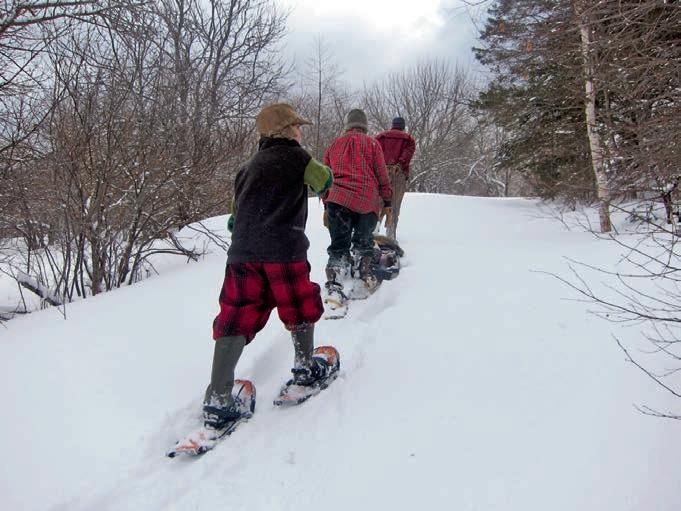
We considered all of this before we made our decision. We considered, and sometimes we cried. We struggled for months with our decision, and the
odd thing was, the moment we realized how happy we could be if we stayed, that was precisely the moment when we felt as though we could do this: despite our love for this place (or maybe because of it); despite the many ways in which this place is ideal for us; despite everyone who thinks we’ve gone off the rails. (And here’s another thing I’ve learned: One of the best ways to know whether a major change is right for you is if everyone thinks you’re nuts and you still want to go for it.)
The land we’re building on is profoundly beautiful, albeit in very different ways from this property. It’s 96 acres or thereabouts, mostly wooded, with a seven- or eight-acre abandoned apple orchard. There’s just enough pasture to graze our small herd of cows. At the height of the land resides a cathedral-like sugarbush, not large enough to interest a commercial sugar maker, but ideal for our purposes: 100 taps, I’m thinking. A year-round stream bisects the property, and already the boys have identified the most prolific brook-trout holes. Already they’ve found bear and raccoon tracks in the silt along its stony edge.
The next year will be as busy as any we’ve known. We still have this property to manage, gardens to plant, animals to husband, winter stores to put up. Despite spending much of the winter selling and giving away the half or more of our belongings that won’t fit into our new, as-yet-unbuilt home, we’re not there yet. We’ve dispensed with the easy stuff, the unsentimental accumulations of the past decade and a half. Next comes the harder stuff: the boys’ favorite toddlerhood toys, the make-believe kitchen set Penny made them. It even has burner knobs and an oven that opens. But it must go.
Still, I think we’ll hang on to it just a little longer. There’s no reason to be hasty: After all, we’ve got 10 whole months.
Read the rest of this series at:
YankeeMagazine.com/Kingdom

It’s a community gathering every February as residents and visitors in South Bristol, Maine, wield saws, “busting bars,” and pike poles to harvest ice from Thompson Pond.

Its crop is no longer making its way to the Caribbean, but for one Maine town, the passing of another New England winter is marked, as it has been for centuries, by the harvesting of ice.
 BY AIMEE SEAVEY
BY AIMEE SEAVEY
oday in Maine, the word “harvest” is most often associated with summer and early fall, when the state’s blueberry and potato crops come in thick and fast—but a century and a half ago, another harvest was equally valuable. Reaching its peak in the dead of winter, this crop wasn’t a grain or a fruit or a vegetable, but cold, hard ice.
In the hundred years before electricity, the same stuff that now comes out of the freezer at the touch of a button was commercially harvested directly from freshwater ponds, many of them in Maine. The resulting blocks were sent not just to neighboring homes, shops, and fishing boats, but as far away as the Caribbean and South America. With the arrival of modern refrigeration during the early 20th century, nearly all of Maine’s icehouses disappeared, but the Thompson Ice House, located on Route 129 in the Midcoast village of South Bristol, remains a rare exception.
After four generations of family ownership and nearly 160 years of commercial cutting, Herbert Thompson knew that the days of profitable ice harvesting on the pond that his great-grandfather Asa Thompson first dammed back in 1826 were over, but he couldn’t bear giving up the tradition. Fortunately, neither could many of his neighbors. After decades of fundraising, the Thompson Ice House Restoration Corporation was formed in the mid1980s, and Thompson officially donated the house and pond for use as a working museum in 1987. From there, it took another three years to build an identical replica of the icehouse, using salvaged materials from the sagging original, complete with a small museum.
of Presidents’ Day weekend, hundreds of locals (plus a smattering of new and returning visitors) turn up at the tiny wooden shack to help keep the ice har vests of South Bristol’s past an active part of its present. Despite the cold, the atmosphere crackles with animated chatter and the rasp and whine of saws. Groups of neighbors talk town news at the ice’s edge, sipping hot chocolate and munching hot dogs from the snack bar, while red-cheeked children play a game of hockey on the one-acre pond’s far side and line up for horse-drawn sleigh rides under bright winter sunshine. Steps away, the surface of the forest-ringed pond is an active work zone, and the plaid-clad volunteers manning the oper ation have the healthy flush to prove it.
Like most harvests, the process of getting the ice from ground to market is straightforward enough, but impossible without a liberal amount of muscle.


The lion’s share of the cutting work is safely done using a sled-mounted circular saw by seasoned volunteers like Thompson Ice House president Ken Lincoln, who’s been cutting here since he was a boy. It’s fun to watch, but questions, and later a helping hand, are encouraged. It’s also a good time to pick up some ice lingo.
In South Bristol, the snow is cleared and cutting lines are marked into a pattern of blocks measuring 22 inches wide by 32 inches long. After the circular saw does its thing, the old-fashioned long saws come out—the kind with sharp, ragged teeth—and novices, including kids, are invited to try their hand at cutting, with guidance from the pros. The ice is first cut into large rafts, or “floats,” made up of the premeasured blocks. Then forked “busting bars” separate the blocks, also known as “cakes,” which float freely in the inky water like a herd of flat, rectangular
icebergs. Each more than a foot thick and weighing as much as 300 pounds, the blocks move awkwardly, so workers wield long-handled “pike poles,” which look a lot like harpoons, to nudge them along toward the channel leading to the icehouse. Arriving at a wooden ramp, the blocks are met by veteran ice men wearing fluorescent, waterproof orange pants—and grins that not even the coldest Maine wind can touch. They position each block into a wooden cradle, where a pulley system (driven now by gasoline horsepower rather than the real thing) hauls it up to the icehouse, where it disappears into the storage room.
There a rugged team receives the new arrivals and uses pike poles to quickly maneuver them (well, as much as you can maneuver a hurtling 300-pound block of ice) into layers. If you can get above the operation and look down, the effect is mesmerizing: a glowing ballet of flannel-clad figures and crusted blocks of ice. To keep the shack cold, its double wooden walls are lined with nearly a foot of sawdust insulation, and hay is sandwiched between each pair of frozen layers.
The Thompson harvest serves a dual role, offering an opportunity not only to reach out and touch a chapter (or block, as it were) of Maine’s economic past, but also to bask in the warmth of honest-to-goodness community camaraderie at its hardiest. And if that’s not enough, in addition to being sold on site via the honor system, a substantial portion of the annual harvest is earmarked for use at the icehouse’s second annual event, an old-fashioned ice-cream social held each July. A bowl of hand-churned ice cream in exchange for the unique pleasure of dragging an antique saw through a foot of natural pond ice? Now, that’s pretty cool.
This year’s ice harvest is scheduled for Sunday, February 14, 2016; the ice-cream social is set for Sunday, July 3, 2016. All are welcome.
For more information go to www.YankeeMagazine.com/clicks.

Route 129, South Bristol, Maine. 207-644-8808; thompsonicehouse.com
Interior & Exerior Real Wood Shutters. Hard-to-find traditional Moveable Louvers all Sizes ~ full Painting family owned ~ Made in USa 203-245-2608 shuttercraft.com

We will custom design a braided rug to meet your needs in any size and over 100 colors. Stop by our retail store and factory at: 4 Great Western Rd. Harwich, MA 03645

888-784-4581
capecodbraidedrug.com
Our rockers, chairs, recliners, and sofas are “made to fit your body.” Visit our showroom at 99 Sadler Street Gloucester, MA 01930

800-451-7247 kleindesign.com
Quality, durability & service guaranteed, Droll Yankees bird feeders were the first and are still the best. Shop for our authentic bird feeders & accessories online.
800-352-9164
drollyankees.com
ome winters are notable for specific storms, such as the Great Blizzard of 1888 and the Northeastern Storm of 1978. Then there are winters remembered for their sheer obstinacy, like last year’s, 2014–15, which went on longer than the Black Death but was more depressing. New Englanders take a variety of approaches to handling all that snow. Here we present Yankee ’s guide to shoveling, mainly so that we don’t have to go out and do it ourselves.

The minimalist’s goal is to clear a space just big enough to park his car, no more. This also gives him the advantage of privacy, since, after about the third storm, the piles of snow on either side of his car make it invisible from the road. Pulling out onto the street involves saying a quick prayer, gunning it, and hoping for the best. He’s met many of his neighbors this way, mostly to share insurance information.
This person actually enjoys winter’s worst chore—even without benefit of medication—which just goes to show that it takes all kinds. If there’s more than an inch of snow, he’s out there shoveling, and he goes back out every two minutes so that he can “keep ahead of it.” As exercise goes, he figures it’s cheaper than a membership at FitnessWorld and doesn’t require him to wear anything involving Spandex.
Woefully unprepared for winter, this type can’t be bothered to zip up her jacket, lace her boots, or put on a hat every time it snows. Her only goal is clearing a path to the mailbox so that she can get her copy of Meditation Monthly to maintain her inner peace. Last year, her inner peace blew a gasket after the fifth blizzard and took off for Bermuda.
Despite the availability of newer, hightech models, this fellow is still using his old metal shovel, which weighs more than the hood of his ’67 Chevy pickup. Also known as “The Heavy Heaper,” he likes to demonstrate what a he-man he is by putting as much snow as possible on each scoop, a practice that over the years has allowed his chiropractor to buy a boat, put braces on his kids’ teeth, and take winter vacations to places where there’s no snow.
This type tosses snow with the care and precision of a Category 5 hurricane, little knowing or caring whether it lands in the street, in his neighbor’s driveway, or on top of passing pedestrians. What he lacks in neatness he makes up for in speed, which leaves him time to get back to more important winter tasks, like staying on top of his fantasy football league team.
This person falls prey to every late-night commercial for “the easy way to remove snow and ice.” Over the years, she’s purchased ergonomically designed shovels (from the Greek ergon, meaning “sillylooking”), electric shovels (essentially, weed-whackers for snow), and even a remote-controlled robotic shovel, which removes snow quietly, neatly, and just in time to haul the grill out for the July Fourth barbecue. None of these gadgets works, but she keeps trying. Note that she’s also been married four times.
By the end of last January, this guy had developed a seriously bad attitude. Determined to put winter in its place, he bought a propane device designed for those who don’t want to remove snow but to destroy it. He wields this tool while shouting, “Die! Die!” When he returns to the house he mumbles, “I’ll be back …” His friends and family are nervous.
An analytical sort, this person approaches shoveling like the Allied landing at Normandy. He has determined the best pattern to clear his driveway in the least amount of time with the fewest strokes. He also has a precise pattern for arranging lights on the Christmas tree, carving the turkey, and loading the dishwasher after dinner. You don’t want to be stuck talking to him at a party.


his is the season to get out that old pair of skates, to take advantage of a solitary woodland pond where the ice groans like a living being, or just to pull on heavy boots and mittens for a walk to the post office, with the snow creaking underfoot and icy branches chattering overhead. Of course a large part of the charm comes from knowing there’s a warm fireside, literal or figurative, to come home to, and perhaps a bowl of chowder and a skillet of cornbread to stoke inner fires. If winter demands a different way of dressing and a different way of moving, it also requires a different way of eating: hearty, wholesome food that sets this season off from the rest of the year. Our traditional foods—chowders, baked beans, steamed puddings, baked pies, and that most maligned but most delicious (when properly made) of dishes, the boiled dinner—all seem made for cold weather.
—“In Praise of Slow Food,” by Nancy Harmon Jenkins, January 1996

—Denis Leary (born 1957). The son of Irish immigrants to Worcester, Mass., this irreverent veteran of the Boston comedy-club scene is now an award-winning actor and producer. Following the deaths of six firefighters in a 1999 warehouse blaze in his hometown, he launched the Leary Firefighters Foundation, which has raised and donated millions of dollars toward emergency equipment and facilities in Worcester, Boston, New York, New Orleans, and elsewhere.

“Racism isn’t born, folks, it’s taught. I have a 2-year-old son. You know what he hates? Naps! End of the list.”
560 snowy owls that Mass. Audubon’s Norman Smith has caught in the vicinity of Logan Airport over the past 32 years
10/22
earliest arrival of a snowy owl at Logan Airport
32 YEARS maximum lifespan of a snowy owl
owls Smith captured at or near Logan Airport in the winter of 2013–14

1700



acres: Logan Airport footprint, resembling Arctic tundra (minus the terminals and





Logan Airport

-81° lowest temperature (Fahrenheit) that a snowy owl can withstand

1000-3500 miles (round trip) snowy owls fly to and from their Arctic breeding grounds

7000 miles (round trip) flown by one snowy owl outfitted with a GPS transmitter at Logan Airport
270° range through which a snowy owl’s neck can swivel, a quarterturn shy of all the way around






ince 1966, when it was created under the authority of the National Historic Preservation Act, the National Register of Historic Places has been identifying America’s historic resources and listing those most worthy of preservation. That list now includes more than 90,000 properties. Inclusion signifies importance but doesn’t guarantee preservation. As the director of the National Register program for the Massachusetts Historical Commission, Betsy Friedberg (RIGHT) has overseen scores of evaluations. She spoke with us recently about the Register and its role.
“In evaluating properties for the National Register, we look at whether a property or district is significant, and whether it retains its ability to convey its significance,” Friedberg says. Connec-

tions to historic events, architectural developments, or significant people are important considerations. In some cases—an archaeological site, for instance—a resource may be included because of its potential
to reveal information in the future. “Most of the properties we list tell a story of their community,” Friedberg adds. “National Register nominations are the vehicle for conveying that story.”
The Register program relies on information from individuals and communities, which is evaluated by the State Historic Preservation Office before a nomination is prepared. “We look to the community to bring forward properties that might have been overlooked but are significant and worthy of preservation,” Friedberg says. “There’s no greater expert on what’s important to a community than the community itself.”
In some cases, properties that don’t qualify for listing on their own may still be eligible as part of an ensemble of buildings, structures, or landscape features: a National Register district. If you believe that your property merits consideration, Friedberg recommends starting at your state historic preservation office, where useful information may already be on file. Each state has somewhat different procedures for evaluation and nomination, but all are based on guidelines from the National Register. “Many property owners love to do research and have done a lot on their own, which is great,” Friedberg says. “But when it comes to the actual nomination, we may still recommend the assistance of a preservation consultant, who understands what it takes to put together a nomination and can focus [owners’] efforts.”
Every once in a while, a request comes in to consider a property that
is already listed. “Before 1980, there wasn’t a requirement that owners be notified about the designation when a property changed hands,” she notes, “so sometimes people contact us and we can give them a happy surprise.”
Don’t expect a speedy process. “We don’t bring nominations forward until we feel that they’re complete,” Friedberg says. Expect several rounds of questions and requests for more information before your nomination is deemed ready to be brought before the state review board. In Massachusetts, there may be as many as 50 properties ahead of yours in the queue, and the board meets four times a year, voting on five to eight nominations per session. Finally, successful nominations are sent to the National Park Service for review and listing. More info at: nps.gov/nr
LEFT : Built c. 1762, the historic Reeves Tavern (now a private home) in Wayland, Massachu setts, is currently under consideration for National Register designation. In his diary, John Adams mentioned stopping here for breakfast in November 1774.

Because they were meant to be pulled down snowshoe trails, early toboggans could be 8 or 10 feet long, but only about 1 foot wide. Toboggans were sometimes pulled by snow dogs, but most often by a man or woman wearing a chest harness.
Early European settlers adopted toboggans for transport, but soon realized that they had recreational value as well.
On February 5–7, the 26th annual U.S. National Toboggan Championships will be held at the Camden Snow Bowl on Ragged Mountain in Midcoast Maine. Last year, more than 425 teams competed in front of thousands of spectators.
Despite its lofty title, the championships are open to anyone who signs up. The event is believed to be the only organized wooden toboggan race in the country, and perhaps in the world.

The Camden chute is one of North America’s biggest, and the only one of its kind left in New England. It’s open to the public on most weekends, holidays, and school vacation days, weather permitting.
For folks who bring their own toboggans, the fee for using the chute is just $5 per person per hour. Or you can rent a toboggan here for $10 per hour.
Rentals are handcrafted by the local Camden Toboggan Company from native ash.
The 440-foot chute is 2 feet wide and has a vertical drop of more than 70 feet, propelling toboggans at speeds of up to 45 mph. Sleds that stay upright stop by plowing through the snow on Hosmer Pond.
Jack Williams, who was 9 when the Snow Bowl first opened, recalls that his 25-cent membership to the Camden Outing Club allowed him to ride his toboggan all winter long.
Camden’s original chute didn’t last long, as the salty Penobscot Bay air caused rapid corrosion.
It had been out of service for many years when it was rebuilt by the U.S. Coast Guard in 1954. By 1964, the chute had once again fallen into disrepair.
The chute sat in ruins until 1990, when Williams, by then a successful businessman and a prominent member of the Camden community, headed up a project to rebuild it. It was dedicated as the Jack R. Williams Toboggan Chute in January 1991. Williams still rides the chute at least once every winter, as the flag bearer and first rider at the championship event.
On February 24, 1991, the first national championships were held at the Snow Bowl, drawing a small but enthusiastic crowd of about 100 Camden folks. The event was conceived by the Parks & Rec department as a winter amusement for locals, but as word spread, people from all over the country started signing up. In recent years, the championships have raised as much as $60,000, which goes toward the Snow Bowl’s operating expenses.
Many participants build their own sleds and design their own uniforms—or costumes. So you might see a toboggan loaded with pirates or Muppets or football players whiz by.
Tobogganing became a popular sport in the late 1880s. Three modern Olympic sports were born out of downhill tobogganing: bobsledding, luging, and skeleton racing.
More information at: camdensnowbowl.com / toboggan-chute
—compiled by Joe Bills
Long before Europeans arrived here, Natives of the northernmost areas of North America used handcrafted toboggans to transport people and goods across the snow. The word toboggan likely originates from the Mi’kmaq (tobâkun) or the Abenaki (udãbãgan) word for “sled.”






FOR THE WOULD-BE DO-IT-YOURSELFER, OUR GUIDE TO SCALING BACK AND SIMPLIFYING, FROM CHEESEMAKING TO RAISING CHICKENS TO BUILDING YOUR OWN (TINY) HOUSE.
Here in the land of Yankee ingenuity, the desire to be more self-su cient is something like a birthright. Conspicuous consumption may be our economy’s primary driver, but the Puritan ethic still holds some sway. And in these times of uncertainty—environmental, financial, political—many of us are shifting toward simplicity, greener living, and self-reliance. It might be as simple as growing and canning tomatoes or learning to knit or dye wool, or it might even mean going o the grid. The collective do-it-yourself ethos is on the rise.
We may not all want to be homesteaders living o the land, but nearly everyone can still find ways to embrace a more handmade life. presents our guide to the simple life in New England—from cheesemaking and weaving schools to beekeeping and chicken farming workshops—plus essential reads and festivals where you can’t help but pick up tips and meet people who are learning by trial-and-error what works. No matter your interest level, there’s a book or a school or a craftmaking vacation that will inspire you to learn something new.
 BY BRIDGET SAMBURG, JOE YONAN, AND AMY TRAVERSO • ILLUSTRATIONS BY TWO ARMS INC.
BY BRIDGET SAMBURG, JOE YONAN, AND AMY TRAVERSO • ILLUSTRATIONS BY TWO ARMS INC.
GILL, MASSACHUSETTS
“These are small and intimate classes, and I really make you feel what you’re doing,” says owner Cliff Hatch. Cheesemaking classes are offered in spring and fall. Students with access to milk from their own animals are encouraged to bring it along to Upinngil’s daylong workshops, or Hatch will supply milk from his herd of grass-fed Ayrshire cows. Beginning classes focus on simpler, softer cheeses such as cream cheese, Camembert, Brie, and blue; there’s also an advanced hard- cheese course (cheddar or Monterey Jack). Participants learn about milk quality and which type of bacteria to use as a starter for each kind of cheese. upinngil.com
CRAFTSBURY, VERMONT
Nestled in the beautiful Northeast Kingdom, Sterling College offers a popular and intensive cheesemaking course in partnership with the experts at Jasper Hill Farm. This hands - on, two-week course covers the fundamentals of artisanal cheesemaking, exploring various styles of cheese as well as the science behind the craft. sterling college.edu/academics/continuing-education/ artisan-cheese-program
WARREN, VERMONT
Linda and Larry Faillace offer oneto three - day courses on their farm in the Green Mountains from May to October, using a variety of milks (cow, sheep, water buffalo, goat) and covering the spectrum of cheese styles, from softer cheeses to more challenging, mold-based types. Students range from dabblers to would-be professionals contemplating a career change. threeshepherdscheese.com

SOUTH DEERFIELD, MASSACHUSETTS
Launched in 1978, this school is run by Ricki Carroll, the self- described “cheese queen,” whose home cheesemaking kits are sold online and in gourmet shops around New England. Carroll teaches a one - day, “101” intro workshop as well as a more - advanced
two - day class that will have you pulling mozzarella and turning out your own Camembert- style rounds. cheese making.com

KENNEBUNKPORT, MAINE
“I knew I wanted to do something surrounded by fire and gardens,” says Jill Strauss, a former schoolteacher and Johnson & Wales culinary-school grad. “It engages all of the senses.” Classes, which tend to run three to four hours, are held May through December in Strauss’s kitchen and in the lush gardens where her wood-fired oven stands. Strauss traveled to Italy to study Neapolitan pizza making, and her classes cover a range of subjects, from pizza to pasta to pie-making. jillyannas.com
Small groups allow for plenty of handson experience in these open -hearth cooking classes. Offered year-round in the historic Wheelwright House, the museum’s two-hour courses are rooted in traditional New England cooking, such as bean soup, cod cakes, roasted meats, and hearth-baked bread (stu-

Sterling
offers an intensive two-week course in cheesemaking in
 College
partnership with Jasper Hill Farm in Greensboro, Vermont. The operation’s cheese cave, dubbed “The Cellars at Jasper Hill,” includes seven specially calibrated vaults for ripening.
College
partnership with Jasper Hill Farm in Greensboro, Vermont. The operation’s cheese cave, dubbed “The Cellars at Jasper Hill,” includes seven specially calibrated vaults for ripening.
There’s nothing better than the aroma of bread baking in a wood-fired oven.
A selection of New England chefs and instructors can show you tried-and-true techniques for hearth cooking.

dents leave with a printed cookbook). According to Bekki Coppola, director of education, many students come to learn to use their own traditional hearths, but some are simply hoping to become masters of the campfire. strawberybanke.org
WESTERLY, RHODE ISLAND
Using her reproduction 1775-type fireplace, Linda Madison teaches small groups how to cook over an open hearth as well as in a beehive oven. Classes run four to six hours and are offered only in the winter months. Here students can expect to cook a complete meal using a few simple fireplace techniques and antique utensils. Madison offers a blend of historic and modern recipes. “The emphasis is not on Colonial recipes,” she says. That said, Madison’s classes always make Martha Washington’s spiced gingerbread and Thomas Jefferson’s bread pudding. woodyhill .com/cooking
a more handmade life
Shore. “It’s critical to have a hands-on class,” she says, noting that many students are intimidated by canning and worried about safety issues. “If you’ve never done it, it can seem so overwhelming, but it’s so simple.” Grieco’s classes cover pickling, canning, and preserving and use produce from local farms. carolynsfarmkitchen.com
EAST THETFORD, VERMONT
At this “organic farm with a social mission,” you can not only purchase a CSA
subscription but also learn to put up your veggies in classes on preservation and traditional canning. The spring roster includes a session on salt brining (vinegar-free pickling); fall classes include the basics of home fermentation and everyday meal preparation using fermented foods. Free events include Community Cannery Days in July and September, when participants work with kitchen staff to preserve the day’s crop for a share of the goods. The farm’s half-day sessions are small—no more than 15 students each—and are held in an idyllic setting along the Connecticut River about 12 miles north of Hanover, New Hampshire. cedarcirclefarm.org

Making apple butter in your sleep.
keep a stack of aspirational gardening and craft books by my bed, mostly unmolested, occasionally perused. I like the idea of them. I think to myself, Someday, when I’m a completely different person living an entirely different life, I’ll tackle all these projects. But for now, I have a job and a family, a modest 4-by-4 raised-bed garden, and a stack of unsewn quilt squares stashed away in a cabinet. Here’s one thing I can do: make apple butter in my slow cooker at night, while I sleep. It’s a trick I discovered while writing my book, The Apple Lover’s Cookbook (W. W. Norton), and it goes a long way toward delivering the satisfaction of making something by hand, even if you lack Nearing-esque zeal.
The method is entirely simple: Peel and core 5 pounds of apples (any kind) and cut them into chunks. Add 1¾ cups sugar, ½ teaspoon each ground cinnamon and kosher salt, ¼ teaspoon each ground nutmeg and ginger, 2 cups apple cider, and ¼ cup fresh lemon juice. Turn your slow cooker on high, cover, and let cook for about 1½ hours, stirring occasionally. Now set the lid a bit ajar, to let some steam escape.
That’s it. Get a good night’s sleep: 7 to 9 hours. When you wake up, the house will smell like heaven. Stir the apple butter, then refrigerate for up to 3 weeks. Or you might want to can it: Divide the butter evenly among 6 sterilized pint jars (or 12 sterilized half-pint jars), leaving ¼ inch of space at the top of each. Use a pair of tongs to place the lids atop the jars. Then use your hands to twist the bands into place; tighten most of the way. Gently place the jars in a canner with enough boiling water to cover them by at least an inch. Boil 10 minutes; then gently remove and transfer to a wire rack until the jars cool to room temperature. Test the seal: If it’s tight, tighten the bands completely— you’re done. — A. T.



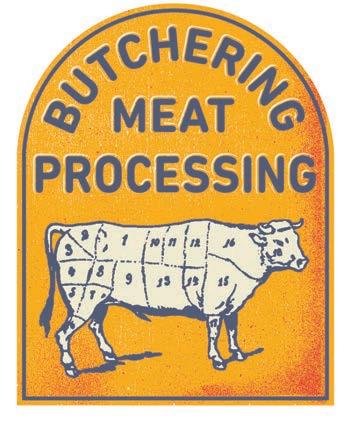
WESTPORT, CONNECTICUT
“The people who used to know how to do this aren’t around anymore,” says owner Ryan Fibiger. He offers singleday basic butchery classes as well as weekend-long courses on slaughtering techniques. “It’s a really important part of the process,” he says. Fibiger says his students include those who are simply curious, others who are devoted
a more handmade life
hunters, and still more who are farmers, seeking to learn more about processing their own animals. fleishers.com
Lynn Coale is nostalgic about a time when people shopped for meat at the local village butcher shop. As director of the Hannaford Career Center, which offers vocational and technical courses to local youth and adulteducation programs to the general public, Coale says that most American beef is processed in one of four plants around the country. But interest in the trade is coming back, and artisan meat cutters are very much in demand. The center offers intensive, multiweek courses in butchering and poultry processing, including instruction in knife skills, anatomy and physiology, food safety and sanitation, and the humane and ethical treatment of animals. hannafordcareer center.org
HARRISVILLE, NEW HAMPSHIRE
The town of Harrisville in southwestern New Hampshire is a designated National Historic Landmark, the only 19th-century mill town that still survives in its original form. The Colony family ran the woolen mills here from the mid-1800s until 1970, and in 1971, John Colony founded Harrisville Designs to keep the town’s textile heritage alive. The center offers workshops in sweater and Japanese knitting; basic, tapestry, and rug weaving; color design and garment construction; and spinning for all levels. Classes run anywhere from two days to multiple weekends. harrisville.com
Norma Smayda has been weaving for nearly 50 years and running her school for 40 of those. She offers two- and three-day workshops year-round, as well as intensive 15-week programs with an emphasis on traditional and Scandinavian weaves for table linens, curtains, towels, wall hangings, and more. Students come with mixed abilities, and Smayda adjusts the curriculum to each. saunderstownweavingschool.com

 Sara Parker Strube works at a loom at Harrisville Designs, a restored mill complex in a historic New Hampshire village, offering classes and workshops in the textile arts, including weaving, knitting, and spinning.
Sara Parker Strube works at a loom at Harrisville Designs, a restored mill complex in a historic New Hampshire village, offering classes and workshops in the textile arts, including weaving, knitting, and spinning.
 THIS PAGE : A backyard beekeeper inspects a comb from a thriving hive. OPPOSITE : Students from Imagine That HONEY! in Swanzey, New Hampshire, tour a local bee yard.
THIS PAGE : A backyard beekeeper inspects a comb from a thriving hive. OPPOSITE : Students from Imagine That HONEY! in Swanzey, New Hampshire, tour a local bee yard.

GREENVILLE, RHODE ISLAND
a more handmade life
at his first meeting. Now, dozens of people come out to share tips and solve problems. “Interest has skyrocketed,” says Lafferty, who serves as president of the association. He attributes much of the interest to public concern over colony-collapse disorder. The association schedules courses and “Bee School” sessions throughout the year so that newbies can temper their enthusiasm with knowledge. ribeekeeper.org
SWANZEY, NEW HAMPSHIRE
A beekeeper for 15 years, Jodi Turner knows that it’s impossible to learn everything in one workshop or even over a year. Having a mentor to guide you through various stages and questions is invaluable. “I love to see people
thing comes together.” Her workshops typically begin in March and classes are three hours long, once a month, for six months. imaginethathoney.com
HANOVER, CONNECTICUT
Stuart Woronecki, a professional beekeeper for 12 years, welcomes beginners to learn all the beekeeping basics, from hive maintenance, to equipment, to coping with pests and disease, to honey harvesting and processing. His classes run several times per year at locations in Coventry and Mystic, Connecticut, and after four sessions (two and a half hours each), his students are ready to start off on their own. “It’s challenging to be successful,” he admits. But his classes offer a comprehensive foundation and a community of fellow learners. ct-honey.com

A city boy explains the enduring appeal of his sister’s Maine homestead.
 TEXT BY JOE YONAN • PHOTOGRAPHS BY MATT KALINOWSKI
TEXT BY JOE YONAN • PHOTOGRAPHS BY MATT KALINOWSKI

ou’re obviously playing the long game,” I tell my brother-in-law, Peter, after we spend an hour strolling around what he and my sister, Rebekah, consider their “forest farm”: a third of an acre of southern Maine woodland on which they’ve planted chestnuts, hazelnuts, black walnuts, and the berry bushes that love to grow in their shade.
Peter smiles. “Well,” he replies, “someone once said, ‘If I knew I’d die tomorrow, I’d plant a tree today.’”
This corner of the farm—affectionately called “the savannah”—is the latest addition to their North Berwick homestead. It’s all part of a life they’ve dedicated to growing food: not for any sort of retail market, but as a way of sustaining themselves, of building a livelihood from the ground up. It’s a far cry from my decidedly more urban existence, busy with a downtown desk job as food editor of the Washington
Post, with restaurant tasting menus and yoga classes. As a journalist, I’ve spent many years getting closer and closer to the source of my sustenance, but my sister takes it to a level that has both intimidated and fascinated me. A few years ago, when work and personal stresses (plus a book contract) had me longing for a retreat, the first place I thought of was the homestead, and I spent a year there learning as much as I could about how they do what they do, and why.
Ever since I started visiting them about 15 years ago, urban friends have asked me to define “homesteading.” It’s tempting to call it the act of growing your own food, but that doesn’t exactly do it justice. “The farmer grows for what sells and must make a living doing it,” Peter says. “The homesteader grows for what the family wants and needs and how they want that to happen.” It’s about frugality; about a close, respectful connection to the land; about using sometimes-
limited resources in a thoughtful way. It’s the antithesis of one-click Amazon shopping, something I engage in just about every week.
But homesteading isn’t about strict self-sufficiency. As Peter points out, why try to do everything yourself when your neighbor is happy to trade his fresh milk for your eggs? When I visited Peter and Rebekah for a week last summer, the first thing I noticed when we pulled onto their road was a huge sign that read, “Leaves wanted.” And sure enough, neighbors were soon dropping off bags of what became a rich mulch for the garden. It’s about interdependence, not independence.
Peter, now 69, bought his five acres for $1,500 in 1976, a little more than a decade after he’d lived for two months with back-to-the-land gurus Helen and Scott Nearing. With a background in construction, he went on to work for many years as a labor activist and writer; in his spare time, he cleared the land and built all the structures himself. When Rebekah, 63, first joined Peter in Maine, the main house was about the size of a trailer, but they expanded it to about 1,200 square feet, brought the garden up to a quarter-acre, and built more sheds, a cold house, even a yoga studio, all powered by solar panels.


My year with them was transformative: It made me much less likely to shy away from physical labor. It taught me the therapeutic value of what I call “mono-tasking”: taking time to immerse myself in one activity rather than toggling among email, Facebook, and the like. It made me into a gardener, too: Upon my return I sold my condo, bought a townhouse farther from downtown, and transformed my 150-square-foot front yard into an abundant source of food. (My first summer harvest included 30 pounds of cucumbers, 50 pounds of tomatoes, and more chile peppers than I could count.)


I continue to be inspired every time I visit. This last time, the two beamed with pride as they pointed out the beachplum bushes, the persimmons, the native chestnuts. It looked supremely organized into a grid, each tree encircled by logs that will feed the soil and the tree’s growing roots as they decompose. They’re watering it all generously, just once a week, but after a year or two they’ll step back and let nature take its course.
At one spot in the heart of the savannah, Rebekah took a seat on a stump that Peter had left in place—and on which he had carved a simple back. “We call it the throne,” she said. She looked up and around and let out a sigh, and I knew exactly what she saw, because if I squinted I could start to see it, too. She was envisioning tomorrow, and next year, and the next decade, and the next century, each year richer and lusher than the one before as the trees grew at different rates and as the grid gave way to nature’s gorgeous randomness. She saw a canopy of greens and browns and reds shading a forest, sundappled and scattered with leaves and moss and twigs, brimming over with food, forever.
It’s about frugality; about a close, respectful connection to the land; about using sometimes-limited resources in a thoughtful way.THIS PAGE AND OPPOSITE : The author’s sister Rebekah and her husband, Peter, at home in North Berwick, Maine; they’ve been homesteading here for 40 years now.
HARPSWELL, MAINE

Farming, logging with draft horses, gardening, animal husbandry, soap making, raising chickens, fiber arts: Jim Cornish covers it all. The school, located on Cornish’s farm, runs yearround on a trimester schedule, with logging, canning, and maple sugaring in the winter; heavy gardening and building projects in the spring and summer; and winemaking, foraging, and butchering in the fall, among other pursuits. Cornish takes four students per trimester (they live on site) and tailors the curriculum accordingly. stone-soup-institute.org
Koviashuvik
TEMPLE, MAINE
Ashira and Chris Knapt have been homesteading and living off the land for about 17 years. In 2008 they started Koviashuvik (Inuit for “a time and place of joy in the present moment”) to help others learn how to incorporate aspects of homesteading into their own lives. The couple teaches a variety of classes, but the most popular is the three-day family sustainability stay. “It’s an educational vacation for families or couples of all ages,” Chris

a more handmade life

n a beautiful clearing in the woods, surrounded by a timber-frame house and rustic cabins, rests one of Maine’s most peac ef ul spots. Chickens cluck, pi gs root for food, and an expansive garden slowly blooms. At the Deer Isle Hostel, hosts De nn is Carter and A nn Carter -S u nd qv ist welcome guests with warm enthusiasm, pl us hand-p um ped water, composting toilets, solar showers, and nightly c ommunal dinners.
For most of us, the idea of living off the land is daunting, not to mention impractical. But to become immersed in the world of the hostel is an opportunity to taste the simple life, if just for a few days. The farm is open to visitors in summer, and guests are asked to just help keep things tidy—no mandatory hard labor. “[Hosting] keeps me connected to the rest of the world,” Dennis says by way of explanation, though he’s hardly isolated; he and Anneli are active community members and do have Internet access. But guests are asked to refrain from cell-phone use, and there’s no electricity from which to recharge anyway. Musical instruments are encouraged. Solar-powered lights illuminate the main guest house “I just want people to know that this is possible,” Dennis says.
Lack of refrigeration means meals are built around fresh produce from the gardens, eggs from the chickens, cured meats, and c anned tomatoes from the prev ious season’s harvest. Guests are also asked to contribute s omething to the meal. One night in the middle of July, we feasted on a rich tomato s oup with lentils and sautéed ramps and che es e brought by another visitor. After dinner, a campfire.
The solar shower pro ved to be an un ex pected highlight of the stay. The water is piping hot, heated by a nearby compost pile. I filled a watering can, hooked it to a boat line, hoisted it to my desired height and presto, a comfortable shower. I went through two bucketfuls, but only because it was too much fun to quit after just one round. —B.S.
Deer Isle Hostel 65 Tennis Road, Deer Isle, Maine. 207-348-2308; deerisle hostel.com. Rates: $25/pe rson/night; $60 private; $15 kids under 14
says. Visitors can tailor their own time and pick and choose the courses that are most interesting to them. Classes include foraging, basketmaking, composting, solar showering, and knife sharpening, to name just a few. kovia shuvik.com
Twelve years ago Margaret Hathaway and her husband, Karl Schatz, left New York City and headed for the hills,
quite literally. “We knew we wanted to get back to the land,” says Hathaway, who had been the manager of the famous Magnolia Bakery. She and Schatz interviewed people all over the country to determine how to best start homesteading and moved in 2005 to a plot in southern Maine. They garden, make cheese, offer poultry-slaughter workshops, and teach classes on chicken raising, bread baking, and more. The farm’s adorable herd of goats enjoy taking hikes with visitors. living withgoats.com

 FROM TOP : Margaret Hathaway and Karl Schatz of Ten Apple Farm in Gray, Maine, with their goats Joshua Lawrence Chamberlain and Chansonetta, who happily lead visitors on Sunday hikes into the woods; canning, cheesemaking, and other homesteading workshops are offered here.
FROM TOP : Margaret Hathaway and Karl Schatz of Ten Apple Farm in Gray, Maine, with their goats Joshua Lawrence Chamberlain and Chansonetta, who happily lead visitors on Sunday hikes into the woods; canning, cheesemaking, and other homesteading workshops are offered here.

 FROM TOP : Students at The Farm School in Athol, Massachusetts, unwrap haylage for winter cattle feed; the farm’s Red Devon cows are a heritage breed.
FROM TOP : Students at The Farm School in Athol, Massachusetts, unwrap haylage for winter cattle feed; the farm’s Red Devon cows are a heritage breed.
PROVIDENCE, RHODE ISLAND


This one-stop shop for urban growers and gardeners provides tools, feed, supplies, and classes on small-scale food production, backyard animal husbandry, food preservation, and healthy living. Located in a former gas station near Federal Hill, this cute shop even has beehives and a handsome flock of chickens clucking around the demonstration gardens. cluckri.com


ATHOL, MASSACHUSETTS
Crop planning, greenhouse agriculture, root-cellar preparation, and small fruit-orchard management are a few of the skills taught here. The school offers a year-long program beginning in October, preparing students for serious farming. “In order for people to dive in and walk away with confidence and competence, everybody moves through the program and does everything,” says director Patrick Connors. Students run a vegetable CSA, work with draft horses, study animal husbandry (including cattle and poultry management), and learn to weld and build. Some go on to start their own farms, and others work as farm managers. farmschool.org

BURLINGTON, VERMONT
This six-month, full-time experience offers classes in seeds, soil, field care, harvesting, and equipment. Students rotate through area farms, while also running their own fruit and vegetable operation. The program runs May through October and typically includes 20 to 25 new students each year. learn.uvm.edu/program/farmertraining


WAITSFIELD, VERMONT
With more than 100 hands-on courses per year, Yestermorrow is a longstanding destination for beginners and skilled professionals seeking to launch hobbies or further careers. From two-day introductory woodshop classes to multiweek certificate programs, this school can get you started on furniture making, energy efficiency, timber framing, fine finish plastering, net-zero design, small-house design, even skin-on-frame canoe construction in the Celtic and Inuit traditions. yestermorrow.org
BAKERSFIELD, VERMONT
Peter King has been building and living in tiny houses for years. He envisions whole communities of tiny houses, inhabited by people who are working the land, maybe as farmers or maybe as laborers, living on little money and using few natural resources. In the meantime, he’s teaching others to build their own small houses. Intensive, weekend-long workshops, scheduled throughout the year, accommodate four to twelve people each. vermonttiny houses.com

Two recent books from New England authors give you the 101 on all things homegrown, homemade, and do-it-yourself.

The Backyard Homestead Book of Kitchen Know-How


Vermont author Andrea Chesman teaches readers the essentials of jellymaking, fermentation, sourdough, fresh-cheese preparation, even basic butchery, in this easy-tofollow guide. (Storey, 2015)
WASHINGTON, MASSACHUSETTS
“Timber framing is the traditional way of building with timber on your own property,” says program director Will Beemer. And what could be more DIY than building your own home?
Heartwood offers multiday training in timber grading, framing, finish carpentry, even tiny-house construction. Beemer says that many of his students are looking to build their own gardening sheds or guesthouses, while others are traditional carpenters who want to learn timber framing. heartwood school.com
Homesteading: A Backyard Guide to Growing Your Own Food, Canning, Keeping Chickens, Generating Your Own Energy, Crafting, Herbal Medicine, and More

Abigail Gehring, also from Vermont, takes beginners through the essentials of raising vegetables, fruits, and meat, then touches on everything from basketweaving to irrigation-system design. (Skyhorse Publishing, 2014)

Crafted entirely of sterling silver, our simple-but-chic necklace goes just about everywhere. Highly polished beads by the hundreds are gathered in three twisting, turning strands. 18".

Item #784548 $125 FREE SHIPPING
To receive this special offer, you must use Offer Code: TWIST81
Enlarged to show detail.
 Students at the Heartwood School in Washington, Massachusetts, keep the craft of timber framing alive using traditional tools and techniques.
Students at the Heartwood School in Washington, Massachusetts, keep the craft of timber framing alive using traditional tools and techniques.
For 42 years, builders and beginners have flocked to Woolwich to learn from the masters. The most popular workshops—an intensive design/build course and a post-and-beam primer—require a multiday commitment. Design/Build covers everything from site planning and foundation basics to insulation selection and alternative energy sources, plus wiring, plumbing, roofing, and more; Purely Post & Beam takes you from designing to cutting to raising a timber frame. You can also sign up for one-time workshops of just a few hours apiece that will teach you useful DIY skills and crafts, such as how to pour your own concrete countertops; sharpen tools; carve wooden spoons, reliefs, or canoe or kayak paddles; wire your home; and make wooden boxes using hand-cut dovetail joinery. shelterinstitute.com
Once a year, Hancock Shaker Village offers a five-day intensive class on timber framing that resembles nothing less than an old-fashioned barn raising. A small, hands-on group—usually no more than 16 students, plus two instructors—builds a timberframe structure and has it in place by the time the workshop ends. The class is always scheduled to coincide with the village’s annual Country Fair in September, making it an especially festive place to spend several days. hancockshakervillage.org
Bridget Samburg is a Boston-based newspaper reporter and magazine contributor. Her recent stories for Yankee include “The New Yankee Craftsmen” (Jan./Feb. 2015) and “The Restorers” (March/April 2015). Joe Yonan is the food and dining editor of the Washington Post and author of Eat Your Vegetables: Bold Recipes for the Single Cook and Serve Yourself: Nightly Adventures in Cooking for One. joeyonan.com
Feeling DIY Curious? Sample a world of new skills at these popular festivals.

third weekend after Labor Day
Unity, Maine
The Maine Organic Farmers and Gardeners Association offers a multitude of apprenticeship, support, and educational programs for new and established farmers. The organization’s annual Common Ground Fair brings it all together over three days, with dozens of workshops on everything from permaculture gardening and seed saving to goat milking and hoof trimming. (Topics also include cooking, parenting, crafts, foraging, and even dogsledding.) It’s the “Big E” for back-tothe-landers—a congenial, family-friendly gathering of thousands. If you’re curious about the farming life, this is the place to get a taste. mofga.org/thefair
Kneading Conference & Maine Artisan Bread Fair



late July
Skowhegan, Maine
The Maine Grain Alliance offers two-day workshops throughout the year for bakers and grain aficionados looking to get their hands tucked into many types of dough. But the highlight of the year is the group’s annual kneading conference and bread fair, a three-day baking bonanza during which participants bake dozens of unique loaves in wood-fired ovens. Workshops include how to build your own firebrick or earthen oven (and use it for baking) and a dedicated track for home bakers. It’s a must for serious bakers and bread lovers. kneadingconference.com
New Hampshire
Sheep & Wool Festival
mid-May
Deerfield, New Hampshire
In addition to the 100 or so vendors, the handcrafts show, and the sheep-shearing and Border-collie demos, this annual gathering from the New Hampshire Sheep & Wool Growers Association offers workshops on wet felting, knitting, spinning, and needle felting. nhswga.com
The senior population in the U.S. is growing rapidly, and many aging baby boomers are choosing to move into retirement communities, opting for a lifestyle that fits where they are at this stage in their life. The reasons are many and varied, but some of the more common include relief from the challenges of home maintenance, being part of a friendly community of peers, availability of social activities, and access to services and health care that may be needed in the future.
The move to a retirement community typically follows an extensive exploration of







available options. Often, even after all the visits, talking with staff and residents,
consulting family, friends, and professional advisors, uncertainty lingers. How will





Apartment living at Piper Shores offers residents affordable, fully updated homes, with all the benefits of Maine’s first and only nonprofit lifecare retirement community. Located along the Southern Maine coastline, our active, engaged community combines worry-free independent living with priority access to higher levels of on-site healthcare—all for a predictable monthly fee.
Call today for a complimentary luncheon tour.
the actual experience measure up to expectations? You never know for sure until after the move, so we asked residents at a New Hampshire Continuing Care Retirement Community if they had experienced any surprises after making the move.

The common sentiment was that their new lifestyle exceeded their most positive expectations.
“Our parents lived in a retirement community, so we had a good idea of what to expect. But we were still surprised at how quickly we adjusted,” said Bob and Arlene. Their three biggest surprises were positive: the comforting sense of financial and personal

security; the realization of how the move was a gift for their children; and how quickly they felt at home in the community.
Ted and Chris moved in less than a year ago, and their biggest surprise was how quickly they got to know people. “We soon felt like we’d been living here for years and were surprised at how quickly we got to know the names and faces of staff and neighbors. We knew we would meet people and make friends, but underestimated how important seeing and spending time with people we just met would be for us.”
Jack and Pat made the move with Jack making it clear from
Enjoy life with stunning bay views. Take advantage of home ownership without property maintenance at Penobscot Shores in Belfast—Maine’s Premier Oceanfront Retirement Community.

• Alice Peck Day Hospital
• Dartmouth College
• Dartmouth Medical Center
• Great Shopping
207-338-2332 penobscotshores.com
Independent and assisted living at its nest, at either The Woodlands or Harvest Hill, o er spacious apartment style homes for vibrant seniors seeking a supported environment that adds to their quality of life and a sense of peace—all in the beautiful Upper Valley of New Hampshire.


When was the last time you attended Opera North in Lebanon, The HOP in Hanover, The Woodstock Inn or simply vacationed in the Upper Valley? You can enjoy all that the Upper Valley has to o er by moving to The Woodlands or Harvest Hill.

Southgate is located in the historic town of Shrewsbury, Massachusetts. A uniquely planned community, Southgate allows ready access to services, all under one roof. Enjoy a wealth of amenities, such as restaurant-style dining, indoor swimming, live theater, and candlepin bowling. Feel secure knowing there is a full continuum of care right on campus.

| Toll Free: 877-524-5600 www.taylorcommunity.org



the start that he had no interest in moving to a retirement community and only did it because his wife wanted to. “My big surprise is that I’m enjoying living here,” he said. While he has always enjoyed the company of others, he’s not big on structured and organized social activities. “What I’ve found is that people do their own thing.”
Joan and Bill were surprised at the level of activity in their new community home. “What we realized after making the move was how much our lifestyle at home had changed without us recognizing it.” They are an active couple who moved from a large, beautiful home in rural New Hampshire.
“We’ve always been very active, but didn’t realize how much we’d scaled back our socializing. We’re less keen on driving after dark and with the least bit of winter weather, we were inclined to cancel,” they said. Bill and Joan take part in their community’s many activities: concerts, speakers, exercise programs, and enjoy dining out with friends and neighbors.
“We’re more engaged and involved now than we have been in years, because everything is right here.”




It’s interesting to note that in each case, when seniors were asked what was most surprising after making the move into a retirement community, it wasn’t about things, it was




about people. One might have expected to hear people saying it took time to adjust to the downsizing, i.e. living in a smaller home or doing without certain belongings that they chose not to bring with them. Or that some might talk about the challenges of adjusting to a different lifestyle, a new home, a new location. Yet the biggest surprise in most responses was how quickly and easily they adjusted to the change.
The Armstrong’s, who just recently moved from their Plymouth home to a retirement community in Laconia, shared their experience and some advice for others considering a similar move. “We didn’t meet

anyone who regretted the move, only those who said they should have done it years ago,” they said. “The decision is tough, but the experience has been great. Our advice is to meet as many people in the community as possible, staff and residents alike. They’re the ones who can really provide a good feel for whether the move is right for you.”
Contributor to this article Paul Charlton is the marketing director for Taylor Community, a not-for-profi t continuing care retirement community in New Hampshire’s Lakes Region. For more information call (603) 524-5600 or online www.taylorcommunity.org.




 by Kathy Gunst
by Kathy Gunst
rowing up in the 1960s, I almost always took my mother’s announcement of “Casserole for dinner!” as bad news. It meant that she was about to open a few cans and throw some random, unrelated foods together in a dish: cream-of-mushroom soup, a can of tuna, crispy canned onions. For all that those casseroles offered in convenience, they reneged on flavor and freshness. And yet I can’t deny the cozy comfort of a homey dinner baked in a single dish. It’s a throwback to another time, a reminder of days gone by. So I still make casseroles—only with whole ingredients and a fresher, healthier twist.
These recipes run the gamut from a pasta-free zucchini “lasagna” to a mac-and-cheese swirled with green spinach and sprinkled with peppery Italian pancetta to chicken pot pie topped with mashed potato. Rounding out the lineup, our white bean and sausage casserole is topped with crunchy herbed panko breadcrumbs. (The beans come from a can—I think my mother would approve.)
TOTAL TIME : 1 HOUR 30 MINUTES ; HANDS- ON TIME : 45 MINUTES
Comfort food with a twist: Crispy, peppery pancetta and spinach are folded into pasta and topped with a rich, nutmeglaced cheese sauce. A crispy panko breadcrumb topping is the icing on the cake.
Note: This dish can be made several hours ahead of time; cover and refrigerate until ready to cook. Be sure not to add the topping until you’re ready to bake the casserole.
FOR THE MAC-’N’-CHEESE:
2 1/2 ounces pancetta or thick bacon (about 4 slices)
1 teaspoon plus 1 1/2 tablespoons olive oil
5 ounces baby spinach
3 tablespoons salted butter
1/4 cup all-purpose flour
5 cups whole milk
1/8 teaspoon freshly grated nutmeg
Kosher salt and freshly ground black pepper, to taste
2 cups (8 ounces by weight)
grated Gruyère cheese
1 cup grated Parmesan cheese
1 pound macaroni or gemelli pasta, cooked
FOR THE TOPPING:
1/2 cup grated Parmesan cheese
1/2 cup grated Gruyère cheese
1/2 cup panko breadcrumbs
1/8 teaspoon freshly ground black pepper
In a medium-size skillet over mediumlow heat, cook the pancetta or bacon in 1 teaspoon of olive oil, flipping halfway through, until crisp, 8 to 10 minutes. Drain on paper towels, leaving the fat in the skillet. Crumble the pancetta or bacon into small pieces and set aside.
Bring the skillet back up to medium-high heat. Cook the spinach in the reserved fat, stirring, until just wilted, about 3 minutes. Remove the
pan from the heat. Stir in half of the crumbled pancetta or bacon, reserving the remaining half. Set aside.
Make the cheese sauce: In a mediumsize saucepan, warm the butter and remaining 1½ tablespoons of olive oil over medium heat. Add the flour and stir to make a paste (called a roux); cook, stirring, until the roux is golden in color, about 2 minutes. Slowly whisk in the milk, and bring to a gentle simmer, stirring, until thickened. Season with the nutmeg and salt and pepper to taste. Off the heat, add the two cheeses and whisk until smooth. Stir in the spinach/pancetta mixture.
Preheat your oven to 375° and set a rack to the middle position. Pour the cooked pasta into a 9x13-inch (or 14- to 16-cup) baking dish. Add the cheese sauce; stir to combine. (The dish can be made up to this point several hours ahead of time; cover and refrigerate. Bring to room temperature before baking.)
Meanwhile, make the topping: In a small bowl, stir together the cheeses, panko, pepper, and remaining crumbled pancetta. Sprinkle over the pasta mixture and bake until the top is browned and the sauce bubbling, 45 to 50 minutes. Yield: 6 to 8 servings
TOTAL TIME : 1 HOUR 40 MINUTES ; HANDS- ON TIME : 1 HOUR
The ultimate comfort food, chicken pot pie is usually topped with a buttery pastry. But here the topping is made from that other comfort classic, mashed potato.
FOR THE POTATOES:
5 medium-size potatoes (about 1 1/4 pounds total), Yukon Golds or russets, peeled and cut into 1-inch pieces
3/4 –1 cup half-and-half
1 1/2 teaspoons chopped fresh thyme leaves
1 1/2 teaspoons finely chopped fresh rosemary
Kosher salt and freshly ground black pepper, to taste
1 1/2 tablespoons olive oil
1 large leek, white and pale-green parts only, thinly sliced
1/2 cup diced onion
3 celery ribs, chopped
3 carrots, peeled and chopped
1 1/2 teaspoons chopped fresh thyme leaves
1 1/2 teaspoons finely chopped fresh rosemary
1 1/2 teaspoons kosher salt
1/2 teaspoon freshly ground black pepper
1 tablespoon salted butter
3 tablespoons all-purpose flour
1/3 cup dry white wine
2 cups chicken stock
1/3 cup heavy cream
3 1/2 cups cooked, skinned, and cubed chicken, white or dark meat
1 cup frozen peas
1/3 cup fresh parsley, finely chopped
Prepare the potatoes: Bring a large pot of lightly salted water to a boil over high heat. Add the potatoes and cook until tender when tested with a small, sharp knife, about 20 minutes. Drain thoroughly and return to the pot.
Mash the potatoes using a potato masher and add ¾ cup half-andhalf, making sure that the liquids are absorbed into the potatoes. Add the remaining ¼ cup half-and-half if the potatoes seem dry. Add the thyme, rosemary, and salt and pepper to taste. Set aside.
Make the filling: In a large skillet, heat 1½ tablespoons of the oil over medium heat. Add the leek and onion, and cook, stirring occasionally, until translucent, about 6 minutes. Add the celery, carrots, thyme, rosemary, salt, and pepper, and cook, stirring occasionally, 5 minutes. Add the butter; when it’s melted, stir in the flour. Cook 1 to 2 minutes.
Increase the heat to high and add the wine; it will quickly be absorbed. Add the chicken stock, and bring to a boil; then reduce the heat to low and cook, stirring, 5 minutes.

These casserole recipes may all be served as a main dish or as a side dish. If you want to make the casserole the star of your meal (and by all means, we recommend it), here are a few ideas for sides:
■ Mix seasonal greens and toss with olive oil, lemon juice, salt, and freshly ground black pepper.



■ Make a simple seasonal salad of very thinly sliced raw green and red cabbage tossed with toasted walnuts and a basic vinaigrette.
■ Toss Brussels sprouts in olive oil and roast in a 425° oven on a cookie sheet until tender and almost turning dark brown on the edges, about 25 minutes. Top with pomegranate seeds, olive oil, and vinegar.
■ Don’t forget a loaf of warm, crusty bread.
FOREGROUND, CHICKEN POT PIE WITH HERBED MASHED-POTATO CRUST (RECIPE OPPOSITE)
BACKGROUND, BRUSSELS SPROUTS TOPPED WITH POMEGRANATE SEEDS (RECIPE ABOVE)
Stir in the heavy cream, chicken, and peas. Remove from the heat and add the parsley.
Pour the mixture into a mediumsize (about 10-cup) square or round baking dish. Gently spread the mashed potato over the top. (The casse role can be made several hours ahead of time up to this point; cover and refrigerate until ready to bake.)
Preheat your oven to 400° and set a rack to the middle position. Bake until the top is golden brown and the filling is bubbling, 30 to 40 minutes. Serve hot. Yield: 6 to 8 servings

TOTAL TIME : 1 HOUR 40 MINUTES ; HANDS- ON TIME : 40 MINUTES
Imagine strips of zucchini acting as pasta … It’s a great alternative for gluten-free eaters. Serve with (regular or gluten-free) bread; you’ll want to sop up all the juices.
2–3 large zucchini (about 1½ pounds)
2 tablespoons olive oil, divided
1 1/2 teaspoons kosher salt, divided
1/2 teaspoon freshly ground black pepper, divided
2 cups canned diced tomatoes with their juice, divided
1/2 tablespoon fresh rosemary, chopped
1/4 cup fresh basil, very thinly sliced into ribbons, divided
2/3 ounce fresh mozzarella (packed in water), cut into very thin slices, divided
1 cup freshly grated Parmesan cheese, divided
5 ounces ripe tomatoes, very thinly sliced
Preheat the oven to 400° and set a rack to about 5 inches below the heating element. Cut the ends off the zucchini. Cut each zucchini in half crosswise, then lengthwise into slices about ¼-inch thick.
Pour 1 tablespoon of olive oil into each of two rimmed baking sheets, and use your fingers to spread it around evenly. Arrange the zucchini slices in a single layer on the sheets, turning once to coat with oil. Sprinkle each sheet with ¼ teaspoon salt and ¼ teaspoon pepper. Roast until the slices sizzle and begin to brown, 12 to 15 minutes.
Pour 1 cup of the diced tomatoes on the bottom of an 11x7-inch (or 6- to 8-cup) baking dish, and stir in all of the rosemary and 1 tablespoon of the basil. Arrange half of the cooked zucchini slices on top of the sauce in a solid layer. Season with ½ teaspoon salt, ¼ teaspoon pepper and 1 tablespoon of the basil. Spoon the remaining cup of diced tomatoes on top; then place half of the mozzarella on top and sprinkle with half of the Parmesan. Top with the remaining zucchini. Sprinkle with the remaining salt and basil. Layer the fresh tomato slices on top; then top with the remaining mozzarella and Parmesan. (You can make this several hours ahead of time; cover and refrigerate until ready to bake. Bring to room temperature before baking.) Cover tightly with foil and bake on the middle rack 20 minutes. Remove the foil and bake until the sauce is bubbling and the cheese is golden, about 40 minutes more. Yield: 4 to 6 servings
(continued on p. 130)







A family-owned Rhode Island eatery serves coastal fare and Portuguese American classics.

 BY AMY TRAVERSO
BY AMY TRAVERSO
of regulars, Joan and Helen, are queuing up for
their usual Thursday lunch. “I’ll get this, honey,” Joan says—she calls everyone “honey”—as Helen takes a booth by the window. “We’ll have two small fish and chips and three clam cakes,” she tells Donald.
A few minutes later, Donald’s nephew, Brian, comes out with plates of fried haddock and a small basket of the briny clam fritters that hit the perfect ratio of tenderness and crunch. Amaral’s specializes in fried seafood and grinders (not “subs”—this is southern New England), made with the traditional meatballs and chicken parm, but also chouriço and peppers, fried clam, and blade meat (marinated pork shoulder). Fish and chips may be the shop’s namesake, but even better are the delicate fried smelts, which come marinated, served with a zingy red sauce with little chunks of onion and garlic that Brian makes from scratch. Fried calamari is served with pickled banana peppers and drizzled with garlic butter. Gilding the lily? Maybe, but they’re delicious. And if you’re in this deep, you might as well go all the way.
Joan and Helen have finished their food and caught up on their grandkids. They breathe their stories like oxygen. It’s the rhythm of the secondgeneration American: You eat a meal, then you tell stories about the old days. Now they’re on to the problem with the new generation. “Back then, you had problems just like everyone else, but you stayed together,” Helen says.
“You made your bed and lay in it,” Joan adds.
“We certainly enjoy our meals here, though, don’t we?” Helen asks.
“We sure do,” Joan replies.









“We do. God bless this place,” says Helen.
AMARAL’S FISH & CHIPS
4 Redmond St., Warren, RI. 410247-0675; amaralsfishandchips.com. Prices: from $3.55 for a cup of chowder to $9.50 for a fish and chips plate and $17.99 for a fried scallops plate. Sweet bread: $6 per loaf.
Yankee Magazine’s Recipe collection


Lost and Vintage Recipes

For more than 79 years, Yankee Magazine has chronicled New England’s rich culinary traditions. Our editors have gathered beloved vintage recipes from these archives for Yankee’s newest recipe collection, Lost and Vintage Recipes



2 BR timber frame cabins. Panoramic views. Minutes from Middlebury, Rikert Nordic Center & Middlebury College Snow Bowl


Where rustic charm meets contemporary comforts. 2430 North Branch Road • Ripon, VT 802-388-9090



robertfrostmountaincabins.com


























 “The People’s House”: The Vermont State House, in the heart of the Montpelier Historic District, was designed by Thomas Silloway in 1857. The building’s distinctive dome is sheathed in copper covered with gold leaf and topped by a statue of Ceres, goddess of agriculture. The Neoclassical portico is of Barre granite.
“The People’s House”: The Vermont State House, in the heart of the Montpelier Historic District, was designed by Thomas Silloway in 1857. The building’s distinctive dome is sheathed in copper covered with gold leaf and topped by a statue of Ceres, goddess of agriculture. The Neoclassical portico is of Barre granite.
he joke, of course, is that New Englanders are a taciturn lot. Which makes it all the more delicious when a handful of signs in the small, entirely delightful Vermont capital of Montpelier seem to be in on the joke, reducing places to their most essential nouns.
A neon RESTAURANT sign blazes above the New England Culinary Institute’s teaching eatery, NECI on Main. The COURT HOUSE raises its marina-red cupola on State Street. A downtown storefront gets right to the point: ANTIQUES. “I keep thinking there should be a CHURCH sign,” jokes Dan Wetmore, a craftsman/carpenter who’s lived and worked here for the past 30 years.
As idiosyncratic as the state it represents, Montpelier is the smallest capital in the nation, a stew of farmers, politicians, back-to-the-landers, musicians, artists, city escapees, and opinionated Vermonters. This city of 8,000 exudes a feeling of small-town intimacy backed by a richness that you’d expect from a much larger place, while flaunting an irresistible smorgasbord of all things Vermont: independence, steadfastness, creativity.
Nature is also magnificently represented in this central Vermont landscape, nestled in the foothills of the Green Mountains. There’s a thriving arts, music, and theater scene to shorten the winter months: folk festivals, a Valentine’s Day Phantom who papers the town in hearts, the Green Mountain Film Festival, a naked bicycle ride. At the Vermont College of Fine Arts, creative types can earn an MFA in music composition, writing, or visual arts. Poems grace shop windows in April during National Poetry Month. There’s a MUSEUM (fine print: Vermont Historical

As idiosyncratic and surprising as the state it represents, this Vermont city is the smallest capital in the nation, and proud of it.
Society) that welcomes 6,000 school children a year and does a superb job of condensing Vermont’s history— a rough-and-tumble affair of Ethan and Ira Allen revolutionaries, state hood (14th) in 1791, and an ongoing love affair with skiing.


The golden dome of the State House is never far away. A Greek Revival beauty built of local Barre granite, its vast lawn is a playing field for joggers, dogs, peaceful protests, and summer concerts. Representatives Hall is an open stage where visitors can watch his tory being made, and not for the first time. Vermont’s Constitution prohib ited slavery before the 13th Amendment to the U.S. Constitution abolished that institution nationally. There’s no death penalty here. It’s the only state to not require a balanced budget, but it has achieved that anyway, since 1991. And in 2000, it became the first state to sign civil union into law.
The politically oriented signs in Montpelier tend to be more voluble. “Eat more kale,” suggests the boxy green T-shirt hanging in the window of Capitol Stationers. “Label GMOs,” demands a poster. “Local grass-fed organic beef,” announces the plate-glass window at the Coffee Corner Diner, where senators rub elbows with musicians and retirees.

The churning currents of the Winooski River sidle alongside U.S. Route 2 at the city’s southern border, a block from the State House. Its tributary, North Branch, meanders north, through the center of town, gliding under State Street. From here, you can reach the countryside in about five minutes—whether that means crosscountry skiing at Morse Farm Maple Sugarworks in East Montpelier, or simply exploring Hubbard Park’s hik-
ing trails or scaling its tower to admire the view. In winter, bring nerves of steel to drive the neighborhoods that climb from the town center—they’re like giddy San Francisco hills … with snow. Stowe, with its alpine challenges, is just 40 minutes away; so is Burlington, for a bigger-city fix.
“A bulletin board is like having a great interview with a town,” a friend said recently. Montpelier’s bulletin boards are an art form, bursting with announcements at Hunger Mountain Coop, the

Kellogg–Hubbard Library, and random cafés around town. You’ll find callouts for yoga classes, auditions, readings at Bear Pond Books, and art-house movies at the Savoy Theater. You can hear a concert of Beethoven’s last piano sonata at the Unitarian Church. Learn to play the fiddle or take a lantern-making workshop. If you can’t find something to get involved in here, you’re not reading.
In this farm-to-table cradle, the words local , sustainable, and artisanal crop up on menus all over town, and the frontand-center presence of NECI means that we’re awash in a buffet of seasoned pros and learners. The institute’s two training grounds—NECI on Main and La Brioche Bakery—showcase future chefs of America “being creatively uptight while being supervised,” says Al Kaiman at the visitors’ center. If you tend to judge a town by its cafés, you’ll have a hard time narrowing it down: Capitol Grounds is a cozy welter of MacBooks; The Skinny Pancake

busts the limits of crêpes; and Bagitos (bagels and burritos) was hopping with a Celtic jam session one recent chilly afternoon. Restaurants run the spectrum from urban pub grub at Three Penny Taproom to Kismet’s farm chic.
The Artisans Hand gallery showcases the work of 120 Vermont crafters. A handful of longtime shops keep company with newer locally owned businesses on Main and State Streets: Bear Pond Books has been an indie institution since 1973; Capitol Stationers since 1950; and The Drawing Board has supplied artists since 1975. There’s a healthy quirk factor at storefronts like The Book Garden (magic, games, and H. P. Lovecraft) and One More Time, where you can peruse vintage purses to the sound of French girl singers from the ’60s.
How much capital does it take to live in the capital? At the time of this writing, a pretty five-bedroom farmhouse built in 1890, with an in-law apartment and close to downtown, was listed at $308,000 for sale by the owner. A sun-splashed Victorian with four bedrooms behind State Street was priced at $338,900, and a charming three-bedroom 1910 gambrel, decked with columns, in a private setting but an easy walk to downtown, was listed at $199,000.
The Vermont History Museum offers a $55 household membership, which includes unlimited free admission to the library and exhibits. You can get lost in time in this engaging museum, with its glimpses of World War II,








heartbreaking vignettes from the Revolutionary War, and a retro look at the ski industry. The State House is both a living museum and a modern-day forum that’s open to the public. “The People’s House” is just that—so much so that townsfolk rent out their rooms to legislators, effectively removing the separation between city and state.
The Inn at Montpelier (147 Main Street): “We did our best to find a place in Savannah or Mexico,” smiles our innkeeper, Karel Underwood, ruefully, but Montpelier couldn’t be ignored. Nor can the 19-room Federalstyle inn’s Martha Stewart–sanctioned porch.
More photos of Vermont’s capital city at: YankeeMagazine.com/Montpelier
$349,900 | 4BR / 2.5BA
Meticulously updated 1850 farmhouse on 18 Acres nestled in the Western Mountains’ of Maine. Features 1500’ of river frontage, 2 ponds, and extensive barns. Views to Sugarloaf! Aerial video available: www.maineproperties.com

hawkes@maineproperties.com | 207.632.2345
WWW.MAINEPROPERTIES.COM








Caravan makes it easy and affordable for you to explore Costa Rica. Caravan's Costa Rica tour is all inclusive: All meals, all hotels, all activities, a great itinerary, all airport transfers, and all transportation and excursions within Costa Rica.
Day by Day Itinerary
Day 1—San José, Costa Rica
Welcome to Costa Rica! Your adventure begins with a two night stay in San José.
Day 2—Poás Volcano, Cloud Forest
Visit to Poás Volcano, Costa Rica's most popular park. Hike the Escalonia Cloud Forest Trail and tour a coffee plantation.
Day 3—Sarchi, Fortuna
Visit Sarchi and watch artisans making traditional Costa Rican oxcarts. Then, continue to the San Carlos Valley and arrive at Fortuna for a two night stay.
Day 4—Rio Frio Cruise, Hot Springs
Cruise the Rio Frio which runs through the world famous Caño Negro wildlife refuge. Then, enjoy a relaxing soak in the volcanic hot springs.
Day 5—Hanging Bridges, Turtle Park
Hike the Hanging Bridges, view majestic Arenal Volcano and enjoy a scenic drive around Lake Arenal. Stop at a historic hacienda. Next, the Pacific Coast. Visit Leatherback Turtle Park. Then, to your beach resort for a relaxing two night stay.
Day 6—Guanacaste Beach Resort
At leisure for you to enjoy your world class Guanacaste beach resort and spa.
Day 7—Bird Watching Cruise
Enjoy bird watching on Tarcoles River cruise. Float through a mangrove forest. Continue to your hotel, located directly at the entrance to Manuel Antonio Park.


Day 8—Manuel Antonio, Aerial Tram
Explore Manuel Antonio National Park. Enjoy a thrilling Aerial Tram adventure.
Day 9—¡Hasta la Vista!
You return with wonderful memories.
Detailed Itinerary at Caravan.com
“ All hotels were excellent! There is no way I would've stayed in such superior and sophisticated hotels for the price I paid.” —Client, Salinas, CA
Guided Vacations Since 1952. tax, fees extra.
Guatemala, Antigua, Tikal 10 days $1295
● Costa Rica 9 days $1095
Panama Tour, Canal Cruise 8 days $1195

Nova Scotia, P�E�I� 10 days $1395
Canadian Rockies, Glacier 9 days $1595
Grand Canyon, Bryce, Zion 8 days $1395
California Coast, Yosemite 8 days $1395
Mt� Rushmore, Yellowstone 8 days $1295
New England, Fall Foliage 8 days $1295
Join the smart shoppers and experienced travelers who rely on Caravan to handle all the details while you and your family enjoy a well-earned, worry-free vacation.
Trust Caravan's 64 years of experience with tours of quality and value. Caravan’s strong buying power gives you great vacations at much lower prices than you can find anywhere else. Call now for choice dates! 1-800-Caravan.
Costa Rica
Come explore Costa Rica with Caravan. Order your free 28-page brochure. Call now for choice dates.“Brilliant, Affordable Pricing”
—Arthur Frommer, Travel EditorRainforest Hike
 BY KIM KNOX BECKIUS
BY KIM KNOX BECKIUS
irelight is a time machine. Gaze into the swirling flames, feel the naturalwarmth radiating, hear the crackle of the wood releasing its energy, and you’re teleported to an age when fire—like food and drink—was a basic necessity. We’re comforted by the way a fireplace transforms a powerful force into a soul-soothing escape from the frosty outdoors. New England’s best places to dine fireside combine inspired cuisine with the romance of a warm hearth, and each one has a story to tell.
It’s an irreverent twist to find an alluring blaze inside an old Massachusetts firehouse. The decision to bathe exposed brick walls in a wood fire’s golden shimmer reflects the warmth and playfulness of chef/owner Jason Bond, whose nurturing approach has made foodies swoon since the original Bondir débuted in Cambridge. Local farmers’ root cellars keep hardy local vegetables appearing in
complex, colorful dishes—even in the dead of winter. From the first cold snap, the fireplace is a magnet. Bond, who observes from his open kitchen, says, “It brings people together and welcomes them in, warms them inside and out.” Concord, Massachusetts. 978610-6554; bondirconcord.com
Built with stones pummeled smooth by Maine’s Kennebec River, the floor-toceiling fireplace in The Forks Resort’s main lodge is such a focal point that Northern Outdoors president Russell Walters is never surprised when guests wander away from the restaurant to “sit there and eat nachos.” The Forks is America’s only adventure resort with an on-site brewery, and fireside couches are the hottest spot to sit and sip fresh seasonal beers. Chef Seth Gavitt’s menu pairs every dish with a brew. The Forks, Maine. 207-663-4466; northern outdoors.com/site/resort/the-forks-resortrestaurant.html
When you behold this 18th-century barn loft—whitewashed and vaultedceilinged—you’ll instantly understand why the tables encircling two gas-lit fireplaces on either side of an impres sive central chimney are booked weeks in advance. For a quarter-century, exec utive chef Catherine Vollweiler and her husband, Steven, have devoted remark able care to this historic farm. After sampling Connecticut’s most-awarded wines, ascend the stairs and pair your favorites with specialties cooked in a wood-burning Aztec. Maine lobster undergoes a many-step process from the moment it arrives packed in seaweed until it’s served as butter-poached, butter-basted art on a plate. “I’ve taken this so seriously; I adore my vineyard,” Catherine says. That passion has fashioned an unforgettable destination. Pomfret, Connecticut. 860-974-3549; sharpehill.com
Tucked into the basement of a 1911 brick high-rise that was once Burlington’s landmark hotel, Vermont’s preeminent Italian restaurant is also home to an extraordinary fireplace, built of native Panton stone and surrounded by woodwork reclaimed from a New Hampshire sugarhouse. New England seems far away, though, as plates of antipasti, some 100 Italian wines, and hearty dishes like wild-boar ragù atop homemade gnocchi transport guests to the northern Italian mountains that chef Thomas and Lori Delia adore. The fare is authentic, simple, and creatively composed. Burlington, Vermont. 802-864-5253; trattoriadelia.com
“We burn about a cord of wood a week,” notes Rich Silvia, the rare executive
chef who wants you to step inside and be awed even if you don’t dine. But with casual lunches, elegant dinners, cozy Sunday brunches, even burgersand-beer nights on winter Wednesdays, you’ll want to soak up the wellpreserved colonial aura of this Rhode Island institution: America’s oldest tavern, where four still-working fireplaces have warmed wanderers since 1673. “An incredible amount of intention” goes into everything Silvia serves, he explains, from seafood direct from the docks to house-made charcuterie. And it’s all more affordable—locals know— in the winter off-season. “That’s when we enjoy the beauty of where we live,” Silvia says. Newport, Rhode Island. 401849-3600; whitehorsenewport.com
everythingnewengland.com



The Nichols House Museum offers an intimate look at turn-of-the-last-century domestic life on Beacon Hill.

 BY AIMEE SEAVEY
BY AIMEE SEAVEY
he city of Boston has nine designated historic districts, but only one Beacon Hill. Sitting just north of Boston Common and the Public Garden, Beacon Hill’s tidy brick rowhouses, cobblestone streets, and gaslamps make it feel more like a period-movie set than real life. For the most part, though, the houses are still private residences. The Nichols House Museum on Mount Vernon Street (once described by former resident Henry James as “the only respectable street in America”) is a rare exception. A classic grand Federal with a view of the State House, it’s the only Beacon Hill townhouse open to the public.
With an 1804 design credited to noted architect Charles Bulfinch, this four-story house was bought by the Nichols family in 1885 and was home to eldest daughter Rose for 75 years. An accomplished landscape architect, author, suffragist, and peace activist, Rose was no wallflower, yet she favored a more conservative approach when it came to interior decorating. As a result, few changes were made to the home’s original style over the years, which came in handy when the unmarried Rose planned for the house’s role as a museum following her death, which occurred in 1960.
“We all do things for more than one reason, but I like to fantasize that she saw what was happening in the neighborhood [leading up to] the
’60s and how people were beginning to chop these beautiful houses up into condos and apartments, and she knew that she didn’t want that,” says Victoria Glazomitsky, the museum’s executive director. “She knew that her family was special, and she wanted to leave a legacy.”
This included the home’s contents, a carefully edited collection of Oriental rugs, Flemish tapestries, 18th-century Italian paintings, works by famed 19thcentury sculptor (and Nichols relative) Augustus Saint-Gaudens, and an especially lovely set of wooden chairs carved, caned, and cushioned by Rose herself.
Despite these treasures, however, the rooms still appear lived in, with books, handmade pillows, and what might be the most modest en-suite bathroom on Beacon Hill. Discretion was, after all, a Boston Brahmin virtue, as was Yankee thrift, which Rose exercised when she painted over the wall-
paper in a second-floor parlor rather than pay to remove it.
The combined effect is deeply personal. “Some houses become historic houses because people band together after the fact to keep them as relics. Boston is full of houses like that,” Glazomitsky notes. “But this one is special in that context, because the decision was made ahead of time, and it’s the only historic house museum in Boston
OPPOSITE , FROM TOP : The brick
Federal Nichols House is perfectly at home in one of America’s most charming “old money” neighborhoods, Beacon Hill; the well-appointed dining room. LEFT, Rose Nichols at 18, c. 1890, in an oil portrait by her friend Margarita Pumpelly.

that was built at the turn of the 19th century and showcases the story of two generations of a family who lived here from the late 19th to the mid-20th century.” Not to mention its curator was a free-thinking, independent woman.
It’s a unique perspective that has helped contribute to the museum’s unofficial motto. “We like to think of it as ‘19th-century house, 20th-century family, 21st-century ideas,’” Glazomitsky recites with a smile. And stepping back onto the brick sidewalk of what is still Boston’s most beautiful historic neighborhood, we can’t help but feel that Rose would approve.
NICHOLS HOUSE MUSEU M
55 Mount Vernon St., Boston. 617-227-6993; nicholshousemuseum.org
Providing you with good value
You can choose to buy or rent new or expertly reconditioned stairlifts, for both curved or straight staircases, with a sevenday money-back guarantee.

Stairlifts. Aren’t they all the same? Getting people up and down the stairs? At Stannah we don’t agree.

For example, we’ve designed chairs that fold up neatly at the push of a button, and recharge themselves constantly for reliable service. For stairs that turn we custom-make your stairlift to hug the stairs. Our outdoor model has proven itself in the toughest climates, and we have a range of options that’s second-to-none.
The leading stairlift supplier We’ve made over 600,000 stairlifts - more than any other manufacturer - and have the experience to help you make a wise decision, so take the next step - call us today!



Not all stairlifts are the same. This one certainly isn’t.

FEBRUARY 18–21



Spring arrives early at the Connecticut Convention Center, where more than 300 booths are overflowing with fresh flowers, plants, herbs, bulbs, and seeds, not to mention gardening books and informational sessions galore. Stroll the beautiful landscape exhibits to soak up inspiration, and meet Emmy-nominated TV host and best-selling author Mar Jennings, this year’s seminar headliner. Hartford, CT. 860-844-8461; ctflowershow.com

FEBRUARY 13–14
With more than 180 exhibitor booths and a terrific lineup of expert-led seminars, Portland’s Cross Insurance Arena (formerly the Cumberland County Civic Center) has everything you need to shake off the winter blahs and start planning for an inspired spring of home and garden projects. Now in its 26th year, this annual show is always a highlight. Portland, ME. 866-2956438; newenglandexpos.com
JANUARY 23–24
For 27 years running, the Cape & Islands Orchid Show & Sale has been bringing some much-needed color to midwinter. Whether you’re looking for beautiful photo oppor tunities, seeking expert advice on orchid care and maintenance, or shopping for flowers to bring home, a stroll through the Resort and Conference Center at Hyannis delivers all that and more. MA. caios.org
FEBRUARY 12–14
Hosting the New Hampshire Orchid Society’s Silver Anniversary Show & Sale, the Courtyard Marriott Nashua is the place to be to meet many of the Granite State’s most accomplished orchid growers, get expert answers to your questions, and take in a whole lot of beauty. There’s always plenty to see, plus great photo ops and a bounty of flowers for sale—just the ticket for some last-minute Valentine’s Day gifts. Nashua, NH. 603-880-9100; nhorchids.org

FEBRUARY 18–21
It’s a spring fling at the Rhode Island Convention Center, as talented gardeners delight the senses with vibrant displays of color that’ll please your nose as well as your eyes. And just so that your ears don’t feel left out, Friday and Saturday afternoon lineups include live music as well. With interactive displays, demonstrations, and fun activities for the young ones, too. Providence, RI. flowershow.com

JANUARY 26–28
Whether you’re a full-time farmer or a weekend gardener aspiring to the homesteading lifestyle, this annual event at the Champlain Valley Expo provides a unique opportunity to preview products and machinery, meet the vendors, and network with the agricultural community. More than 250 booths represent everything from beekeeping to sugarmaking to dairy farming. Essex Junction, VT. 802-461-8774; vtfarmshow.com







es, we know that ranking New England’s best winter towns has to be subjective. These communities are proud that they’ve welcomed travelers in all seasons for generations. Each one has its loyal boosters, who’ll tell you why their favorite place is the best and why they wouldn’t want to live or vacation anywhere else. We considered each town’s winter recreation, scenery, and vibrant tourism infrastructure; we know that we’ve left out towns that deserve their place in the winter sun. For this year, here are our 10 that make weekend (or longer) trips fun for everyone, whether you whisk down the mountains, traipse along snowy trails, or simply bask in a heated pool before dining in a cozy nook beside a glowing fire.





A winter escape that’s accessible to all.
Energized by a hearty homestyle breakfast, we all rose from the table and went our separate ways. Our children, Melanie and Jake, grabbed their skis and took the gondola to tackle the trails at Stowe Mountain Resort . Wife Lisa drove to the Trapp Family Lodge to cross-country ski up to Slayton Pasture Cabin, a 10-kilometer round-trip excursion, to earn her cup of soup next to the fireplace. I simply walked out the front door of Stowe Mountain Lodge with water bottle in hand and headed straight up into Smugglers’ Notch.
Route 108, the road that leads from the historic town core of Stowe to
the highest peak in Vermont, Mount Mansfield, closes in winter once you reach the outer edge of the Stowe ski area. This allows avid outdoorsmen the opportunity to ascend into a fantastic winter landscape of tall pines and birches, glacial boulders on the side of the twisting snowed-over road, and the iced-over cliffs that form the notch.
I’m surrounded by hikers, snowshoers, telemark and cross-country skiers, backcountry boarders, even ice climbers and adventurers with full packs strapped to their backs. Stowe is truly a winter escape that’s accessible to all. Home to the most cele brated winter
carnival in New England, it embraces whatever comes its way from whenever the first snow falls.
Not too long ago, Stowe felt exclusive, strictly reserved for expert skiers who’d throw themselves down the face of 4,393-foot Mount Mansfield. The legendary Front Four trails, all double diamonds, instill respect, even fear, in even the most accomplished skiers, thanks to their steep pitch and serpentine fall line. Others, like myself, would shuttle over to neighboring Spruce Peak, where we’d happily navigate flowing intermediate cruisers. That all changed with the opening of Stowe Mountain Lodge in 2008 and a new base lodge at Spruce Peak the following year. New ski trails and lifts were created to better serve beginners and families.
The most sybaritic ski-in/ski-out resort in New England, the 312-room Stowe Mountain Lodge has the feel of a ski lodge in Jackson Hole, especially when you enter the lobby with its tow-

ering two-story-high ceiling. But it’s pure Vermont, down to the native birch twisting around the columns and Lake Champlain marble on the stairs to the après-ski bar, Hourglass. The staff here has been on a serious building spree since the resort’s inception, creating a performing-arts center, 36 holes of golf, and a spa with a heated outdoor pool in winter that rewards you with views of the mountain. A skating rink will open this winter, and a new family Adventure Center next summer.
This sudden burst of growth seems like a shot of adrenaline to other noteworthy hoteliers in town. Topnotch Resort , known for its large spa, lap pool, and tennis courts, has refurbished all of its rooms and transformed its restaurants. Trapp Family Lodge has added a brewery that makes a wonderful lager reminiscent of the founders’ Austrian roots. Edson Hill has tastefully decorated all of its rooms and added a cozy bar downstairs from its acclaimed restaurant.
Stowe is blessed with a wealth of backcountry routes that seem to connect all of the ski-touring centers in town—including the state-long Catamount Trail, the longest public ski trail in North America. On a recent trip, Lisa and I skied a section of the Catamount, around a pond through a tunnel of snowed-over birches, onto a meadow with lounging horses, and then atop a ridge with glorious vistas of Mount Mansfield’s craggy granite peak.
Afterwards, we treated ourselves to a meal at Plate , a popular new restaurant just down the block from the town church. We dined on tasty scallop chowder, seared salmon, burgers, and the house specialty, banana pudding in a mason jar, all washed down with the now-legendary hoppy Vermont IPA called Heady Topper.
Mighty Mount Mansfield will always stand unchanged, but a renewed energy in Stowe brings a sense of flux and excitement to the town. gostowe.com; stowewintercarnival.com
Where artists, ski bums, and academics mingle in the mountains.

Long before Bethel boasted one of the top ski resorts in New England, Sunday River, it was a charming New England village with black-shuttered Victorian homes, the requisite village green and white steeple, and a private boarding school, Gould Academy. Today, it’s still a very walkable, unpretentious town of primarily artists, ski bums, and academics who mingle over the sublime bibimbap at Cho Sun or the tasty osso bucco at 22 Broad Street . If you’re looking for a low-key version of Stowe nestled amid the mountains of Maine, with all the activities that the Vermont town offers, Bethel plays no second fiddle.

: Snowshoer Sheri Harrison pauses in her trek as soft sunshine lights the snow on Paradise Hill in Bethel, Maine.
OPPOSITE , FROM TOP : A perfect indoor day at the Bethel Inn; antiques and collectibles in an 1820 farmhouse and barn at Steam Mill in Bethel; the Sunday River ski resort in Newry spans eight peaks.

Sunday River is famous for its snowmaking, its glorious wilderness panoramas from Jordan Bowl, and even more glades and expert terrain thanks to a 50-acre expansion last winter. The Mountain Explorer, a free shuttle, runs all day to get you from Bethel up to Sunday River. Bethel is also home to a second ski area, Mount Abram , known for its learn-to-ski program.

The cross-country skiing network here is the best in Maine, with close to 150 kilometers of trails when you combine Carter’s , the Nordic Ski Center at the Bethel Inn, and the Outdoor Center at Sunday River. Snowmobilers head off into nearby White Mountain National Forest . Registered Maine Guides Polly Mahoney and Kevin Slater, Mahoosuc Guide Service owners, will happily take you on a half-day, full-day, or overnight dogsledding adventure with their trained huskies. Another wellknown Registered Maine Guide, Ron Fournier of Orion Outfitters , takes guests ice-fishing for large and smallmouth bass, brookies and brown trout, even salmon and Northern pike.

Then you’ll return to the Bethel Inn for a soak in its heated outdoor pool and a meal in its classic dining room as the sun sets. bethelmaine.com

Blink and you’ll miss the turn-off on Route 16 to reach Jackson—and what a pity that would be. Venture through that covered bridge to enter another era, one where serenity and stirring scenery merge to create an ideal escape from modernity at any time of the year, but especially in the winter months. Jackson’s circular green, ringed by inns, antiques shops, and cafés, has been thriving as a resort town since the mid-19th century. But don’t expect any commercialism; that’s eight miles down the road in North Conway.

Jackson is also a gateway to Mount Washington and the Presidential Range. Peer up from the Jackson green and the panorama of peaks is mesmerizing—especially true when you breathe in the pines and venture out to one of the numerous trails maintained by the Jackson Ski Touring Foundation . This nonprofit organization’s web of more than 150 kilometers leads crosscountry skiers alongside a brook on the Ellis River Trail or high up into the mountains; optional programs include techique workshops and guided tours. Downhill skiers can head to Wildcat or family-friendly Black Mountain , the oldest lift-served ski area in New Hampshire, boasting a stunning vista of Mount Washington and the Presidentials.
Afterwards, most folks are content to head back to one of the area’s cozy country abodes, such as the Christmas Farm Inn or Eagle Mountain House , to warm up by a roaring fire, sip an après-ski cocktail, and get ready to dine on inspired cooking. It’s a proven recipe for reinvigoration and the reason why outdoors enthusiasts return to this gem of a mountain retreat year after year. jacksonnh.com
When former Dartmouth ski coach Bunny Bertram installed one of the first tow ropes on a Vermont slope in 1936, he played an integral role in establishing one of the state’s top winter locales. In 1961, that ski area, Suicide Six , was sold to Laurence Rockefeller, owner of the Woodstock Inn , and it became the primary ski resort for the inn’s guests. But let’s not forget about giant Killington , a mere 30-minute drive down U.S. Route 4. While not a ski-in/ski-out destination (you have to drive to both mountains), Woodstock’s charm factor is hard to top once you return.
Within an easy walk of the Woodstock Inn (a misnomer, since it’s now a 143-room resort) are excellent restaurants, including The Prince & The Pauper, which serves innovative fare inspired by flavors that span the
Scenes of Jackson, New Hampshire. CLOCKWISE
FROM TOP : The Jackson XC network offers 154 kilometers of trails set amid a charming White Mountains village; guests Trisha Gallivan and Patrice O’Connor at Eagle Mountain House; a deliciously stuffed wrap at J-Town Deli.
globe—yet are created from local produce and meats. The town’s intriguing mix of shops includes one of Vermont’s oldest general stores, F. H. Gillingham & Sons, stocked with Vermont goodies.
This past winter, the Woodstock Inn teamed with Tubbs Snowshoes to offer naturalist-led snowshoe tours and scavenger tours. The resort also features 10 kilometers of groomed trails at its golf course. For backcountry skiers and snowshoers, a better option is Marsh–Billings–Rockefeller National Historical Park , where you can glide or walk under the oldgrowth forest and around a pond called the Pogue. Across the road is Billings Farm & Museum , a favorite family stopover to visit the Jersey cows, oxen, and sheep, and to take a horse-drawn sleigh ride. woodstockvt.com
The finest ski areas aren’t necessarily the finest ski towns. We looked for places that even nonskiers would love as a getaway, too, and that’s the reason why you won’t find Killington, Vermont, or Carrabassett Valley, Maine, on our list, even though Killington and Sugarloaf are two of New England’s premier ski areas. We didn’t discriminate against big or small locales, inland or coastal; even Newport, Rhode Island, a favorite getaway at any time of the year, was considered. We based our selection on the following essential categories:
n Winter sports getaway. Is the town home to a renowned ski area? Does it offer a good network for cross-country skiing, snowshoeing, or other winter sports, such as dogsledding, ice-fishing, or ice-skating?
n Scenery. Do we wake up with a fresh cup of coffee and walk outside to glance up at majestic snowcapped peaks or a freshly painted white steeple piercing the clouds overhead?
n Variety of lodging. Handsome inns with the requisite roaring fireplace are integral, but we also wanted to see whether the town offered ski-in/ski-out condos and a full-service resort with spa.
n Village charm. Are there fun boutique shops within walking distance of lodging, or special seasonal events, such as a winter carnival?
n Cultural attractions. Is the town home to a good museum, a library, historic homes, a theater for plays and live music, or a place to see first-run films?
n Guided winter tours and ease of finding winter gear rentals. Are there outfitters such as Tubbs in Woodstock or Umiak in Stowe, which offer guided snowshoe tours? And how easy is it to rent downhill and/or cross-country ski gear for your favorite outing?
n Après-ski scene. Does the nightlife include live music and local microbrews on tap? Are the restaurants innovative, with a multiethnic mix and kid-friendly menus? Variety is key to a great après-ski experience.
n Accessibility. We not only looked at ease of driving to the town, but whether the place offers public transportation or a shuttle, such as Maine’s Mountain Explorer, which goes from Bethel to Sunday River Ski Resort. —Eds.


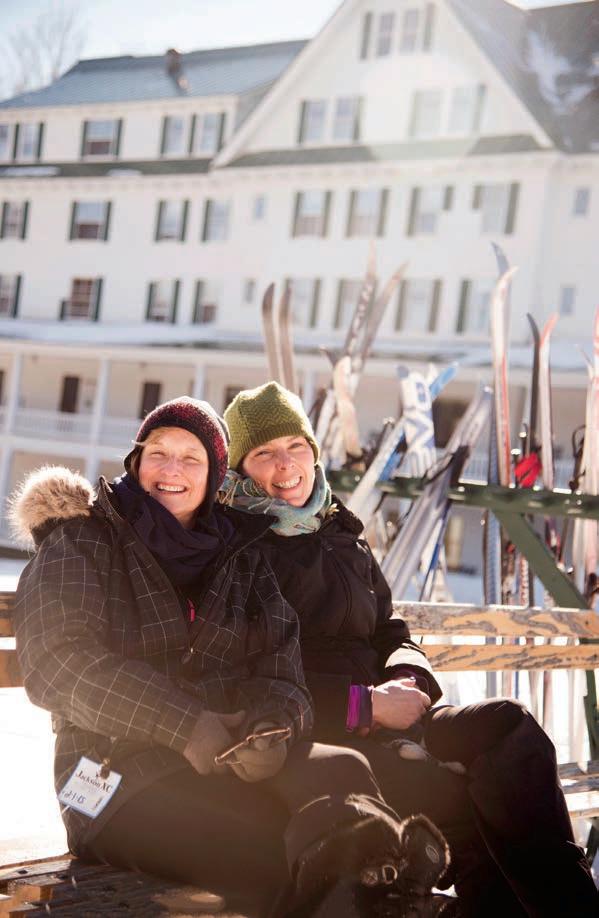
Endless shops, endless choices.
Bargain shoppers everywhere know all about the Settlers’ Green outlets in North Conway, but just down the road you’ll find a welcoming community for families offering every type of winter recreation. Step into the circa1874 North Conway train station and take an old-fashioned Conway Scenic Railroad jaunt. Or walk across the street to Zeb’s General Store to grab a bagful of candy and a soda from an original Coca-Cola fountain. Long a four-season tourist magnet and a hub for mountain adventurers, this town of under 2,500 residents has more than its share of inns, B&Bs, and nationalchain lodgings.
Rising above town are the 57 trails at Cranmore Mountain Resort , which in recent years has added a handful of other winter adventures to attract nonskiers. Get giddy on the Soaring Eagle zipline course, the amusement park–like Giant Swing, and the 10 lanes of tubing, especially fun under the night
lights. A 15-minute drive on Route 16 North and you’ll find Jackson’s extensive cross-country ski trails.
Back in North Conway, grab your skates and head to the outdoor rink at Schouler Park . Then check out the après-ski scene at Moat Mountain Smokehouse , known for its tasty wings, ribs, and microbrews on tap. Don’t forget to hit the L.L. Bean store, too. northconwaynh.com
The heart of the Mad River Valley.
Nothing seems to change here, and that’s the way locals like it, especially when it comes to their two ski areas, Mad River Glen and Sugarbush.
Mad River Glen is truly a place where skiing seems little removed from the mountain’s gnarled, primal state. It still relies almost entirely on Mother Nature’s snow and refuses to open its trails to snowboarders; it also boasts the only single chairlift in America. Sugarbush features the New England skiing of yore, a time when trails were cut by hand so they weren’t much wider than a hiking path. On the best trails, like Castlerock, you’re immersed in the
woods as you whiz by a rolling tapestry of maples, oaks, birches, spruce, pine, and balsams.
Add the 30 miles of trails at Ole’s Cross Country Center, set on a 1,500foot plateau that looks across at Sugarbush, plus one of the few round barns still in existence—now home to an indoor swimming pool at the aptly named Inn at Round Barn Farm —and you understand why we love Waitsfield. waitsfieldvt.us, madrivervalley.com

A vast wilderness around a cozy inn.
It’s a winter wonderland of spruces and pines top-heavy with snow and dotted with iced-over lakes and rising ridges. In winter this vast wilderness is yours to snowmobile, snowshoe, or ice-fish. Skiers are hopeful that Rangeley’s big-boy mountain, Saddleback , finds funding soon to stay open—but if not, famed Sugarloaf is only 26 miles north.
The grande dame of these woods, the Rangeley Inn , offers rooms yearround, just down the block from the heavenly chili found at Red Onion. You can walk the small town in minutes, or simply grab one of those cozy couches at the inn and while away the day with a good book. rangeleymaine.com
Best known for its picture-perfect harbor and historic windjammers, Camden casts a magic spell come winter. A stroll along the waterfront at Harbor Park is perfect at any time of the year. Then warm up in the adjacent Camden Public Library, another beauty, which originated in 1796 with a donation of 200 books (present building constructed in 1928).
n Stowe, Vermont
Stowe Craft & Design Center is like entering the studios of some of Vermont’s, and the country’s, best artisans.
n Bethel, Maine
For a unique look at the state’s dazzling mineral resources, the Maine Mineral & Gem Museum is nearing completion.
n Jackson, New Hampshire
The 16th Annual Snow Sculpting Competition takes place January 29–31, 2016. Jackson Art Studio & Gallery showcases the work of local artists and offers one-day “Sip & Paint” classes. Red Fox Bar & Grill is a family-friendly alternative to ski-lodge and inn dining.
n Woodstock, Vermont
Visit Sugarbush Farm to sample maple syrup and cheese and to learn how they’re made.
n North Conway, New Hampshire
The Mount Washington Observatory Weather Discovery Center brings the world of extreme events up close and personal, including a simulation of what it was like to live through a 231-mph wind.
Yet the most intriguing perk here come winter is that this is the only locale in America where you can ski downhill and peer out at an expanse of ocean. Who can resist the salty smell of the sea while riding the double chair to the top of Camden Snow Bowl ? One of the smallest peaks in New England, this ski area still has a mom-and-pop appeal, attracting many local families on the weekends. It’s also home to a 440-foot-long ice-coated toboggan chute, where a steep track lets toboggans drop off the side of Ragged Mountain at speeds exceeding 30 miles per hour (see “Up Close,” p. 29 in this issue, for more).
n Waitsfield, Vermont
Mad River Antler features works of art made from found (naturally shed) antlers. Artisans’ Gallery, also downtown, showcases the work of local artists.
n Rangeley, Maine
Visit an array of downtown shops featuring the works of local artisans. Restaurants offer a wide variety of options, from BBQ at The Shed to mild-mannered Gingerbread House.
n Camden, Maine
Ducktrap Bay Trading Company, a unique marine and wildlife art gallery, showcases the work of more than 200 local artists, from whimsical carved manatees to stately reproductions of America’s first sailing vessels.
n Middlebury, Vermont
The Middlebury College Museum of Art, open free to the public, draws exhibitions from around the world. Tour Middlebury’s six breweries, located along historic Otter Creek.
n Ludlow, Vermont
Green Mountain Sugar House produces and sells its own maple syrup and other maple items, alongside locally sourced cheeses and smoked meats, plus crafts and gifts.
—Heather TourgeeAfterwards, you’ve earned your cup of chowder at Cappy’s and a seat in front of a fireplace at one of the many inns that stay open year-round. camden maineexperience.com
A perfect college town.
Home to stately college-building façades, the circa-1827 Middlebury Inn , and memorable dining overlooking a waterfall at the Storm Café ,
Middlebury has a lot in common with Hanover, New Hampshire. After class, students at Middlebury and Dartmouth can carve perfect turns at those retro ski areas, the Middlebury Snow Bowl and the Dartmouth Skiway
The kicker for Middlebury is that less than a 15-minute drive away are the western slopes of Green Mountain National Forest , where you’ll find a classic cross-country skiing inn, Blueberry Hill . Grab your skis and snowshoes and head out on more than 50 kilometers of backcountry trails through snowed-over pines. Then return to the cozy lodge to fill up on sublime chocolate-chip cookies in front of the fireplace. experiencemiddle bury.com
The Mueller touch.
All writers are nostalgic, and since my children grew up skiing at Okemo Mountain Resort , I happen to adore Ludlow. I savor the salad bar at DJ’s Restaurant , the “Vermonter’s Omelette” (apple, bacon, and cheddar) at The Hatchery, and an après-ski Long Trail Limbo IPA on tap at that red barn known as Tom’s Loft Tavern
Ludlow’s enduring attraction stems from the fervent dedication of Okemo’s former owners and current managers, Diane and Tim Mueller. Year after year, they seem to unveil some new high-tech toy on the slopes, such as the resort’s mountain coaster, or its latest offering, an orange-colored bubble chairlift with heated seats. Plus, the Muellers’ finest achievement was launching the Jackson Gore Inn, easily one of the top three ski-in/ski-out properties in New England. yourplaceinvermont.com
A frequent contributor to this magazine, Steve Jermanok is one of America’s most prolific travel writers. His most recent story for Yankee was “Forgotten Islands,” an exploration of Boston Harbor Islands National Recreation Area (May/June 2015). activetravels.com

n the summer of 1959, an Associated Press reporter approached Neil Tillotson, the owner of The Balsams, a 19th-century grand resort in an unincorporated northern New Hampshire territory known as Dixville Notch, about the state’s upcoming presidential primary. For the past several election cycles, journalists had tripped over themselves as they traipsed around the state trying to nail down which community could claim first-to-vote status. Getting the news out wasn’t any easier. Few small towns had enough telephones for reporters to broadcast the results back to their papers. It was pandemonium, the AP man told Tillotson, and the media wanted clarity.
In The Balsams, a sprawling 232-room resort that basically is Dixville Notch, journalists had found the center point they were looking for. The hotel had space to accommodate them, only a handful of voting residents to wait for, and, because the property had its own telephone company, plenty of phones.
“If you’re interested in trying to be first at midnight to vote, we’ll cover it,” the journalist told Tillotson.
It was just the kind of prestigious anchor point Tillotson needed. For five long years he’d struggled to gain traction as a hotel owner. A native Vermonter and high-school dropout, Tillotson had made millions in the rubber business as the inventor of the latex glove and the party balloon. But in 1954, in “a fit of middle-aged sentimentality,” as he later said, the 56-year-old businessman had bought the resort because its property included land that his late grandmother, a fullblooded Abenaki Indian, had once lived on.
At the stroke of midnight, on March 8, 1960, Dixville’s five voters all cast their ballots for Richard M. Nixon. As he would do for the next four decades, Tillotson cast the first vote. Every four years after that, Dixville became the most talked-about small community in America. Reporters and politicians flocked to The Balsams like geese. Securing that first victory in the nation’s first primary was important. Or felt important, even if it meant getting a little silly.
In 1968 Michigan governor George Romney announced his candidacy for president on the resort’s grounds, then celebrated by hoisting his wife onto a 700-pound elephant named Popsicle. Senator Edward M. Kennedy surprised
DIXVILLE NOTCH
NH UNION LEADER & SUNDAY NEWS /UNIONLEADER.COM HART’S LOCATION MILLSFIELD
a couple getting married at the hotel with a bouquet of flowers in 1980. Eight years later, Alexander Haig arrived in Dixville by helicopter immediately after declaring his run for the White House. “As Dixville goes, so goes America,” he pronounced. Unfortunately for Haig, he was right. Dixville, and the Republican Party, opted for George H. W. Bush as their nominee.
By the 1990s, primary night at The Balsams packed all the splendor of an inauguration. Satellite trucks jammed the parking lot, while 100 journalists crowded outside the wood-paneled Ballot Room. The whole endeavor— the multihour run-up to the minutelong event, the international coverage, the grand showing of the final results
on a big white board, the party that followed—might have struck outsiders as more showbiz than democracy. But to those who were at the heart of it, it was something else entirely.
“Those few moments before midnight, when everyone is standing in their voting booths and everything is quiet, even though there are hundreds of people around you—the anticipation is extraordinary,” says Steve
Barba, The Balsams’ former president and managing partner, who for more than 40 years managed the hotel’s midnight voting. “Here’s a little town in America conducting its own elections to choose the person who’s going to be the most powerful person in the world. Without armed guards, without foreign observers, and doing it to the letter of the law. It was hard not to feel pride and patriotism.”
But Dixville hasn’t always had a monopoly on midnight voting. With The Balsams now shuttered and in the early stages of an expansive renovation, its midnight voting has moved to the nearby Hale House, the former private home of one of the hotel’s early owners. The property’s current owner, developer Les Otten, is determined to keep the tradition going—but as New Hampshire gears up to celebrate the primary’s centennial, other communities hope to grab a little of that Dixville spotlight.
As he’s prone to do, Wayne Urso is making a point. Interspersed in his storytelling is a hearty laugh that resembles a wheeze, as though he’s desperate for air. It’s a late-July day, and Urso, a 59-yearold retired computer scientist, has slowed his Volkswagen Passat to a stop near the Sweatt pig farm on Route 26 in Millsfield, New Hampshire.
For Millsfield, New Hampshire, the town’s scheduled midnight voting, last done in 1952, is a little bit of both. “[In Dixville] there’s a history you can see and touch,” says Wayne Urso, a local selectman, photographed here at the Log Haven Restaurant & Lounge, where the community’s voting will take place. “This time around we’re trying to leave some history behind.”

“We’d gather in Etta’s kitchen, she’d bring out a plate of chocolate-chip cookies, and then we’d take turns filling out our ballots on her washing machine.”
Following
“This is where we used to vote,” he says, pointing to a large white farmhouse. “We’d gather in Etta’s kitchen, she’d bring out a plate of chocolatechip cookies, and then we’d take turns filling out our ballots on her washing machine.”
The informality of the whole event was possible because there were only 20 or so voters, and Etta’s kitchen was the closest thing that Millsfield, an un incorporated area 12 miles south of Dixville Notch, had to a town hall.

“And that’s how we did it, and everyone was fine with it,” Urso says, picking up his story. “But what they need in a place like Concord or Manchester isn’t really needed in a place like Millsfield. And one day a state poll inspector comes and starts taking measurements in the drive for handicapped parking. There wasn’t enough space.
“Then he walked into Etta’s home and asked to see where people voted, and she pointed to the washing machine. ‘You can’t vote there,’ he said. ‘There’s not enough space.’ So Etta said we could do it in her bathroom. Out came the tape measure again, and like before, the inspector said it wasn’t up to code. I thought Etta was going to lose it: ‘Not enough space for a wheelchair!’”
Here, Urso lets out a big laugh. “Now, the only person in town who was handicapped was Etta herself. She glared at him. ‘You think I can’t get into my own bathroom!’ she yelled.”
Urso, who’s stocky, with a sweep of thinning salt-and-pepper hair, speaks in the enthusiastic tones of a man accustomed to crossing the finish line of whatever project he’s taken on. A Millsfield selectman and the closest thing his community has to a local historian, Urso is conveying the tale about Etta’s polling station as part of the larger story of Millsfield’s voting history. It’s one that includes a curious twist: In the 1952 presidential general election, the
community’s seven registered voters turned out to the home of Genevieve Annis, and at midnight, under kerosene lamps, cast their ballots.
Little is known about how Millsfield’s midnight voting came to be, or why it stopped. Its only documentation comes from a 1952 Time magazine piece that came out shortly after the election. It’s one of the reasons why Urso has spent the past two years spearheading a return to midnight voting.
“Dixville has the Ballot Room and the voting booths,” Urso says. “There’s a history you can see and touch. There’s nothing here. We just know it was done. And unless you point to the Time article, nobody believes you. This time around, we’re trying to leave some history behind.”
But in reaching back for that history, Millsfield has had to step into a 21st century far removed from those early, simpler days in Etta’s kitchen. The town has had to build actual voting booths. A TTY line for the hearingimpaired has been installed, even though none of Millsfield’s residents is deaf. So has a handicapped-accessible voting station, just in case it’s needed. There’s also the matter of the crush of press Urso is bracing for.
During his tour of the town, Urso pays a visit to the Log Haven Restaurant & Lounge. For a one-road community, Log Haven is a surprisingly large place, with high, wood-paneled walls that give it all the ambience of a
(continued on p. 132)

WHEN YOU FALL INTO A FREEZING MAINE RIVER, THE WILL TO LIVE CAN BE MEASURED BY THE NEED TO SAVE ONE YOU LOVE.
 BY ELIZABETH COOKE
ILLUSTRATION BY JON KRAUSE
BY ELIZABETH COOKE
ILLUSTRATION BY JON KRAUSE
f you fall into a river after a flood, when slabs of ice cover the banks, and if the water is up to your chin and you look up at those three feet of ice slabs, you know, because your mind tells you, that you can’t possibly climb out of the water, that you might die.
Within two minutes, when you lift your gloved, numb hand from the water and an excruciating pain makes your fingers want to break off, you stare at your hand as if it belonged to someone else, and then you pull it back into the water. It’s better in the water.
Maybe the sun is out and the air is unseasonably warm, but the water, you remember, is as frigid as floating, watery ice. Yet you’re not cold.
It was another of those rare mild January days in Maine’s western mountains, and a friend had stopped by, saying, “Get the kids outside; it’s warm.”
day when nothing could possibly hurt them, were suddenly on the ice. “Off!” I yelled. “Now get back!” As they scrambled off the ice and through the snow to the almost-bare ground, I caught a glimpse of a black tail down below the ice, in the fast-running waters of the Sandy.
Lying flat on my belly on a slippery ice slab, I gazed in shock three feet down at the river. Gus’s eyes, as he swam back and forth looking for a way out, showed primal fear.
I couldn’t reach him; he wouldn’t come to my hand. “Come here, little guy,” I called. “Gussy, come, come here.”
Back and forth he swam, but now he was whimpering. One swoop close by and I had his collar, but he pulled away. “No, Gus, come, come here.” Then he was off again.
I saw a tiny outcropping of ice, maybe three inches, sticking out of the
A blanket of cold wound around me then, right up to my neck. I was breathing hard, but I, the person I was, had gone away. There was only Gus. “Keep trying,” I begged him. “Get those paws up, and I’ll push.” With the stumps that my hands and arms had become, I kept pushing, but Gus didn’t budge. Where was my strength?
My feet rested on an icy rock. When the current pulled me off, I had to move my arms to keep my head above water. Then came the rearranging, again, of Gus. “It’s, okay, Gus, just keep trying.” I must have been speaking to myself, for Gus could try no longer. He held on out of terror, but he couldn’t try.
When the current pulled me away, floating me downriver for several seconds, a blissful peace overcame me. I was going, I realized. I was dying. The river would be my home. “I’m coming, Penny,” I whispered to my dear friend, gone now these two years.
The Sandy River, I thought. I’d been wanting to get down there for two days, after the rains had come, and the river had flooded, breaking up the ice, which had resettled on the banks. The sky was as blue as my great-grandmother’s eyes and the air almost balmy, as my mother would have called it, when my daughter Ting, her friend, and I headed down the little streets of Phillips to the orange gate. Gus, my Lab, stepped happily ahead of us, his thick black coat glistening like onyx, his tail raised and wagging.
Three of Ting’s third-grade classmates had joined us, so with five kids in tow, I gave them the “This is the deal” talk at the gate: “No one goes past the end of the trail, and no one goes on the ice along the banks. Understand?” I looked each one of them in the eye for emphasis.
But kids, being kids on a blue-sky
slabs about halfway down, so I shifted over to it. Sitting up, I removed my boot and sock, yanked one leg of my corduroy pants as high as it would go, and gingerly tested the water’s depth. If I could stand … but no, I couldn’t touch bottom at a spot that in summer is the gentle slope of a beach leading to briskly cool water.
Gus was crying now, looking wildly in every direction.
I turned to the kids: “Run for help, now! Get Larry—he’s working at Skip’s and can bring his truck to the gate. Fast!”
One child stayed, at my request. “Just in case,” I said. I didn’t know what the “just in case” might be, but within a minute I fell into the river and found out. The child cried out, “I’m scared.” Already in shock, I tried to calm him: “I’m not scared—don’t you be scared. Be brave. Just run. Get help.”
But my ears caught that crying sound again. Gus, it was Gus, and he needed me. I was swimming back against the current, but so slowly. I was a swimmer, but why couldn’t I go any faster? “Gus,” I was crying, “hold on!” Then, as I reached him, “Help!” came from deep within. “Someone, anyone, help, help me!”
Once, I lifted my gloved hand out of the water, and a bitter pain turned my fingers to glass. Would they break off? Back in the water. I held Gus’s back legs and tried to support as much of him as I could with my shoulder.
Above us loomed the wall of ice.
Then Melissa came. Small Melissa, but she had worked in construction, and when she saw me, something pumped through her, some inner reserve of strength. I could see it. She found her footing on the slanted ice slabs, yelled at the kids to stay back, and in one swoop
WHEN THE CURRENT PULLED ME AWAY, FLOATING ME DOWNRIVER FOR SEVERAL SECONDS, A BLISSFUL PEACE OVERCAME ME. I WAS GOING, I REALIZED. I WAS DYING. THE RIVER WOULD BE MY HOME.
pulled Gus out. To the kids, “Get Gus to the car, now, and fast!”
“Go, Gus,” I whispered, thinking that I was starting to sink.
“Give me your hand,” Melissa was saying.
I did, and she yanked. Melissa’s legs fell through the crusty snow as she dragged me out and onto an ice slab. “I can’t move,” I said. Melissa was pulling herself out of the snow; her legs were soaked with river water. Somehow she stood me up and ripped off my down jacket and turtleneck, then wrapped me in her own jacket.

The shivering and shaking took over then, but Melissa’s hand gripped my waist as she pushed me forward for 20 or more steps. The gate was so far away, though. I bent, nauseated, too weak to go on. “I can’t do it,” I told her. Melissa scooped me up into her arms.
When they slid me into the waiting ambulance—Ting and her friend had found someone finally and told him to call 911—I was crying. “Where’s Ting? And Gus? Where is he?” Even, “I want my mother.”
“What’s her number?” asked the EMT, a woman named Jane, with a golden halo of hair around her head. She was cutting my clothes off.
“Please, not those corduroy pants— my daughter-in-law gave them to me—I need them,” I told her, so Jane, my angel, pulled them off.
“What’s your mother’s number?” she asked again.
“She’s dead. I can’t call her.”
I was still in the water, wasn’t I? The shivering hadn’t let up; the feeling that I didn’t exist kept on. I was being wrapped in warm white blankets, even my head. I was swaying and trembling and crying for the ones who’d already gone, for wanting to see my three children and my two grandbabies. Why couldn’t they be here? Why couldn’t Ting come with me in the ambulance? “Where’s Gus?”
Jane placed her hand on mine, beneath the blanket. “Maybe you can feel your mother through my hand.” The first moment of calm began.
“Body temp is 91,” I heard.
“Can’t get an EKG—she’s trembling too much.”
“Blood pressure?”
I saw a thumb turn down.
The doors closed, and we were off to the hospital. Another ambulance would meet us partway with a medic who
“The water saved me,” I finally said.
In the trauma room, following injections of blood thinners, needles to draw blood, needles to transfer fluids into me, I began to feel myself again. Two heads poked in: my buddies, who’d seen me through the last couple of years,
I was covered with a papery white blanket with holes on one side that blew warm air all over me. The doctor waved
“We’d like to admit you,” he told me. “Your heart’s still giving off enzymes. That means you’re not out of the woods yet. Cardiac arrest can occur at a certain point. You’re quite near that.”
As I was lifted onto a stretcher, I heard Skip say, “I’ll go out to Phillips and get Ting, bring her in to be with you.”
“Oh, thank you. And Gus?”
“He’s just fine.” It was Larry saying those words; Gus loved Larry, so I knew it was true.
“Did I tell you the water saved me? It was a blanket.”
Then Ting was there, snuggled up against me in her pjs. “Are you going to die?” she asked.
“You’re holding me so tight, I can’t possibly die,” I said.
It was after 8:00; the dark night protected us. The nurses had closed the door so that the only light came through the curtained window to the nurses’ station. “Mama, sing to me,” Ting said.
I was past exhaustion, but I started to sing the lullabies and songs I’d sung to her when she first came from China to join my family when she was 2 years old. At times I’d start to drop off to sleep. “Keep singing,” Ting told me. She joined me. At some point, near midnight, we fell asleep in each other’s arms, her heart against mine.
Like the seven generations of Wilkins men before him, Tom Wilkins has found his calling in working hard and close to the land. “I met him when he was 15,” says his wife, Sally, “and he knew then that he was going to work at the mill.”

he frigid early-February morning isn’t doing Tom Wilkins any favors. “Nothin’ wants to start,” he grumbles as he stares at his front loader, a yellow Volvo tractor that’s parked in front of a stack of recently planed 10-foot boards at his sawmill in Milford, New Hampshire. The air packs a hard, stinging bite, and across the yard towering piles of logs, long rows of boards, and pyramids of bark mulch are locked down with a thick crust of a winter that on this —10° day shows no signs of relinquishing its grip.

“It’s gotta be the coldest day so far,” Wilkins says in a low, gravelly voice that resembles the rumble of the diesel engine he’s trying to fire up. Dressed in black Sorels, long underwear, a thick flannel shirt, overalls, and a brown knit cap under which he tucks his graying ponytail, Wilkins has already developed a pretty good frost on his beard. His eyes stay fixed on the loader for a few more long seconds, as though he’s trying to will it to life.
“All right,” he says, then folds his 6-foot-4-inch frame into the cab to crank the engine one more time. He presses his body against the steering
ago, and he speaks in passionate tones about the satisfaction that comes from maximizing the board feet out of a single log, or producing a stack of finished lumber. Get him going and he might tell you about the best band saw he ever encountered. (“Dick Marble’s in Hollis—he knew how to saw real lumber.”) Or the peace he’s found being at the mill on his own, working the planer deep into a muggy, star-filled August night to churn out finished floorboards and trim.
For more than two centuries, Wilkins lumber has built barns and homes, redone kitchens, and framed additions. Drive down nearly any residential road in
during the school year. On those weekend days, after the mill closed, grandson and grandfather continued their work by walking the family land, doublechecking property markers and pruning hemlock. The woods packed stories, and Harold knew many of them. He pointed out the old cellar holes and reminisced about the big spruce that had once prevailed. The work, the way of life, the chance to be outside, catered perfectly to Tom Wilkins, who later built much of his vacation time around hiking 14,000-foot mountains out West. At the insistence of his grandfather, Wilkins went to college and earned a business
wheel and turns the key. It spins hard and then belches several coughs before finally, reluctantly, sputtering to life. Wilkins lets the loader idle for several minutes, then drives it 50 yards and parks it next to a blue Chevy pickup with 130,000 miles on the motor and a scattering of bumper stickers with messages like “No Farms No Food” and “Proud Parent of a U.S. Marine.” He links the two vehicles with a set of jumper cables and begins the ritual all over again.
On it goes like this for the next half-hour. The planer mill. The office. Another loader. A slow slumber and then life. As he works, Wilkins moves with the kind of purpose and efficiency of a man who’s done this sort of thing thousands of times.
Which, of course, he has.
Every so often the question comes up: You think you’d like to do anything else with your life? Tom Wilkins might pause, as though he’s truly contemplating the question, before shaking his head and smiling. “Nah,” he’ll say. “I’ve got sawdust in my veins.”
Wilkins packs a reverence for his work and for the sawmill like that of an artist speaking about his craft. His small family sawmill still uses the same kind of machinery it did half a century
least one property that was built using Wilkins boards. In some areas, whole neighborhoods bear the stuff.
Lumber has sustained eight generations of Wilkins’ family: men who found their calling in working hard and close to the land. When Wilkins was born in 1959, the family business was part of a thriving group of southern New Hampshire lumberyards that were turning out local boards for local builders. By then, Tom’s grand father, Harold Wilkins, a kind man with a penchant for storytelling, was overseeing the operation.

Wilkins started working for his granddad when he was 12. He sorted boards, delivered stock to the lumberyard, did cleanup, whatever low-level tasks Harold needed. He worked fulltime in the summer and on Saturdays
degree from Bentley University in Waltham, Massachusetts. But as soon as he could, he returned to New Hampshire and began working at the mill for $160 a week.
“I met him when he was 15,” Wilkins’ wife, Sally, said, “and he knew then that he was going to come back home and go to work at the mill.”
The couple married in 1981 and settled on a remote piece of family property in Amherst that Harold had given them as a wedding present. They built a house, raised five kids, and started a small farm. After Harold slowed, Wilkins took over running the mill. When his kids needed to see him, they cut along the short forest path that runs between their home and the sawmill. Everything the Wilkinses did, how they lived, how they worked, emanated from the land they owned. And in increasingly upscale Amherst, home to a booming community of Boston commuters with big new houses, they stood apart.
“I had friends who lived in Bedford on a hill in mansions with giant swimming pools,” says Tom and Sally’s daughter Rachel. “It was a little embarrassing, because in school we’d actually go on field trips to our house to see our farm animals.” She laughs. “I think in winter we were the only kids in school
who didn’t want snow days, because that meant we’d have to stay home and work.”
Wilkins knows he’s an anomaly. Gone are the sawmills and so many of the farms that once dotted Amherst’s landscape. Fields and meadows have given way to house lots and commercial development. Around the mill is a community more accustomed to commuting and the quiet hum of computers and air conditioners than to the whirling buzz of big planers and giant saws.
It’s one of the reasons why two years ago Wilkins and his wife put much of the family land, more than 500 acres,
when he could shut the mill down, to have the surgery. “I just don’t get as much done during the day as I used to,” he says.
It’s made him wonder about his future and the mill’s. None of his kids wants to take it over. He wishes it weren’t so, but he also hasn’t pressed the issue. It’s a way of life that can’t be pushed. If you don’t love it, he says, there’s no way you’ll survive it. And that passion becomes an emergency resource to draw on when the temperature dips below zero and you’re working outside all day.
At a little before 7:00 a.m., most of Wilkins’ five-man crew have filed into
He knows that the legacy of the mill includes more than just his bloodline.
While John Pasquariello, who handles deliveries, talks about the winter triathlon he recently completed, Wilkins receives a text from his debarker, Bill Jones. He’s running late. “Looks like his dogs crapped all over the place and he had to clean up,” Wilkins says, smiling, as the room erupts in laughter.
Ten minutes later, Jones sheepishly comes through the door and absorbs a few jabs, before talk turns to the weather and the day at hand. The inventory is low on 10-footers, and there’s also the matter of the 4,000 hemlock posts the
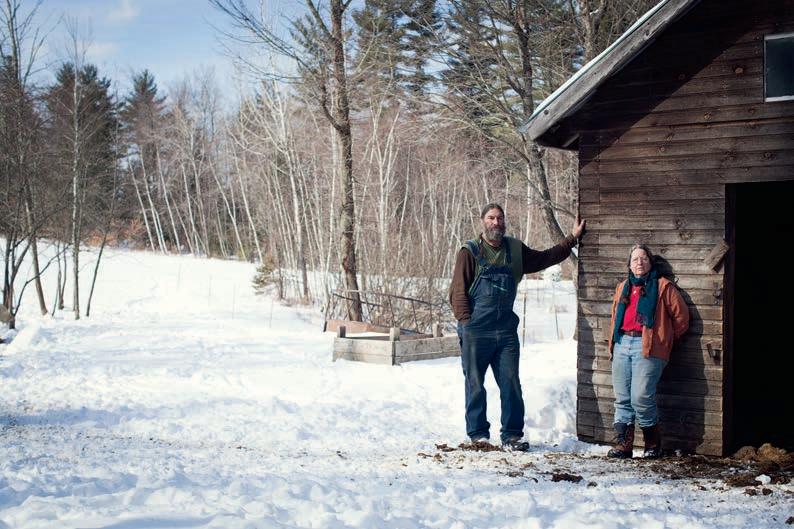
into conservation. Selling it to a developer would have given them a couple million dollars and eased the financial burdens they’ve had to stare down over these past few years. But in doing so, the Wilkinses knew that the area would lose something it would never get back.
“There just aren’t that many places around here where you can get out and not see a house,” Sally says. “Where you can just look up at a dark sky.”
It was a stark reminder that not all property is valued by how many house lots can be squeezed into it. For Tom Wilkins, that outweighed the stress of wondering whether he could retire or how he could keep the family sawmill going when so many others have closed.
“People think we live in the country,” Wilkins says. “This isn’t the country. This is suburbia. We’re just bedroom communities, and the problem is, this is physical labor. These days, you can go to Walmart and get a job for not a whole lot less money than what you can make here. Plus, you’re inside—you don’t have to worry about freezing on a cold day.”
Wilkins feels that. At 55, with one knee replacement on the books and another one needed, he’s weathering the effects of four decades of hard labor. He still puts in regular 14-hour days, but his body has lost a step; ailments crop up more often. Last summer he gutted out three hernias, waiting until Christmas,
the mill’s small office, where a big framed picture of Harold Wilkins hangs on the wall and a dusty, 10-year-old computer is shoved in the corner. Nearby, a small notebook and pen, the preferred tools for recording orders, sit by the phone.
In this room, at this hour, the men talk like old friends. Many of them have worked here for decades. The mill’s sawyer, Dennis Cluche, a soft-spoken man with a thick white goatee, started in 1969. His brother, Chris, came on a few years after that. For Tom Wilkins, any talk about the mill’s future invariably includes these guys. He’s loyal to them, to the life they’ve carved out for themselves by working for his family’s business.
sawmill has been hired to make for a dredging project in Massachusetts.
“I’ll make sure I chip snow off the stack of 12-footers,” Wilkins says. “I keep meaning to do that, but every time I try, something else comes up.”
When the workloads have been sorted out, the guys trickle out of the warm office, toward the lumber and the machinery. “Back to the planer mill,” Wilkins says, pushing the door open. He steps out, where Pasquariello is looking around the yard. A blue sky is emerging. “It’s starting to warm up,” he says. Wilkins arches his eyebrows as if to say, Maybe. Then he heads to the planer. The mill is now open. A day’s work lies ahead.
When the cold settles on Prudence Island in the middle of Rhode Island’s Narragansett Bay, the 150 year-round residents notice a special quality of light they call “winter blue” reflecting off the water. Photographer Ron Cowie found a place of self-sufficient people with deep roots, a place where he felt “time has a different sensibility.”
Photographs by Ron Cowie

Photographer Ron Cowie arrived for the first time on a late January morning just past 6:00 a.m. “I had just gotten off the ferry,” he remembers.
“And it was so cold, so quiet.
I didn’t want to photograph any clichés, and I know a lighthouse is a cliché, but the blue-green light was all here.” Prudence Island Light, known to islanders as Sandy Point Light, is the site of the island’s great tragedy. During the Hurricane of 1938, the lighthouse keeper’s cottage was swept into the sea, taking the lives of the keeper’s wife and son, a former keeper, and an island couple who had sought safety there. |

ast winter had already settled in hard, more bitter than most people could recall, when photographer Ron Cowie first stepped off the ferry onto the landing at Prudence Island. Though Cowie had lived only 40 miles away in Charlestown, Rhode Island, for a decade, the island, which is part of Portsmouth and sits smack in the heart of Narragansett Bay, remained one of those mysterious, all-but-hidden places that you mean to go see one day, maybe. That day for Cowie came on the last day of January, and the cold that ripped through his clothes gave him the gift of crystalline light when the sun rose over the bay. He returned three times, recording the way winter lay on the land, and its 150 year-round islanders.
“My first goal was to arrive with no impressions,” he said. “I wanted no preconceived ideas.” He came wanting to have what he called “a conversation with the island” through the lens of his camera. On foot and by car, he covered almost every inch of the landscape, roughly seven miles long and two miles wide, sometimes spending hours with no other people in sight, only flocks of seabirds or geese. On an island that even in the height of summer is known for its sense of solitude and quiet, the winter silence became his constant companion.
“It’s very peaceful,” Cowie said. “But it’s also very stark. A lot is untouched. I wanted to see how to turn what may seem to some like bleak isolation into a positive. What I found was that there is a collective knowledge, a rhythm they’ve built their life around; a sense of history that connects them. There was no sense of a ‘We’ve got to put Prudence Island on the map’ mentality. The people who’ve come before them, they seem to still be there. It’s a living work of art.”
One day Cowie met Joe Bains, who, like many islanders, has a split life, keeping a home on the mainland, keeping a home and his heart on the island, where his roots burrow deep. His grandparents first came in the late 19th century, when the island had a thriving summer colony. His parents met on Prudence and moved back there shortly after World War II. His father, like many, was a jack of all trades. He hauled trash, did carpentry, built and painted houses. Joe went to the one-room school, and soaked up the island’s history and lore.
“When I was a kid,” Bains said, describing in a few words the world-apart feel of Prudence Island, “you just had to be tall enough for your feet to hit the pedals and you could see over the steering wheel to drive, that’s all. I was 12 when I started driving, and my summer job from then on was driving my father’s trash truck.”
On an early March afternoon, Cowie put away his camera and boarded the last ferry back to Bristol. “That last hour before getting on the last ferry back, I had a sense of completion. I had wanted to have a conversation with the island, and I got that.” — Mel
 Allen
Allen
Ethan Rossi, one of the owners of Prudence and Bay Islands Transport, steers the M/V Herbert C. Bonner on its early-morning trip from Bristol to Prudence Island, about two miles away in the heart of Narragansett Bay. Cowie heard stories of how the “temperamental” previous ferry operator would sometimes leave without you if he didn’t get along with you.


ABOVE : Flocks of Canada geese, brants, and black ducks winter on the island, only two miles from the mainland but a natural world unto itself. The Audubon Society of Rhode Island is offering a “Winter Wildlife” tour of Prudence on January 9 this year (details on p. 127).

RIGHT: During World War II, the southern end of Prudence Island was the site of a major naval munitions depot, where more than 30 storage bunkers were packed with ammunition ready for loading onto ships. More than 20 of the bunkers remained active until 1973. Today it’s conservation land, part of the Narragansett Bay National Estuarine Research Reserve, attracting hikers, mountain bikers, birdwatchers, and wildlife.

“I wanted to have a conversation with the island.”
LEFT: Prudence’s population swells to nearly 1,000 in summer when people return to their island getaways, like this trailer on Narragansett Avenue, awaiting its owners.
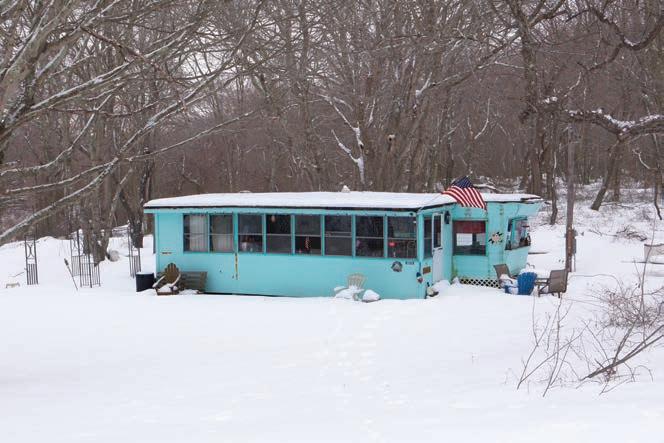
BELOW : Narragansett Avenue, flanked by the East Passage, is lined with the modest homes and cottages that give the island a feel far different from summer island communities elsewhere. The island’s main route leads to the former naval munitions storage site, now in land conservation. Looking south is the Portsmouth shoreline. “My first impression when I arrived,” Cowie says, “was ‘There’s nobody here.’”

LEFT: Few people know the island’s history, geography, and stories as well as Joe Bains, pictured here at his home with his mandolin. His grandfather came to Prudence Island in the late 19th century; his parents met on the island and moved here full-time in 1948. “When my father built his house,” said Bains, who was raised and educated on the island, “every bit of siding came from used Navy ammunition boxes, and the posts and beams came from abandoned Navy buildings.”


MIDDLE : The Prudence Island school, built in 1896, is the last one-room schoolhouse in Rhode Island. While some older children take the early ferry to Bristol and then a bus to Portsmouth schools, others cluster together here. Islanders fought to keep it open when Portsmouth wanted to close it in 2009. Today the school has six students in K–12; Portsmouth pays K–3 costs, and island fundraising pays all other costs through the Prudence Island School Foundation.

BOTTOM : Fifth-grader Raya Young’s father is the island’s police officer. With no schoolbus, children walk to school or ride with parents.

Marcy Dunbar, a lifelong islander, graduated from the one-room school and sent her six children there, as well. Her house is about a quarter-mile from the ferry landing, and until her late eighties, she was both postmistress and operator of the variety store, which islanders called “Marcy’s.” Now her daughter Lori has replaced her, and the store is known as “Lori’s.” In 2009, an island visitor blogged about the store experience: “It’s just a small place, sort of messy, dark, unorganized, with Marcy scooting back and forth from the post office to the store, lost in her own world. You patiently wait for her, because you’re definitely on island time once you go through that door. But then that’s a big part of the charm and appeal. It’s easy to imagine the store looking and operating exactly the same way many, many years ago.”

TOP LEFT: With nearly 75 percent of island land preserved, Prudence seems to breathe quiet. “If you go off the path anywhere, you’re immediately in brambles,” Cowie observes. “It’s very peaceful, and stark. A lot is untouched. It’s not like they’re living in the past. But time has a different sensibility. So much history here. Almost like events happened just yesterday.” The stone wall indicates where an old cow path ran through.




OPPOSITE, MIDDLE : The remains of a World War II construction wharf speak to Cowie’s sense that time takes on a different feeling here. On an island devoid of most expected conveniences, what remains is this: quiet, beauty, a place to totally unwind.
OPPOSITE, BOTTOM : As Cowie traveled across the island, his eye was drawn to details like these deer skulls lying in an islander’s yard. “I saw a touch of reality in the antlers,” he said. The proliferation of deer has
been a long-running problem, since deer ticks feed off the herd. The herd has been thinned in recent years by hunting, the surprise arrival of coyotes, and last winter’s harsh mix of snow and cold.
THIS PAGE, ABOVE : Vestiges of a past when Prudence Island boasted a lively summer colony are spread across the landscape. Here all that remains of the former yacht club, which dated from 1904, is a towering chimney near Potter Cove.

“It’s very peaceful, and stark. A lot is untouched. It’s not like they’re living in the past. But time has a different sensibility. So much history here. Almost like events happened just yesterday.”
HERE’S THE DILEMMA: NEW ENGLAND NEEDS ENERGY, POTENTIAL ENVIRONMENTAL DAMAGE, AND PUBLIC ANGER.

BUT EVERY PROPOSED SOLUTION COMES WITH RISK, FIRST IN A TWO-PART SERIES. BY HOWARD MANSFIELD

New Englanders, you stand accused: You’re not easy. You have a lot of ideas about how your countryside and your towns should look. You don’t want pipelines, windmills, or big power plants. “It’s virtually impossible to build anything in New England,” one energy analyst says, “because transmission lines are hard to site, gas pipelines are hard to site, and wind farms—God forbid.”
And, Big Utilities, you also stand accused. You don’t reveal your plans until they’re already well developed. “We know we need energy if we want to keep the lights on,” says the head of one conservation land trust. “What we’re saying is: Don’t impose a solution on us that doesn’t allow us to be a part of the process.”
Take these two comments as shorthand for the battles being fought all over New England: in New Hampshire’s North Country about Hydro-Québec |and Northeast Utilities’ proposed Northern Pass, a 192-mile-long highvoltage transmission line; on ridgelines in Vermont, New Hampshire, and Maine over windmills; and in Connecticut, Massachusetts, New Hampshire, and Maine about building new naturalgas lines or expanding old pipelines.
For the last year and a half I’ve been following one of these energy battles, a natural-gas pipeline that at first was routed through Massachusetts, and then leapt the state line, for part of its journey, into New Hampshire. The proposed pipeline’s arrival in town was met by a civic version of the stages of grieving: disbelief, anger, organizing. I’ve sat at kitchen tables with anguished families as they talked one minute of a beloved old tree and the next of the Constitution. I’ve sat late into the night at formal federal meetings, as speaker after speaker tried everything to drive off what they perceived to be the monster at the city gates: reasoned, factual testimony; fiery Patrick Henry oration; and the sending forth of eloquent children to speak for the earth.
At one meeting, a woman, her voice quavering, got down on her knees and
begged for her home, her deck where her family loved to play cribbage, and her 22 acres with its woodlands, fish pond, stream, and a night sky “so dark you can see the Milky Way in all its brilliant clarity.”
“Our home life is simple, but it is awesome, and it is our American Dream come true,” she said. But a letter with a map had arrived in the mail; their home would be just 1,500 feet from a compressor station. “Our home has been effectively condemned … I’m begging you,” she said, falling to her knees. “I’m begging you.”
This isn’t just her problem, or that of all the towns along the route. We’re all facing serious choices that will determine how we produce electricity for years to come. The debates are accompanied by a blizzard of statistics, a complex path through the government’s regulatory agencies, and a mismatch between big corporations, with their legion of experts, and the hastily formed battalions of citizen-activists, who are rapidly educating themselves. These fights with their contending forecasts and solutions are hard to judge and harder than ever to present in an era of twitchy attention.
The utilities have the advantage. They set these projects in motion;
these things are years in the planning. They can easily afford the studies and lawyers. They’re poised to answer the technical questions. The process relies heavily on their information. Activists fight to confront the planners’ assumptions: If the overall demand for electricity is stagnant, why build this project? What about alternatives that reduce demand during peak hours?
Beyond the technical debate is a question that cuts to the most essential issue. The project proponents ask: How are we going to get anything built? If not here, where? If not now, when? But that question ignores one of the bedrock questions of the republic’s founding: What’s the greatest good for the greatest number of people? And who gets a say in that decision? In short: Who sacrifices? Who benefits? Who decides? That’s what the first of this two-part series on New England’s energy landscape will explore.
Most people don’t go seeking these problems; most people are recruited. Being thrust suddenly into the heart of the debate usually starts with a stranger at the door. That’s how it began for Vince and Denene Premus, back in the winter of 2014, much as it continues to happen in towns small and big across the region.
One morning in January, two years ago, Vince Premus was leaving for work when he met a man in the driveway of his home in Pepperell, Massachusetts. Did Vince have a minute? There was something he wanted to discuss.
He laid out a map on the hood of his car and made it seem like a routine matter: A 36-inch-diameter, highpressure, natural-gas pipeline would be going right here, crossing the Premuses’ small field, right where Vince, his wife Denene, and their two children play soccer and lacrosse and fly kites. It’s where they’ve held Halloween-party sack races for 50 children. “It’s a wonderful place to be outside,” Vince told me. “In the fall it’s incredible how beautiful it is.” The pipeline would flow 200 feet from their house.
The company representative wanted Vince to sign permission to survey his land or, failing that, to sign a form saying that he didn’t give permission. Vince refused. He was late for work (he’s an engineer studying ocean acoustics), but he detoured to the Pepperell town hall to find out what was going on.
Town officials didn’t know much more than he did: just that Kinder Morgan, North America’s largest energy infrastructure company, based in Houston, Texas, wanted to build a natural-gas pipeline called Northeast Energy Direct across New York State and then 180 miles across northern Massa chusetts. This scene was playing out in town after town: a stranger knocking, saying something about a pipeline, rumors and questions all over town.
It seemed unreal to Vince and Denene. How could some Texas company lay claim to their land and, as they saw it, threaten their safety? Since 2003 there have been more than 20 serious accidents, including fires and explosions, on Kinder Morgan’s pipelines. Kinder Morgan counters, saying that it “consistently outperforms the industry averages in virtually all environmental, health and safety measures.” But “industry averages” can be discomfiting. On other companies’ pipelines, three major accidents in the last five
years have killed eight people, injured more than 50, destroyed 41 houses, and damaged many others.
In April the Premuses received a letter with a brace of legal citations stating that they couldn’t refuse, that Kinder Morgan could survey their land anyway. “It was pretty aggressive,” Vince said. “It’s when we knew we were really into something.”
And that was for openers: If the pipeline won federal approval, Kinder Morgan could take the Premuses’ land by eminent domain. Almost all pipelines are approved by the Fed -
eral Energy Regulatory Commission (FERC), according to one independent nonprofit that monitors pipeline safety. And further, the Premuses and everyone else plugged into a utility in New England would pay for the pipeline’s construction with a “tariff” added to the utility bills of everyone in New England.
After that January morning, the pipeline wedged itself into the Premuses’ life. They studied energy policy, organized their neighbors, picketed in front of the State House. The pipeline became their unpaid job. They attended

countless meetings. Denene addressed so many letters to legislators that her son memorized their names—he helped her address the envelopes. She wanted her children to see that “you have a voice as well as a vote.”
When I visited, Denene and Vince brought out papers and files, which Vince had stacked as neatly as a deck of cards. The pipeline had put part of their life on hold. Their home is a big, welcoming farmhouse built in 1730, decorated with Denene’s quilts, appliqué, stenciling, and a few Shaker reproductions. It’s an airy, cheery household. When they first saw the house, it reminded them of their country roots in New Hampshire. When I met them 15 years later, Denene said that the way she felt about their home was like grieving: “It’s amazing how life was going along until we got this knock at the door.”
At pipeline meetings, I met many people who are united by the same story. The pipeline has become the immovable object against which they throw letter after letter, emails, phone calls, meetings, rallies. It upends normal life. They stay up late at their computers taking a
crash course on energy policy. The rest of us, obliviously turning on our lights, knowing little of how electricity gets to us, are in the dark.
One day you’re taking your son to Cub Scouts, commuting to work,
If Kinder Morgan’s pipeline has been sketched across the map of your town, sooner or later you’ll meet Allen Fore, the company’s vice president for public affairs and its public face for the pipeline in New England.
Fore is a skilled spokesman, delivering a sound bite for the TV news or giving a detailed answer at a public meeting that tends to hold off follow-up ques-
thinking of redoing your kitchen, and the next day your house is full of boxes of papers and your dinner talk is all about gas pipelines, the electric grid, and a dizzying array of governing agencies and regulations: FERC, ISO-NE, NESCOE, NEPOOL. From the moment someone draws a line across your land, you’re already living with the pipeline. Once it’s proposed, your life has changed—maybe forever.
tions. One on one, he seems to enjoy challenging questions the way others enjoy returning a serve in tennis.
The pipeline “is transportation, servicing customers” he has said at 40 town meetings in Massachusetts and many more in New Hampshire. Kinder Morgan will build it only if the company has “firm contracts” with customers; in fact, that’s required by federal regulators to approve the project.

FROM THE MOMENT SOMEONE DRAWS
A LINE ACROSS YOUR LAND, YOU’RE ALREADY LIVING WITH THE PIPELINE.
“We don’t pursue projects that we aren’t confident in securing both [customers and approval],” Fore says.
Fore wants the public to understand why the Northeast Energy Direct pipeline was proposed in the first place, and he knows his statistics: In New England, the amount of electricity generated by natural gas has increased from 15 percent in 2000 to 44 percent in 2014. In recent winters the cost of energy has spiked during the morning and evening hours on anywhere from 10 to 27 days. There’s a “pipeline bottleneck,” resulting in the nation’s highest natural-gas prices, says ISO-NE (Independent System Operator New England), the nonprofit agency responsible for operating the grid. “The region is challenged by a lack of natural gas pipelines,” it claims. The pipeline’s critics counter that this pipeline is not the solution.
To answer those who ask, Well, what would you do? pipeline opponents say: Repair and expand existing pipelines; change the way utilities buy gas so that it’s cheaper; use liquefied natural gas, which can be stored and delivered for far less than what a pipeline costs; and increase solar power and energy efficiency programs. “The incremental expansions of existing natural-gas pipe-
lines, as well as the current supplies of liquefied natural gas that we have on the system, would be plenty to make up the shortfalls that we’ve been seeing in the winter months and reduce those price spikes,” said Shanna Cleveland, a former senior attorney with the Conservation Law Foundation.
At one point toward the end of my visit with the Premuses, I looked at a fivepage letter that Vince had written to the assistant attorney general of Massachusetts. “You’ve written a letter with 13 footnotes,” I said. The letter takes issues point by point. It’s like something a consultant would have prepared. In fact, Vince is a consultant; he has a Ph.D. in electrical engineering. He can spot an inconsistency in numbers or practices a mile away, it seemed to me.
And although he’s as rational as you’d expect an engineer to be, he’s also impassioned. At one point while we were talking, he choked up as he was telling me about the feeling of solidarity that comes over him at the homeowner meetings as he looks at his neighbors: “We’re all in this together. Your home is just as important as my home.”
He stopped, eyes red. “If they build this thing and I didn’t fight it, I won’t be
One federal body has the power to decide whether a pipeline is needed. FERC—the Federal Energy Regulatory Commission—issues a Certificate of Public Convenience and Necessity to a project it approves. The commission’s “statement of policy” says that it must consider “the enhancement of competitive transportation alternatives, the possibility of overbuilding, the avoidance of unnecessary disruption of the environment, and the unneeded exercise of eminent domain.” FERC requires separate examination of the impact on landowners and surrounding communities and the impact on the environment.
In a speech before the National Press Club, Cheryl LaFleur, then the FERC chairwoman, offered some insight into how this works in practice. “Market demand and … contractual commitments for pipeline capacity,” she said, “determine what pipeline infrastructure is needed.”
How much do public comments matter? Noting that “pipelines are facing unprece dented opposition,” LaFleur said, “we have a situation here. We take the views of all stakeholders seriously and try as hard as we can to thoroughly consider issues that are relevant to the decisions we’re required to make. But FERC’s responsibility under the National Gas Act, because we’re a creature of Congress, is to consider and act on pipeline applications after ensuring that they can be built safely and with limited environmental impact.”
Critics assail FERC for being too ready to approve projects. U.S. Senator from Massachusetts Elizabeth Warren has said, “I am very concerned about a regulatory agency that is only able to say ‘yes, yes, yes.’ That’s not the job of a regulatory agency.” —H.M.
able to sleep. I won’t be able to live with myself. You have to fight this fight. You have to be true to yourself. You have to do what makes sense in your own heart. And if you don’t do that, you’ll regret it for the rest of your life.”
He sat with his head in his palm for a moment, and after finishing his thought, left the table.
The Premuses’ is just one household among thousands of others sitting in the way of a 180-mile-long section of one natural-gas pipeline. There are, at this moment, plans for thousands of miles of new pipelines and electrical transmission towers in the United States, as well as new windmills sketched in for almost every ridge and view. The way power has been generated for a century is changing rapidly. The map is crisscrossed with plans. Anyone may be in the way of the next big project slicing across the countryside.
Our power grid is like the “tangled maze of poorly maintained roads” that we had before the Interstates were built, President Obama said in 2009, calling for a “clean-energy superhighway.” The National Renewable Energy Laboratory is advocating 10 major powerline corridors to deliver the electricity from big solar and wind projects. The windiest areas are where the population is sparse, and the only room for big solar projects is out in the last wide-open spaces. (Renewable energy is not a Get Out of Jail Free card. It’s not that simple.)
In New England, Kinder Morgan’s Northeast Energy Direct pipeline is competing with at least four other planned natural-gas pipelines, some of them in existing rights-of-way. Nationally, 100,000 miles of natural-gas pipeline—main lines, laterals, and gathering lines—have been built in the last dozen years, and more than 300,000 miles may be built in the next 20 years. New pipelines leading to planned gasliquefaction plants are radiating out of Pennsylvania’s shale gas fields. While the 1,179-mile Keystone XL pipeline to bring Canadian tar-sands oil to the Gulf Coast was starring in the national news, all these other projects
have been making waves locally. But Americans have yet to realize the large scale of these industrial projects, often inserted into the last rural landscapes. There’s no place left beyond the reach of industrial development. With each new pipeline and transmission tower, we’re choosing winners and losers. Corporations are battling citizens, and citizens are in a dogfight with their fellow citizens. It’s a turf war.
Each proosed pipeline or transmission line arrives wrapped in a thicket of technological details. Battles are waged over “low-demand scenarios” and “forwardcapacity auctions,” but the anguish of these confrontations is lost in the tech talk. What’s at stake can be seen by looking at another powerline war.
In the 1970s in Minnesota, some farmers were told that a high-voltage powerline was going right across their farms. If they refused to cooperate, the power company would take their land by eminent domain. They asked their county planning commission to stop the powerline. Just as the commissioners were going to agree, the power company changed the rules for reviewing the project, and it went to the state. Hearings were held, and the power companies won.
After their defeat, some farmers turned to sabotage. Men and women who set great store by their neighbors’ opinions and proper living toppled at least 14 high-transmission powerline towers. Some farmers backed a reform candidate for governor, Alice Tripp, a farm wife who had never run for any public office. As Tripp campaigned, she summarized the great challenge of these large projects, asking, “Who sacrifices, who benefits, and who decides in America today?”
“What happened to the farmers of western Minnesota is happening to all of us,” Tripp said in 1978. “Partnerships of large corporations and entrenched bureaucracies dominate the vital decisions that affect our lives and shape our future … This is not democratic.” (Tripp received 20 percent of the statewide vote.)
Who sacrifices, who benefits, who decides? That’s being asked all over the
country. These three questions are a clarifying lens. Homeowners along the ever-shifting proposed pipeline route are being asked to sacrifice—but for whose benefit? And what say do they have?
None of the pipeline’s planners would call families like the Premuses “stakeholders.” That term is reserved for the pipeline company and the agencies that oversee it. “The ironic thing to me,” Vince noted, “is that the real stakeholder—the one who’s investing, against their will, by the way—but the one who’s really investing, who has skin in this game: It’s us. They’re going to take our property.
“If you measure the size of our stake as a percentage of our net worth, we have far more invested in this process than even Richard Kinder himself,” he said, naming Kinder Morgan’s CEO. “And yet we have no say—no real say. We’re not invited to the table as a stakeholder. The time has come to actually update the definition of stakeholder and give people like us a seat at that table. There should be representation.
“You should never ever come to some homeowner and say, ‘We’re going to take your land whether you like it or not, because we think that this is needed,’ unless it’s an absolute last case. When you say you have to put a pipeline 200 feet from my children’s bedrooms, you’d better have tried every other option first. There’s nothing that they can do to me that’s more serious and more threatening than what they’re proposing to build outside our doorstep.”
Two months after I visited the Premuses, Vince and four other landowners did get a seat at the table as stakeholders—for one meeting. For three hours they met with Gordon Van Welie, the CEO of ISO-NE, and four of his staff, in the conference room overlooking the operations floor where ISO-NE manages New England’s electric grid.
Vince’s group pressed Van Welie to look harder at using renewable energy and efficiency programs to reduce peak demand. The public is receiving a message that gas pipelines are the only option, they told him. Van Welie conceded that they could present a more balanced range of options,
but he emphasized that as older power plants retire, the grid managers are “painted into a corner.” They’re “right at the edge” during winter peak-demand hours. Only an “incremental” increase in the supply of natural gas could meet the shortfall in the shortest time, Van Welie said. He doesn’t think that renewable energy or energy efficiency would be enough in the short term.
Townsend, Massachusetts, lies six miles west of the Premuses’ home. I toured the town with Carolyn Sellars, a busy volunteer, and Leslie Gabrilska, the town’s conservation agent, the paid staffer for Townsend’s conservation commission. Sellars is jovial. She talks fast—she kind of percolates—and she seems relentlessly happy. Gabrilska is serious, quieter, with the demeanor of a deliberating official.
They showed me the planned pipeline route. I immediately saw why Gabrilska was one of my guides. A tour of the proposed pipeline route is a tour of conservation land. It looked as though Kinder Morgan had stitched together the green spaces on the map. Each time the car paused, the two women pointed to a state forest, a brook, or land conserved in a town trust, each with its own Eagle Scout project to mark the walking trails; I might have seen a decade’s worth of Eagle Scout projects. Kinder Morgan picks bigger open spaces because it’s easier than dealing with many small landholders, Sellars said. Fore, the Kinder Morgan spokesman, denied that, explaining that the company is trying to balance environmental concerns and the interests of private landowners.
This is hard-won land, assembled with deals to build clustered and affordable houses, put together with state money and private donations. Townsend was one of the first communities to allow denser housing developments in exchange for setting aside open space. Massachusetts has designated two-thirds of Townsend as an “Area of Critical Environmental Concern.” There are a state park and forest, two state wildlife areas, and the closest cold-
water fishery to Boston. The state has heavily invested to protect Townsend.
At one of our stops, Sellars and Gabrilska showed me the possible location of a huge compressor station; such facilities are required at intervals along the pipeline to keep the gas moving. Rated at 120,000 horsepower, like a continuously running gas engine, the station would be one of the largest in Massachusetts. Because of its noise, the station is required to be set off on 50 to 75 acres.
Thousands of hours of volunteer work, committee meetings, the drafting of state laws, and public investment lie behind the landscape that Townsend has curated. The pipeline and the compressor station—if Kinder Morgan sticks to this route—would threaten all this work. It would nullify the community’s and the state’s will. No to your ideas of what land should be conserved. The pipeline would be a veto delivered out of nowhere.
Carolyn Sellars has been here before; she has defended her family’s farm in Winchendon, Massachusetts. Her fam-

ily has owned the 125-acre property since her great-grandparents, millworkers, bought it in 1901. She showed me photos of the farm first thing when we
roads to a small beaver dam and an early mill dam, and of “The Spot”—a place where Bailey Brook meanders through a hemlock grove. Everyone in the family calls it “The Spot,” as in “Let’s go for walk to The Spot.” The pipeline’s 100-footwide clear-cut would cross right near “The Spot.” The pipeline would bisect her family’s farm.
Twenty-five years ago Sellars helped fight off a regional garbage dump
met, the way others might show off photos of grandchildren: the house, circa 1815, with the ancient maple in front. “The arborists said, ‘You really should take that tree down,’ but we said, ‘We can’t—this tree is like a member of this family,’” she told me.
The lawn by that maple is where her mother, Sellars, and her own two daughters celebrated their weddings; she spoke of the walks on trails and forgotten dirt
(1,200 truckloads a day) that would have been built next to her land. That was followed by a proposal to build a major Logan-size airport, and then a dragstrip with seating for 30,000 spectators. She’s been a part of the efforts that beat them all back.
“This is a marathon,” she said. “You do what you can each week, but you have to keep your life going or you’ll burn out.”
“THIS IS A MARATHON. YOU DO WHAT YOU CAN EACH WEEK, BUT YOU HAVE TO KEEP YOUR LIFE GOING OR YOU’LL BURN OUT.”MICHELE HIRSCH
On November 7, 2014, Kinder Morgan announced that it was “seriously consid ering” a new “preferred” route for part of the pipeline. The pipeline now had jumped the border into New Hamp shire. It would still cross into Massa chusetts from New York, but now turn north near Millers Falls and then cross 17 New Hampshire border towns— plus 155 wetlands and 116 bodies of water—before turning south to meet the pipeline terminal in Dracut, Massachusetts. But this wouldn’t be its final route; Kinder Morgan was keeping its options open. It hadn’t said that it had given up on the old route through Carolyn Sellars’s farm, through Townsend, or through the Premuses’ field. It looks as though these properties been spared— or have they?
When Denene Premus heard that the route was being moved, she started to cry: “There was going to be a whole new set of people who were going to have to go through everything we had gone through, and it was going to start all over for them. There was no relief. I just felt terrible.”
Kinder Morgan gave no official reason for the move. But the project’s oppo-
nents cited the 50 percent of landowners who refused to give permission to survey, the opposition of both U.S. senators from Massachusetts, and Article 97 of the state constitution, which requires a two-thirds legislative vote to change the use of conservation land.
In New Hampshire, the pipeline became the news. Few people had ever heard about it, even though its previous route was just a dozen miles south— across the state line. Borders can camouflage things, hide all sorts of connections.
On a Saturday in mid-December 2014, a meeting at an elementary school in

Pipelines are the safest way to move energy, Allen Fore, a Kinder Morgan vice president says, citing a U.S. Department of Transportation (DOT) study. Pipelines are safer than trucks and trains for moving oil and gas, but that’s not a comforting comparison. Railroads spilled more oil in 2013 than in the preceding 40 years, owing in part to a 4,000 percent increase in the number of railcars carrying oil in the past five years, according to DOT.
Pipelines have fewer accidents, “but when they blow, they really blow,” says Carl Weimer, executive director of the independent, nonprofit Pipeline Safety Trust. “They have huge potential for wide-ranging explosions.” Over the past 10 years there have been an average of 77 “significant” accidents each year on natural-gas pipelines, according to DOT, resulting in two deaths, 10 injuries, and $141 million in property damage.
“Kinder Morgan is proud of its safety record,” the company states. “We have consistently outperformed industry averages.” It publishes its safety statistics on its website; no other company does that, Fore says. But there have been more than 20 serious accidents on Kinder Morgan’s pipelines since 2003. One Wall Street analyst reviewing Kinder Morgan’s capital expenditures believes that the company spends too little to maintain its 80,000 miles of pipelines. “We struggle to understand how [Kinder Morgan] can safely operate the largest portfolio of transmission and
Mason, New Hampshire, was packed, maybe 175 in the room. No one had put “learn about the gas pipeline” on their Christmas to-do list, but now here they were.
The crowd was patient, almost holding its breath. It was like the first day of school—Energy School, Power Grid 101. Pipeline opponents from Massachusetts had helped organize the meeting; no one from Kinder Morgan was there. They would be soon enough.
Pipeline opponents were all over the room in their yellow T-shirts, this army’s uniform. They had sold out of lawn signs ($6); they had petitions, sign-up lists, and cards on which to mail comments to FERC. There were maps of a possible route across Mason on the walls. “The map has been changing as fast as you can print them out,” the first speaker noted.
The next speaker dove into the economics and regulation of gas pipelines and the power grid. When he said, “It’s complicated,” some laughter rippled
storage assets in the industry for just a fraction of its peers’ expenditures,” the analyst wrote. Kinder Morgan spends about half the maintenance capital that Spectra Energy Partners, another big pipeline operator, does per mile of pipeline, he noted.
Kinder Morgan dismisses this analysis as “uninformed and irresponsible.” Its capital expenditures represent only a portion of what it spends on maintenance, the company counters; many of those costs are in its operating expenses. “We are safe and efficient operators,” it states.
Maintaining pipelines—gas and oil—is crucial, since most accidents occur on older pipelines. “There’s more than one leak, failure, or rupture involving an oil or gas pipeline every day in the United States,” states an investigative report by Politico.
These older pipelines aren’t properly inspected. There’s minimal regulation, and many of the regulations are written by the industry. “Tens of thousands of miles of pipeline go completely unregulated by federal officials, who have abandoned the increasingly high-pressure lines to the states,” Politico reports. The agency in charge, the Pipeline and Hazardous Materials Safety Administration, “lacks the manpower to inspect the nation’s 2.6 million miles of oil and gas lines,” and it “has stubbornly failed to take a more aggressive regulatory role, even when ordered by Congress to do so.” —H.M.
wool hats, caught on mittens there
your sleeve, and a snowflake melting on the tip of your
with diamonds Shown actual
These little gems are pure magic, old New England winter scenes Captured in real gem opal are frozen ponds and streams, snow hills and valleys, and snow-covered open fields They are winter-white perfect, over the river and through the woods, trees in black lace silhouetted against a winter-gray sky. Think ice-covered grasses, Queen Anne’s Lace, black crows on the wing, twilight winter ’s sleep, and stars in the sky
Snow Opal Pendants $195.00 to $495.00
18" sterling silver chain
Visit us on-line, make your selection, give us a call They really are magic
Steel on snow Trees whizzing by The fastest kid in the neighborhood.
American Flyer™ Sled Pin Sterling silver X2931 $135.00


It snowed all night Listening to the radio, waiting for your town Breakfast and out the door A free day Sound of chains and spinning tires Snowplows piling high Sledding on snow-packed streets Toboggans on the hills Forts with tunnels Snowballs Snowmen Icicles dripping in the afternoon sun Pink cheeks, red nose, wet mittens, damp hair, hand-knitted wool hats drying on the radiator The smell The warmth of the kitchen It was a good day
Six real snowflakes copied here Bracelet shown actual size One for each New England state and its snow city Sterling silver snowflakes and bracelet
For everyone who loves a beautiful snow storm
through the room. He asked, “Aren’t you overwhelmed? Yes. And guess what? They’re not. This is their day job; it’s our night job.”
A man followed who showed a short film he was making about compressor stations. He said that they release methane and other toxins into the air to relieve pipeline pressure. Kinder Morgan disagrees, saying that “under normal opera-
tions” methane isn’t released. “When gas is vented, it is done under controlled conditions,” the company states. On other pipelines Kinder Morgan has returned to add more stations so that there’s one every 15 to 23 miles or so; the proposed pipeline plans now showed compressor stations every 39 to 50 miles. That can change, the speaker said. It can all change.
The fight over Kinder Morgan’s proposed Northeast Energy Direct pipeline is a fight about assumptions and forecasts: How much natural gas will New England need? What’s the best way of getting that gas? Is the region relying too much on this one energy source?
In the winters of 2011 to 2013, during the peak-demand hours of 10 to 27 days, the region’s power plants didn’t have enough natural gas, leading to price spikes, which increased utility bills.
As a result, New England’s six governors, acting through NESCOE (New England States Committee on Electricity), decided that the region needs more gas pipelines and that consumers should pay for the construction through a “tariff” on their utility bills. “Many of the most important details of the plan” were drafted by the companies that would profit, says the Conservation Law Foundation (CLF).
Critics say that the wintertime shortfall resulted from poor management— the pipelines were only 75 percent full—largely owing to how the region contracts to buy gas. They also say that liquefied natural gas (LNG) could be used, which would be far cheaper than building the proposed pipeline, which is estimated to cost $4 billion or more.
The governors and ISO-NE, which is responsible for ensuring the grid’s reliability, believe that more natural-gas pipeline capacity is urgently needed to lower the highest electricity rates in the country. Renewable energy, while a part of the mix, is still a minor part, says ISO-NE. New England generates 44 percent of its power from natural gas; that proportion could double by 2037. The region’s increasing dependence on gas is not a concern, says ISO-NE.
But “more affordable solutions” are being ignored, says the CLF. “Among these alternatives: gas/electric market reforms, increased energy efficiency
in both the electric and natural gas systems, increased use of existing infrastructure such as existing pipelines and transmission ties,” and greater use of renewables and LNG. The increased use of LNG last winter—the coldest in the Northeast in 80 years—and other changes made by ISO-NE avoided serious price spikes.
Critics also charge that the governors are overbuilding a pipeline infrastructure for a market that by some projections— in a study commissioned by NESCOE— won’t suffer an increase in demand. Currently, New England customers have signed up for only one-quarter of the proposed pipeline’s maximum capacity. The rest could be exported, according to Kinder Morgan’s plans. The company says that it’s still signing up customers and has no export contracts at this time. Meanwhile, the proposed pipeline faces competition from at least four other projects, including Spectra Energy Corporation’s plan to enlarge the Algonquin pipeline along an existing right of way that runs through Connecticut and Massachusetts. While it also faces opposition, it has been approved by FERC (the Federal Energy Regulatory Commission) and could be in service by November 2016, two years ahead of Kinder Morgan’s pipeline. This is only a small part of the debate. Other opponents argue about the effects of fracked gas on climate change, pipeline methane leaks and explosions, and locking in an energy mix that ignores the region’s own policies to reduce greenhouse gases.
At this date, it’s not known whether ratepayers will find a “tariff” on their bills if the pipeline is built.
FERC has the final say on whether the proposed pipeline gets built. The commission is scheduled to render a decision by October 2016. Until then, FERC is taking comments on docket #PF14-22 at: ferc.gov —H.M.
We like to think of the property we own as a sure thing. We call it real estate, after all. But just because we have a deed, that doesn’t mean it’s locked up. The community or a corporation may assert a claim on our domain. Throughout American history, the law’s attitude has been that “the quiet citizen must keep out of the way of the exuberantly active one.” Economic development— “property in motion”—has the right of way over “property at rest.” This is how many dams, mills, railroads, and highways were built: by taking someone else’s land.
This is our dual inheritance: Land is our security; it’s never secure. Property is our right; it can be taken away. To the country’s founders, says historian Gregory S. Alexander, property— land—was never just the equivalent of its market value. Land represented autonomy; it was the anchor of the social order. If “the right of property is the guardian of every other right,” as the American diplomat Arthur Lee said in 1775, then eminent domain is like an icebreaker plowing through the social order. It takes what was once perceived as solid— my land, my house —and cuts right through it, opening it to traffic and commerce. Our home place, where generations may have lived, is always “on the market,” whether we’ve put it there or not.
At the Mason meeting, I spotted Vince and Denene Premus standing on one side of the room. The gathering was like the first meetings in Townsend eight or nine months ago, Vince told me. And then I saw Carolyn Sellars. She said that the pipeline was off her farm, but that a smaller, lateral pipeline was now across the street from her home in Townsend. The pipeline has left these three people, but they’re still fighting this project. They’re marathoners. They’re here to help. They know what it’s like to show up in the crosshairs of somebody else’s plans.
As Yankee goes to press, there are meetings and announcements about the pipeline almost weekly. Kinder Morgan has reduced the pipeline’s capacity,
For over 35 years, Human Touch has pioneered spinal wellness solutions to help people feel their best. Our new PC-610 Omni-Motion Perfect Chair embodies the latest research and ergonomic innovation to promote relief from back pain. Optimized zero gravity seating naturally decompresses vertebrae and expands lung capacity for deeper, more relaxed breathing. Neutral posture positioning
evenly distributes body weight to relieve painful pressure points. And new independent backrest and footrest motion lets you customize your seating position to relieve muscle tension while maximizing comfort. In fact, 58% of our customers surveyed now take less pain medication than they did prior to purchasing the chair, or take none at all. Try the Omni-Motion Perfect Chair risk free for 90 days.

Infinitely adjustable for a whole new level of pain relief.
going from a 36-inch-diameter pipe to 30 inches, and it has located a 41,000-horsepower compressor station in New Ipswich, New Hampshire. It has signed only one customer for the gas, Liberty Utilities, a subsidiary of a company that’s a partner in the project.
The pipeline has won support from a New Hampshire Public Utilities Commission study, which states that the pipeline will help lower winter electricity costs. Critics have countered that the PUC hasn’t adequately considered several alternatives.
Opposition has grown. At FERC’s “scoping” meetings throughout southern New Hampshire in preparation for the environmental-impact statement, local and state representatives have risen to say that at first they weren’t opposed to the pipeline, but that as they’ve studied it, they feel that they’re being asked to sacrifice so that Kinder Morgan may profit. This is an export pipeline, said one state representative. Everything else is just a fig leaf trying to hide the truth.
And in May 2015, Carolyn Sellars received a letter from Kinder Morgan telling her that the lateral pipeline is now planned for her Townsend property, not across the street.
FERC has received a record number of comments, almost all negative. In many towns along the route, fighting the proposed pipeline has become a way of life. Said one Richmond selectman, “We’ve had to become experts in a lot of things we knew nothing about until a few months ago.”


Part 2 of “Power Struggles,” coming in March/April: Three places where the energy revolution is working now.

A resident of southern New Hampshire, Howard Mansfield is a writer and consultant focusing on American history, preservation, culture, and the meaning of place. He’s the author of Dwelling in Possibility: Searching for the Soul of Shelter and six other books. His most recent story for Yankee was “The Memory Keepers” (March 2015), on the issues facing New England’s small history museums. howardmansfield.com

Millions of people collect the American Eagle Silver Dollar In fact it’s been the country’s most popular Silver Dollar for thirty years. Try as they might, that makes it a very hard “secret” to keep quiet And right now, many of those same people are lining up to secure the brand new 2016 U S Eagle Silver Dollars placing their advance orders now to ensure that they get America’s newest Silver Dollar just as soon as the coins are released by the U S Mint in January Today, you can graduate to the front of that line by reserving your very own 2016 American Eagle Silver Dollars in stunning Brilliant Uncirculated condition before millions of others beat you to it.


This is a strictly limited advance release on the 30th anniversary of one of the most beautiful silver coins in the world Today you have the opportunity to secure these massive, hefty one full Troy ounce U.S. Silver Dollars in Brilliant Uncirculated condition The 100-year-old design features a walking Lady Liberty draped in a U S flag on one side and a majestic U S Eagle and shield on the other
Silver is by far the most affordable of all precious metals and each full Troy ounce American Eagle Silver Dollar is governmentguaranteed for its 99 9% purity, authenticity, and legal tender status.

Why are we pre-releasing the most popular Silver Dollar in America for a remarkably affordable price? We’re doing it to introduce you to what hundreds of thousands of smart collectors and satisfied customers have known since 1984 GovMint.com is the place to find the world’s finest coins.



By calling today, you can reserve some of the very first brand new Brilliant Uncirculated 2016 American Eagle Silver Dollars. Your reservation and price will be locked in, and your stunning new Silver Dollars will be shipped to you just as soon as the U S Mint releases the coins in January.
You must be 100% satisfied with your 2016 American Eagle Silver Dollars or return them within 30 days of receipt for a prompt refund (less s/h) Don’t miss out on this exclusive advance release. Call immediately to secure these American Eagle Silver Dollars ahead of the crowd
2016 American Eagle Silver Dollar BU...... a. (plus s/h) Shocking Low Price $17.95 ea. (plus s/h) LIMIT 10.
Additional 2016 Silver Eagle BU Dollars may be purchased for $19.95 each. Limited to 50 total coins per household

Start doing something different? Well, read on …
Yankee likes to mosey around and see, out of editorial curiosity, what you can turn up when you go house hunting. We have no stake in the sale whatsoever and would decline it if offered.
n all the many years we’ve been moseying around New England in search of interesting, sometimes unusual, properties available, our most memorable are those whose new owners completely changed their lives. We recall, for instance, the New Jersey man who purchased a year-round “sporting camp” in Maine we’d featured. “Free,” he said upon quitting his New Jersey job, “free at last.” Then there was the Cleveland, Ohio, couple who purchased an old country store in Vermont with living quarters on the second floor. “Should have done it years ago,” they wrote us.
So now … guess what? We recently discovered another wonderful life-changing opportunity. How would you like to leave your old life behind and move into a lovely old eight-room Colonial in the historic district of Bath, Maine? What would you do there? Well, every morning you’d enjoy an 11-minute walk, past one gorgeous old house after another, to 19 Centre Street, where all the shops are, and open up the Bath Sweet Shoppe, which you’d just purchased. Yes, you’d be spending long hours there year-round, but you’d be beloved by everyone, especially all the children, as “the candy people.”
We recently visited with the owners of the Bath Sweet Shoppe, Joan Fraser and her daughter, Sarah, the youngest of her and husband Paul’s five children. (Tragically, Paul lost his battle with cancer two years ago.) It was a lovely summer morning in downtown Bath. Shopkeepers up and down the street were beginning to open, some sweeping, others arranging outside displays. But Joan and Sarah aren’t open for business until 10:00 a.m., so we had an hour or so to chat with them and enjoy a cup of coffee. Thus it was that during the course of our early-morning visit we learned that both Joan and Paul had had careers in sales in New Hampshire, although Paul had grown up in Maine. “We’d always talked about owning our own business,” Joan said. And then, in 2004, an opportunity came along out of the blue, as opportunity often does. A friend of Paul’s in Bath informed them that a downtown two-story building had become vacant and could be rented at a very reasonable price. Not only that, but they also learned that a recent Bath market survey had concluded that what the city needed was a candy store! Voilà!
Everything moved quickly from then on. Joan and Paul sold their New Hampshire house, quit their sales jobs, bought a house in Bath, and, a bit later, opened the Bath Sweet Shoppe, just three weeks after passing all the necessary papers. “Then the learning process began,” Joan smiled, “but although we made a few mistakes, we were having fun and never regretted making that huge change in our lives.”

 THIS PAGE AND OPPOSITE: Named for its home city, Midcoast Maine’s historic shipbuilding center, the Bath Sweet Shoppe is located in the heart of downtown.
THIS PAGE AND OPPOSITE: Named for its home city, Midcoast Maine’s historic shipbuilding center, the Bath Sweet Shoppe is located in the heart of downtown.
The shop’s best-sellers? “Well, anything with a Maine or nautical theme,” Joan replied, adding that her best single seller, especially during the holiday season, is their “lobster dinner”: lobster, corn-on-the-cob, butter, and lemon, all made of solid chocolate. “Our sugarplums are best-sellers at Christmas [see the recipe, right],” she noted, “while chocolate turtles, salt caramels, and fudge are consistent sellers year-round.”

(Photos at: bathsweetshoppe.com)
About a third of all the chocolate candy in the store is made by Joan herself, in one of several rooms, including a kitchen, upstairs. (There’s also a cellar for storage and a large parking lot behind the store.) “And I make anything that can be dipped in chocolate,” she said, “such as pretzels, potato chips, fruit, and such.” Also available are honey, maple syrup, and licorice—but nothing that is ordinarily sold at gas stations or convenience stores. So no Hershey bars, no M&Ms, etc.—and nothing made in China. What Joan doesn’t make herself she purchases wholesale from a number of reliable sources around New England.
Some specifics: Now that Paul is gone, Joan has reluctantly decided to sell the Bath Sweet Shoppe. She’s asking $50,000 for the business, including the inventory: many glass display cases, assorted cabinets and shelves, two refrigerators, a stove, two microwaves, several chocolate tempering machines, more than 3,000 candy molds (custom candy has been an important part of the business), and on and on. Joan has been renting the entire building (subletting several of the rooms upstairs) from the Sagadahoc Real Estate Association of Bath for $1,458 monthly, which includes heat. Annual water/sewer costs have been about $400 and electricity $1,450. Annual income? About $200,000, with lots of opportunity for growth.

Before leaving Bath that day, we stopped by the office of our old friend
Sharon Drake, who has been in the real-estate business in Bath for more than 40 years. She took us over to that 1840 Colonial in the historic district we mentioned at the beginning of our story. The price: $274,000. We loved this old place, but Sharon could show you lots of other properties near the store, too.
On our drive back to New Hampshire, we guzzled from a large bag of chocolate goodies that Joan and Sarah had given us. We can only imagine being able to do that all day every day. One
would have to restrict oneself, wouldn’t one? But, oh, it would be heaven.
For details, contact Joan and Sarah Fraser, 207-443-3763 (home), 207841-3595 (cell), jfraser9@comcast.net; or Sharon Drake Real Estate, 207-7510581 (cell), 207-443-1005 x12 (office), sharondrakerealestate.com. Read classic HFS stories from our archives at: YankeeMagazine.com/house-for-sale
TOTAL TIME : 2 HOURS 15 MINUTES ;
ON TIME : 50 MINUTES
1 cup pecan halves
1 cup roasted, unsalted cashews
1 1/2 cups pitted dates
1 1/2 cups dried plums
1 cup golden raisins
1/2 cup dried apricots
1 cup flaked coconut
2 tablespoons grated orange zest
1 cup confectioners’ sugar
2 tablespoons Grand Marnier, triple sec, or orange juice
2 tablespoons rum or orange juice
1 pound dark chocolate
Cocoa powder (optional)
Put the nuts in the bowl of a food processor and pulse until finely ground. Add the fruit and process until finely minced. Add the coconut and orange zest and pulse to combine. Add the confectioners’ sugar and pulse to combine.
In a small bowl, stir together the Grand Marnier and rum (or their equivalents). With the food processor running, add the liquid to the nuts/fruit, a bit at a time, until the mixture comes together.
Line a baking sheet with waxed paper. Shape the mixture into 1-inch balls, place them on the prepared baking sheet, and let them air-dry 1 to 2 hours, or until no longer sticky.
Melt the dark chocolate. Dip each ball in chocolate and let the coating cool (you may refrigerate them briefly). Toss in cocoa powder to coat, if you like.
Yield: 5 to 6 dozen candies
THROUGH JAN. 31: OLD LYME, “The Artist in the Connecticut Landscape.” Marking the completion of a massive digital-archive project and highlighting the state’s role in the development of American landscape painting, this exhibition at the Florence Griswold Museum investigates how online keyword searches have reshaped the stories we tell about the history of this art. 860-434-5542; flogris.org
JAN. 6–FEB. 7: NEW HAVEN, “The Lion.” At Long Wharf Theatre, songwriter Benjamin Scheuer uses his guitar (six of them, actually) to tell one man’s coming-of-age story through a wholly original musical experience. 203787-4282; longwharf.org
JAN. 15–17: EAST HADDAM, Festival of New Musicals. Emerging artists premiere recently completed musical works, each of which was brought to fruition under the guidance and with the resources of Goodspeed Opera House. Performances are open to the public. 860-873-8668; goodspeed.org
JAN. 22–23: WATERBURY, “Ragtime.” The historic Palace Theater presents the Tony Award–nominated story of an upper-class wife, a determined Jewish immigrant, and a daring young Harlem musician, united by their desire for a brighter tomorrow in New York during the early years of the 20th century. Based on the novel by E. L. Doctorow. 203-346-2000; palacetheaterct.org
JAN. 28–31: HARTFORD, CMTA Boat Show . Two floors of the Connecticut Convention Center are decked out for speakers, seminars, booths, and watercraft of all shapes and sizes, from fishing vessels to luxury cruisers. 860767-2645; hartfordboatshow.com
JAN. 29–31: UNCASVILLE, 13th Annual Sun Winefest. Mohegan Sun pulls out all the stops for a fun-filled weekend of wine and beer tastings, competitions, seminars, celebrity-chef demonstrations, a grand tasting with more than 1,000 selections, and more. mohegansun .com/sunwinefest
FEB. 11–MARCH 12: HARTFORD, “Romeo & Juliet.” At Hartford Stage, director Darko Tresnjak adapts Shakespeare’s classic story of the tragic romance between the youngest members of the feuding Montague and Capulet families. 860-527-5151; hartfordstage.org
FEB. 13: PUTNAM, 6th Annual Fire & Ice Valentine’s Festival. Looking for a sweet way to spend the day with someone special? Here’s a day of carriage rides, ice sculptures, ice luminarias, ice-carving demonstrations, plenty of food and drink, live entertainment, and more, throughout downtown Putnam. discover putnam.com
FEB. 21: NEWTOWN, Diane Walsh. Pianist Diane Walsh has toured the globe, performing in 46 of 50 states and 22 countries. The winner of multiple international prizes, she returns to Edmond Town Hall for the first time in more than a decade. 203-426-6470; newtown friendsofmusic.org
FEB. 28: NORWALK, Winter Concert. The joys of orchestral music and the exuberance of the Norwalk Youth Symphony always make for a compelling show at this annual Norwalk
Concert Hall event, featuring a performance by the winner of the NYS Concerto Competition. 203-866-4100; norwalkyouthsymphony.org
JAN. 1: OLD ORCHARD BEACH, Lobster Dip. Maine’s original and largest ocean dip celebrates its 28th year, as more than 300 hardy souls take to the chilly water in front of The Brunswick resort to support Special Olympics Maine. 207-879-0489; specialolympics maine.org
JAN. 8–10: AUGUSTA, Northeast Motorsports Expo. For fans and participants alike, this show at the Civic Center offers a great opportunity to meet drivers, get autographs, check out race cars, and talk shop with the experts. northeastmotorsportsexpo.net
JAN. 10: BATH, Antique Show. The Midcoast entices you to continue shopping for vintage finds and treasures right through the winter, as this show at Bath Middle School, along with its companion events in March and April, features more than 50 dealers, plus a café for refreshments. 207-582-5908; bath antiquesshows.com
JAN. 15–17: ORONO, SnowCon. Back-to-basics entertainment is the name of game at this convention held at The Bear brewpub. The focus is on old-fashioned board, card, and tabletop games, with ample opportunity to browse, play, and buy. snowconmaine.com
JAN. 21–JUNE 5: PORTLAND, “Masterworks on Paper: Highlights from the Portland Museum of Art.” Rarely displayed works on paper in a wide range of styles and subject matter by a roster of artists such as Chuck Close, Stuart Davis, Edward Hopper, Jasper Johns, Édouard Manet, Andy Warhol, and more. Don’t miss this rare chance to witness some seldom-seen masterpieces at the Portland Museum of Art. 207-775-6148; portland museumofart.org
JAN. 25–29: NEWRY, Go50 Week. Sunday River offers a midwinter celebration for skiers and riders ages 50 and up. Activities include a welcome reception, mountain tours, wine dinner, bingo and trivia nights, cooking classes, and more. 207-824-3000; sundayriver.com
JAN. 26–FEB. 21: PORTLAND, “The Hound of the Baskervilles.” Arthur Conan Doyle’s classic mystery comes to life at Portland Stage, as Sherlock Holmes tackles a murder shrouded by the legend of a seemingly supernatural hound. 207-774-0465; portlandstage.org
JAN. 31: ROCKLAND, 12th Annual Pies on Parade. The whole town goes a little pie-crazy on National Pie Day. Reserve your tickets in advance and spend the day strolling and sampling more than 45 different flavors, all from area restaurants and inns, presented at various locations around town. From classic fruit pies to hearty meat pies, sweet to savory, it’s a delectable event. 207-596-6611; historicinns ofrockland.com
FEB. 5–7: CAMDEN, U.S. National Toboggan Championships. The competition may be a bit tongue-in-cheek, and the costumes may sometimes be a bit zany, but the 400 or so competitors take their attempts to set the fastest time on the iced, wooden chute at Camden Snow Bowl very seriously—seriously fun, that is. camdensnowbowl.com
FEB. 6: GREENVILLE, Plum Creek Wilderness Sled Dog Race. Since the race begins and ends in town, you can cheer on the competitors from start to finish at this long-distance race, one of only three hundred-milers in New England. 100milewildernessrace.org
FEB. 6: KENNEBUNK, Winterfest. A pancake breakfast starts the day off right, and the fun continues with a craft fair, horse-drawn carriage rides, a scavenger hunt for the kids, snowshoe races, and more at various venues across town. kennebunkmaine.us
FEB. 14: SOUTH BRISTOL, Ice Cutting. Visit Thompson Ice House to see how ice was harvested for refrigeration in the 19th and early 20th centuries. View the cutting and help move the ice blocks; enjoy skating, horsedrawn wagon rides, food, and beverages; and visit the museum. thompsonicehouse.com
FEB. 20: ELIOT, Winter Carnival. Visit the town ice rink for an afternoon by the bonfire, plus ice skating, a sledding hill (don’t miss the cardboard derby), games, music, and more. eliotcsd.org
THROUGH MARCH 27: BROCKTON, “Toothpick World: From Sliver to Skyline.” Working with only toothpicks and Elmer’s Glue, Stan Munro has rendered precise scale reproductions of some of the world’s most renowned structures, including the Empire State Building, the White House, the Taj Mahal, St. Patrick’s Cathedral, and the Eiffel Tower. This retrospective exhibit at Fuller Craft Museum showcases some of his best. 508-588-6000; fullercraft.org; toothpickworld.com
JAN. 1: HYANNIS, Cape Cod Symphony Orchestra New Year’s Day Concert. Arrive at Barnstable Performing Arts Center early and enjoy the delectable pastries at the Vienna Café; then settle in for an afternoon of musical adventure with conductor Jung-Ho Park, soprano Sarah Uriarte Berry, thereminist Pamelia Stickney, and special guest Marni Nixon, best known as the secret singing voice of Natalie Wood in West Side Story and Audrey Hepburn in My Fair Lady 508-362-1111; capesymphony.org
JAN. 2–3: WILMINGTON, Boston Antiques & Design Show & Sale. Visit Shriner’s Auditorium to peruse the vintage wares offered by 150-plus vendors, including items from jewelry and silver to fine furniture and artwork. neantiqueshows.com
JAN. 7–9: WILLIAMSTOWN, I/O Festival of New Music. Held annually at Williams College, this event immerses audiences in the full spectrum of today’s most vital compositional trends. Internationally acclaimed guests include the Talea Ensemble and I/O Ensemble, as well as students and faculty performing all manner of adventurous music in novel settings. 413-5972425; music.williams.edu
JAN. 8–10: CAMBRIDGE, Boston’s Celtic Music Festival. Longing for the sweet sounds of Irish, Scottish, or Cape Breton music? Come by Club Passim and soak up the melodious shows offered by 100 Celtic-inspired musicians, singers, and dancers. passim.org
JAN. 8–10: NEW BEDFORD, “Moby-Dick” Marathon. Along with a 25-hour nonstop reading of the Melville classic, the New Bedford Whaling Museum hosts a ticketed buffet dinner, a lecture, and a scholarly quiz game. 508-997-0046; whalingmuseum.org
JAN. 14–18: BOSTON, New England International Auto Show. At the Boston Convention and Exhibition Center, this is a premier showcase of new vehicles of every type, with factory and dealer reps on hand to answer your questions in a no-pressure environment. Test drives are available, too. bostonautoshow.com
JAN. 30–31: WEST SPRINGFIELD, Railroad Hobby Show. Occupying several buildings within the Eastern States Expo, this is among the largest events of its type in North America. Real and model railroads are the stars, of course, but you’ll also find art shows, a flea market, educational clinics, and more. 413267-4555; railroadhobbyshow.com
JAN. 30, FEB. 27: STURBRIDGE, Hearthside Bounty. Old Sturbridge Village invites you to experience an evening in an early-19thcentury tavern, complete with a supper prepared (in part) at the hearth, with drinks, songs, stories, and games true to the period. Practice eating from your knife, rather than your fork, as was the practice of the time. Reservations required. 508-347-3362; osv.org
FEB. 5–7: GREENFIELD, Winter Carnival. A tradition for more than 90 years, with events throughout the downtown area: ice-sculpting contests, fireworks, performances, a sleighbell run, sledding, skating, and more. 413772-1553; greenfieldrecreation.com
FEB. 5–7: HYANNIS, Boatbuilders Show on Cape Cod. “Best little boat show in the Northeast” returns to the Resort & Conference Center at Hyannis to give you a jump on the season. Whether you’re shopping in earnest or just dreaming of summer, the accessories and beautifully crafted pleasure boats here will help you forget about the weather. boatcapecod.org
FEB. 13: ROCKPORT, Taj Mahal. A homegrown blues and rock legend, the inimitable Taj Mahal grew up in Springfield and honed his unique style of music in the clubs of Cambridge. Now the two-time Grammy winner (and nine-time nominee) brings his talents to the stage at Shalin Liu Performance Hall. 978-546-7391; rockportmusic.org
FEB. 27: NEWBURYPORT, Merrimack River Eagle Festival. Visit Joppa Flats Education Center for fun indoor and outdoor activities, and learn more about these magnificent birds and the habitat they share with us. 978-4629998; massaudubon.org
JAN. 10: PETERBOROUGH, “Jane Eyre.” A presentation of the National Theatre, broadcast on screen at the Peterborough Players, Charlotte Brontë’s story of the trailblazing Jane is as inspiring as ever. This bold and dynamic production uncovers one woman’s fight for freedom and fulfillment on her own terms. 603-924-7585; peterboroughplayers.org
JAN. 16–17: LINCOLN, Independence Weekend. Help Loon Mountain celebrate its hardworking snowmakers, with fireworks, rides on the grooming cat, family entertainment, a parade, and even a visit from Uncle Sam on stilts. 603-745-8111; loonmtn.com
JAN. 22–23: MANCHESTER, 33rd NH Farm & Forest Exposition. A winter tradition at the Radisson Hotel, featuring the FARMO game, educational sessions, booths, animals, a silent auction, demos, fine foods, and more. 603-231-1396; nhfarmandforestexpo.org
JAN. 23: PORTSMOUTH, Vaud & the Villains. This 18-piece, 1930s-style New Orleans orchestra and cabaret show returns to The Music Hall to mine the rich soil of the American songbook: roots, traditional jazz, revival music, parlor music, gospel, zydeco, and folk. 603-436-2400; themusichall.org
JAN. 29–31: JACKSON, NH Sanctioned & Jackson Invitational Snow Sculpting Competiton. Sculptors create magical snow art at locations around town. Each team starts with a cylindrical block of snow, and imagination and sculpting talent take it from there. 603-3839356; jacksonnh.com
FEB. 5–14: NEWPORT, 100th Annual Winter Carnival. The oldest continuous townsponsored winter festival in the country celebrates its centennial with games, skating and sledding, good food, and the ever-popular Queen’s Pageant. 603-863-1510, 603-8631332; newportwintercarnival.org
FEB. 7: HENNIKER, Mountain Dew Vertical Challenge. This free, fun race at Pats Peak has skiers and snowboarders competing in more than 30 race categories. In between races, you’ll have plenty of time to enjoy the lineup of music and games. 603-428-3245; patspeak.com
FEB. 11–14: HANOVER, Dartmouth Winter Carnival. A raucous festival, with polar-bear swims, snow-sculpture contests, races and more across the campus, all offered with a playful dose of Ivy League goofiness. 603646-3399; dartmouth.edu
FEB. 13–14: MEREDITH, Great Meredith Rotary Fishing Derby. Compete against your fellow ice anglers to reel in the biggest catch, and win both bragging rights and cash prizes. meredith rotary.org
FEB. 16: GORHAM, Carl Johnson Memorial Skia-thon. Support ALS research by skiing as many laps of the 5K course at Great Glen Trails Outdoor Center at Pinkham Notch as you can! Prizes will be awarded for the wackiest tights and loudest outfit. 603-466-2333; greatglentrails.com
FEB. 19–21: LACONIA, World Championship Sled Dog Race. Now in its 87th year, this throwback competition features canine sled-pulling teams in races that start on Main Street and, depending on the race category, extend for either 6 or 16 miles. Who’ll be top dog? lrsdc.org
FEB. 26: PLYMOUTH, Session Americana. A timeless musical experience that melds together styles and sounds, as instruments both familiar and surprising are passed around and traded off on stage at Silver Center for the Arts. The end result could be folk, rock, blues, or even reggae, but it’s sure to be memorable and fun. 603-535-2787; plymouth.edu/silvercenter
FEB. 28: MOUNT WASHINGTON VALLEY, 27th Chocolate Festival. It’s the sweetest day on the trail—secure your ticket and ski or snowshoe (or even drive) from inn to inn enjoying spectacular scenery, local hospitality, and decadent treats at each stop. 603-356-9920; mwvskitouring.org
JAN. 1: NEWPORT, Polar Bear Plunge. Take a cold dip for charity or come out to cheer on this hardy crew as the Newport Polar Bears dive into the frigid Atlantic Ocean off Easton’s Beach. All proceeds from the swim and the after-swim party will benefit A Wish Come True. 401-846-0028; discovernewport.org
JAN. 2: WOONSOCKET, “Three Stooges” Film Festival. Start the new year off right with a free showing of zany Stooges shorts from
That Christmas scarf from years ago Is hideous ... but even so, A snowman’s neck is not a fitting Showcase for your sister’s knitting. — D.A.W.
the 1930s and 1940s at Stadium Theatre. No tickets required. 401-762-4545; stadium theatre.com
JAN. 8–17: PAWTUCKET, “Deathtrap.” The Community Players stage this Ira Levin thriller at Jenks Auditorium: A down-onhis-luck playwright considers murdering a student so that he can take credit for his latest play. 401-726-6860; thecommunityplayers.net
JAN. 9: PORTSMOUTH, Winter Wildlife on Prudence Island. Explore the flora and fauna of Prudence Island under the guidance of the Audubon Society. Observe harbor seals while learning about their biology and migration habits. Ducks and other waterfowl also make their winter home on the island, so be on the lookout for eiders, mergansers, goldeneyes, and buffleheads. Advance registration required. 401-949-5454; asri.org
JAN. 29–31: PROVIDENCE, Northeast International Auto Show. Check out the latest models and exciting new features as one of the year’s most popular shows returns to the Rhode Island Convention Center. Get upto-date information on in-car technology and alternative fuels, get a look under the hood, and take photos of yourself behind the wheel of the sportscar of your dreams, in a no-pressure environment. 401-458-6000; providenceautoshow.com
FEB. 4–7: PROVIDENCE, 23rd Providence Boat Show. It’s never too early to start thinking about summer, and this family-friendly event at the Rhode Island Convention Center features hundreds of powerboats, sailboats, kayaks, and more to get you fantasizing about sun and waves. With seminars, special appearances, activities, and demonstrations galore that seasoned veterans and landlubbers alike will enjoy. riconvention.com
FEB. 6: LINCOLN, Lincoln’s Birthday Celebration. Enjoy a bit of birthday cake along with a slice of history at the Arnold House, in honor of the country’s 16th president. Tour the museum, learn about Honest Abe’s visits to the Ocean State, and how this town came to be named for him in 1871. 401-728-9696; historicnewengland.org
FEB. 6: WOONSOCKET, Mardi Gras Celebration. Honoring the area’s proud French Canadian heritage, the festivities at St. Ann Arts and Cultural Center include live music, a delicious Cajun-inspired dinner, and cash bar, plus lots of costumes, of course. nrica.org
FEB. 6–21: PROVIDENCE, 7th Annual Children’s Film Festival. Multiple downtown venues present independent flicks from around the world, geared toward kids and teens but sure to appeal to all. With discussions, workshops, and more. providencechildrensfilmfestival.org
FEB. 12–21: NEWPORT, Winter Festival. Newport hosts an annual extravaganza with activities at locations across the city. With more than 150 events, featuring a mix of nonstop food, music, and fun for all ages. 401-8477666; newportwinterfestival.com
FEB. 14: PROVIDENCE, “Star Trek: The Ultimate Voyage.” The ultimate Valentine’s Day event for the Trekkie in your life will be held at the Performing Arts Center as five decades of Star Trek step off the screen and into the concert hall. Hear some of the greatest music written for the franchise’s various movie and TV incarnations performed by an orchestra, while iconic video moments play on the 40-footwide screen. 401-421-2787; ppacri.org
JAN. 2–3: WOO DSTOCK, Christmas at Billings Farm. Not ready to let go of Yuletide festivities just yet? Step into a late-19th-century farmhouse and linger in the cozy kitchen as holiday treats are baked in the woodstove. See the farm in winter, make traditional ornaments, take a horse-drawn sleigh or carriage ride, and squeeze a couple more days out of the season. 802-457-2355; billingsfarm.org
JAN. 8: SMUGGLERS’ NOTCH, World’s Largest Ski & Snowboard Lesson. Celebrate National Learn to Ski and Snowboard Month by helping Smugglers’ Notch and ski areas nationwide set a new Guinness world record for the largest ski/snowboard lesson. It’s never too late to learn! 802-419-4615; smuggs.com
JAN. 8–10, 22–24: HYDE PARK, Jane Austen Weekends. Make reservations ahead at the lovely Georgian Governor’s House to enjoy literary-inspired diversions including dessert and a talk on Austen’s England, an afternoon tea or Regency-style dinner party and book discussion, plus Sunday brunch, a quiz with prizes, and more. Come for an evening or stay for the weekend: Emma (8–10) or Persuasion (22–24). 866-800-6888; onehundred main.com
JAN. 17–24: STOWE, 42nd Winter Carnival. Embrace the cold and snow with events, competitions, and activities at venues across Stowe. Kids of all ages are sure to enjoy the zany sporting events (snow volleyball, anyone?), ice-carving competitions, movies, carnival activities, and more. 802-777-5510; stowewintercarnival.com, gostowe.com
JAN 26: RUTLAND, “TAO: Seventeen Samurai.” Direct from TAO’s successful, sold-out worldpremiere run at the Edinburgh Festival Fringe, this brand-new, critically acclaimed production at the Paramount Theater combines contemporary costumes with explosive traditional taiko drumming and innovative choreography. 802-775-0903; paramountvt.org
JAN. 30: BRATTLEBORO, Northern Roots Traditional Music Festival. Bringing together local and regional musicians representing the best northern traditions with a full day of activities at New England Youth Theater and McNeill’s Brewery, including workshops, panels, miniconcerts, pub sessions, and more, concluding with an evening performance. 802-257-4523; bmcvt.org
JAN. 30: CRAFTSBURY COMMON, 35th Annual Craftsbury Marathon. It takes heart and athleticism, but up to 1,000 competitors arrive at the Craftsbury Outdoor Center to challenge themselves. Skiers of all ages follow a loop trail to complete either 25K or 50K while taking in some of the most scenic terrain in the region. It’s a classic mass-start, timed race over a groomed course, with food stations at intervals of every 4 to 7 kilometers, followed by a hearty post-race meal. The top racer in each class receives a locally handcrafted pottery bowl. Participant registration closes January 27. 802-586-7767; craftsbury.com

NEW getaway
HAMPSHIRE
PLANNER
Year-Round Shopping, Dining & Lodging.

Downhill & Cross-Country Skiing. Skating. Cozy Fireplaces. Snowmobiling. Art Galleries. Snow-shoeing. Concerts. Fisherville - Bobhouses on Wolfeboro Bay. Winter Carnival. Ice Fishing Derbies. Bonfires. Chowder & Brew Festivals.
Ask for a Free Brochure! at wolfeborochamber.com

603-569-2200 • 800-516-5324
“Work and Live Where You Love to Play” wolfeboronh.us
Pure sail. Pure bliss.
3- to 6-day adventures
www.sailmainecoast.com

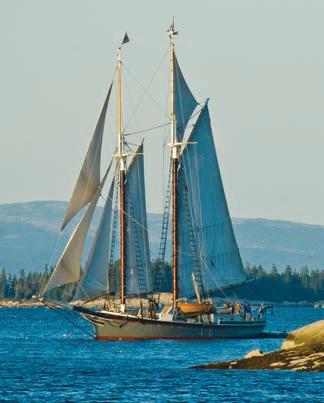
Ask us about our specialty cruises, too!
| 127
FEB. 6–7: NEWPORT, Winter Festival. Celebrate winter in all its wonder around the bay and at Gardner Memorial Park. Enjoy competitions, crafts, good food, fireworks, entertainment, and plenty of community spirit. newportrecreation.org
FEB. 13: NORWICH, Igloo Build. One of the Montshire Museum’s longest-running and most fun traditions returns, as igloo expert Bert Yankielum gives hands-on instruction on how to build an insulated, sturdy snow house. Fun for all ages, with indoor warm-up activities throughout the day. Free with museum admission. 802-649-2200; montshire.org
FEB. 13–21: BRATTLEBORO, 60th Winter Carnival. A variety of activities for all ages at locations across town, including concerts and shows, cook-offs, a pancake breakfast, sporting competitions, and more. 802-3481956; brattleborowintercarnival.org
FEB. 13–21: WOODSTOCK, Sleigh Ride Week. Climb aboard the Billings Farm & Museum sleigh for a ride across the frosty fields. Sled with jack jumpers and, in commemoration of Presidents’ Day, sample some of our First Families’ favorite cookies. In the barns, discover Vermont dairy farm life, past and present. 802-457-2355; billingsfarm.org


FEB. 20–21: BRATTLEBORO, Fred Harris Memorial Ski Jumping Tournament. Look, up in the sky … Harris Hill Ski Jump, the only 90-meter ski jump in New England, hosts one of the region’s most popular winter sporting events, which has to be seen to be believed. harrishillskijump.com








FEB. 24–28: BURLINGTON, “Noises Off.” The opening-night performance of the farce Nothing On is just hours away, and as the cast stumbles through their final dress rehearsal, things couldn’t be going much worse. With lines forgotten, love triangles unraveling, and sardines flying everywhere, this show-within-a-show stage classic at the University of Vermont will put a smile on your face. 802-656-2094; uvm theatre.org
FEB. 28: STOWE, Stowe Derby. Dating back to 1945, this unique event is one of the oldest ski races in North America, combining downhill and cross-country to test a whole range of abilities. The excitement begins atop Mount Mansfield and concludes in the historic village of Stowe, and just one set of skis is allowed. 802-253-7704; stowederby .com; gostowe.com
Correction
In our November/December issue, the four Maine photos on p. 93 (“A Truly Miraculous Creature”) were shot by Russell French.


Call ahead to confirm dates, times, and possible admission fees.
To submit an event online, go to: YankeeMagazine.com/submitevent




To find more events in your area, visit: YankeeMagazine.com/events

SO SIMPLE it’s practically maintenance free. There are no hydraulic pumps, valves, pistons, hoses or fluids to leak or replace — EVER.

SO STRONG its cast iron flywheel and hardened steel components show almost no wear after splitting hundreds of cords.


SO FAST 6X faster than hydraulic splitters!

SELF-FEEDING models available. No more force-feeding!
CHIP BIG BRANCHES up to 5.75" thick!
COMMERCIAL STYLE high-discharging models direct wood chips right where you want them.


















MODELS that SHRED yard and garden waste as well as CHIP branches.



PERFECT FOR:

• Sensitive financial documents









• All burnable household waste*


• Old leaves and branches
STAINLESS STEEL CONSTRUCTION is lightweight, durable, and portable (it folds for easy storage).






PERFORATED LID and sidewalls maximize airflow and trap embers.







1600° TEMPERATURES mean more thorough burning with less ash.
No more UNSAFE and UNSIGHTLY rusty barrel!







(continued from p. 58)
TOTAL TIME : 45 MINUTES ;
HANDS- ON TIME : 45 MINUTES
Tender white cannellini beans are sautéed with a hot and sweet Italian-style sausage, tomatoes, fresh herbs, and sweet roasted garlic cloves. This skillet casserole is then topped with a crunchy panko/herb/lemon mixture. Serve with a green salad and crusty bread.
Note: To make this dish using dried beans, soak them in cold water overnight. Drain and place in a clean pot, cover with water, add salt and pepper and a bay leaf, and simmer over low heat until tender, 1 to 2 hours. Drain and use.
FOR THE CASSEROLE:
6 large cloves garlic
2 tablespoons olive oil, divided
2 sausages, 1 hot Italian and 1 sweet Italian
2 19-ounce cans cannellini (white kidney) beans, drained, washed under cold running water and drained again (see “Note,” above)
1 1/2 teaspoons kosher salt
1/2 teaspoon freshly ground black pepper
1 tablespoon chopped fresh thyme leaves
1/2 cup chopped fresh parsley
1/3 cup dry white wine
FOR THE TOPPING:
1 cup panko breadcrumbs
1 teaspoon freshly grated lemon zest
1 tablespoon minced fresh chives
1/2 teaspoon kosher salt
1 tablespoon olive oil
Preheat your oven to 325°. Place the garlic cloves in a small skillet or ovenproof dish and cover with 1 tablespoon of the oil. Roast until the cloves feel tender when pierced with a small, sharp knife, about 12 minutes. Remove from the oven and let cool. Chop the cloves coarsely and reserve the oil.
Remove the sausages from their casings and crumble into a large skillet over medium heat. Cook, stirring and breaking up the sausages, until golden brown, about 10 minutes. Stir in the reserved garlic with its oil, the beans, the tomatoes, salt, pepper, thyme, and parsley, and cook 10 minutes over low heat. Raise the heat to high and add the wine; simmer 3 minutes. (This casserole can be made up to 24 hours ahead of time up to this point; cover the skillet and refrigerate until ready to bake.)
Preheat your oven to 400° and set a rack to the middle position. Make the topping: In a small bowl, mix the breadcrumbs, lemon zest, chives, salt, and oil.
Press the topping onto the beans and sausage. Cover the skillet with foil and bake 20 minutes. Remove the foil and bake until the juices are bubbling and the casserole is very hot, 10 to 15 minutes more. Yield: 6 servings
More classic one-dish recipes: YankeeMagazine.com/Casseroles
F or almost a hundred years it lay dormant. Silently building strength. At 10,000 feet high, it was truly a sleeping giant Until May 18, 1980, when the beast awoke with violent force and revealed its greatest secret Mount St Helens erupted, sending up a 80,000-foot column of ash and smoke. From that chaos, something beautiful emerged our spectacular Helenite Necklace
EXCLUSIVE FREE
Helenite Earrings
-a $129 valuewith purchase of Helenite Necklace
Helenite is produced from the heated volcanic rock of Mount St Helens and the brilliant green creation has captured the eye of jewelry designers worldwide Today you can wear this massive 6½-carat stunner for only $149!

Make your emeralds jealous. Our Helenite Necklace puts the green stone center stage, with a faceted pear-cut set in 925 sterling silver finished in luxurious gold The explosive origins of the stone are echoed in the flashes of light that radiate as the piece swings gracefully from its 18" luxurious gold-finished sterling silver chain Today the volcano sits quiet, but this unique piece of American natural history continues to erupt with gorgeous green fire
Your satisfaction is guaranteed. Bring home the Helenite Necklace and see for yourself If you are not completely blown away by the rare beauty of this exceptional stone, simply return the necklace within 30 days for a full refund of your purchase price
JEWELRY SPECS:
- 6 ½ ctw Helenite in gold-finished sterling silver setting
- 18" gold-finished sterling silver chain
Limited to the first 2200 orders from this ad only
Helenite Necklace (6 ½ ctw)................Only $149 +S&P
Helenite Stud Earrings (1 ctw) ....................$129 +S&P

Helenite Set $278 ...Call-in price only $149 +S&P (Set includes necklace and earrings)
Call now to take advantage of this extremely limited offer.
1-800-333-2045
Promotional Code HEL790-04
Please mention this code when you call Rating of A+
“My wife received more compliments on this stone on the first day she wore it than any other piece of jewelry I’ve ever given her.”
- J. from Orlando, FL Stauer Client
(continued from p. 89)
spacious lodge. Urso proudly points to the corner of the main room, where above a small stage a sign hangs between the U.S. and New Hampshire flags. “First in the Nation Vote” it says.
A rekindling of a past tradition may be part of Millsfield’s push to return to midnight voting, but it’s not the sole driving force. As Urso maps out how election night will play out, it’s hard not to detect a sense of friendly competition in his tone. Especially when talk circles back to Dixville. After leaving Log Haven, Urso heads 10 miles north to The Balsams, where a high chainlink fence borders the rambling, red-roofed building. A few out-of-state tourists have hopped off their motorcycles and are clicking photos of the hotel, which sits on the landscape like an abandoned ship.
“A legitimate voting district needs election officials,” Urso says. “Three selectmen, a town clerk, supervisors of the checklist, a moderator. They say they’re going to hold the primary in Dixville, and we hope they do, but as I understand it, there are only two registered voters. How do you run an election with only two voters? Everyone seems to focus on claims that Dixville and The Balsams will be ready.” Urso smiles, but holds back from laughing. “It seems unlikely.”
The town office in Hart’s Location is about as modest a structure as one might expect from a remote community of 41 residents in New Hampshire’s White Mountains—one that managed to go without electricity until 1970. A pair of retired Appalachian Mountain Club log cabins joined together, the building lacks plumbing or any kind of excess space. Come Town Meeting time, tables and chairs are rearranged in front of the town clerk’s desk to accommodate the session.
Hart’s is a model for what a reprised midnight-voting tradition can look like. What began in 1948 as a way to accommodate the town’s railroad workers, who couldn’t make it to the polling station during the day, quickly morphed into an event that drew reporters from around the country. On the walls of the town office hang framed black-and-white pictures that showcase its history. In one 1956 print, seven grinning residents hold up a sign that says, “Ike 3, Adlai 5.”
But the practicality that gave early voting its birth soon collided with the
put on hold until they had the Dixville numbers,” says Ed Butler, the planningboard chairman, who, with his partner, Les Schoof, owns The Notchland Inn. He lets out a friendly sigh and smiles: “It’s what the media and marketing people created. It’s the place that has the first vote, and that will probably be true 10 years after it no longer has the vote.”
And yet Hart’s hasn’t been completely overlooked. Candidates visit— Dennis Kucinich had a vegan Thanksgiving at The Notchland in 2004—and a mix of international and domestic press roll through periodically. A Japanese film crew spent a month in Hart’s making a documentary about its vote. “We were treated like the indigenous people of New Hampshire,” Butler cracks. “Shovel off your roof; now split some wood; okay, clear your car.”
Hart’s Location’s seven voters display local results from the 1956 presidential race. After an eight-election interval from 1964 to 1992, the tradition of midnight voting here was revived in 1996 and has carried the town through the past five national contests.

accompanying media circus, and in 1964 fed-up residents reverted to regular polling hours. “One of the legends is that an old geezer complained that he couldn’t go to the outhouse without some reporter following him,” says Mark Dindorf, a longtime resident and chairman of the selectboard.
Faded memories of those earlier hassles and a greater appreciation for the publicity that midnight voting could bring prompted Hart’s to return to it in 1996. If you’ve stayed up late enough on election night for the Dixville results, you’ve probably heard Hart’s Location’s name. Its tally is always reported second, which bothers residents only mildly.
“I remember being on the phone with New Hampshire Public Radio and CNN to announce our results, and I was
Midnight voting can work only in a small town like Hart’s because voting takes a matter of minutes; nobody has to wait hours for the final results. But that same tiny size also presents challenges for those who make it happen. Everyone in town has to be on board for the vote. One vengeful or forgetful resident, and the polls have to stay open until everyone is accounted for. It’s why, a month before the election, Hart’s residents receive a form letter that reminds them of the election and asks them to let the town know how or if they plan to participate. On voting night they’re asked to be at the town office no later than 11:30 p.m. Have there been close calls? You bet. In 1996, for example, there was a lastminute scramble to fetch one resident who’d forgotten to come in. But through five primary and general election cycles, the town has had full participation. And that, Dindorf says, is bigger than any rivalry with Dixville and now, perhaps, Millsfield.
“People talk about having this battle for the first vote,” he says. “To me, the thing that matters more is that we can muster 100 percent turnout. Wouldn’t it be great if the rest of the country could do that?”














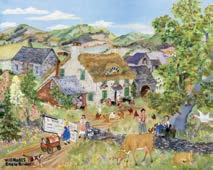










































EnergAire continuously purifies up to 4,000 cubic feet (a large room) of air and makes it breathable and invigorating. Restores natural ion balance to unhealthy environments caused by industrial pollution, automobile exhaust, central airconditioning, and heating, smoke, dust, pollen, animal fur. . . removes microscopic pollution particles not removed by any other method of air purification. EnergAire was rated Number One for speed of removal of cigarette smoke by the leading U.S. consumer protection magazine. It has no noisy fan, no costly filter, and requires no maintenance. Uses less than 2 watts. 9" high. 3" diameter. Weighs less than 1 pound. $59.95


















RODAR is the super-powerful professional ultrasonic pest repeller with up to 60 or more times the power of other devices — and power is what makes RODAR so effective. RODAR ultrasound equals a jet engine — noise unbearable to pests but at frequencies humans and pets cannot hear. RODAR units are completely safe. RODAR drives pests out and keeps them from getting in. Handsome simulated walnut cabinet 5-5/8 high. Weight 1-1/2 pounds. Uses less than 5 watts. $89.95




Please check your proof carefully. Approval must be returned by




Publisher is not responsible for errors once proof has been signed— or if not returned by the above date. Please note that color proof/pdf is to show color break only. Colors do not accurately represent actual printed advertisement as it will appear in the publication.



If we have made any errors, mark them clearly.________________________________________________________





















OK as is. Signature:







OK with corrections. (no new proof necessary) Signature:





Changes or corrections needed. (send new proof) Signature:

CUSTOM ENGRAVED BRASS NAMEPLATES. Many styles to choose from. Online ordering available. Visit our website: www.USBrassShop.com
CHINA CRYSTAL SILVER
CHINA, CRYSTAL, SILVER, COLLECTIBLES
World’s largest inventory; vintage and new patterns. FREE item lists. Replacements, Ltd. 800-REPLACE (800-737-5223) www.replacements.com
FRAN’S LUCKY TEES
WEAR2WIN LUCKY TEES
If you like Teddy Bears and Casinos, you will love FRAN’S Lucky Tees! For FREE BROCHURE Email:wear2win@aol.com
FUN FAMILY AUCTION 8
Clearing out your attic? FIND OUT WHO WANTS WHAT with a Fun Family Auction. It’s easy • It’s fair • It’s fun! Find out more at: www.FunFamilyAuctions.com
STAIRLIFTS, RESIDENTIAL ELEVATORS, DUMBWAITERS, PLATFORM LIFTS. Free in-home evaluation available. Freedom Lifts. 888-665-4387; www.freedomliftsonline.com
To advertise please call Bernie Gallagher at 203-263-7171
Three One-Act Plays About the Elderly by Elyse Nass
• Second Chance • Admit One •
• The Cat Connection • Comedy-Dramas produced in community theatres & senior venues. Visit: www.samuelfrench.com
UNION, MAINE $695,000
Restored 18th Century Federal 54+ Acres - For Beautiful Details, Visit ebenezeraldenhouse.com
Jim Ianello-Cates Real Estate 207-975-0022 • jim@catesre.com
SEBASTIAN, FL
Beautiful 55+ community. Voted 2012 “Best of Sebastian.” Manufactured Home Community. New homes starting at $84,900. 4 mi to the ocean. 772-581-0080 • www.beach-cove.com
Beautiful NORTH GEORGIA Home Appraised $343,000. SELL or TRADE for Northeast Home. Logon: goswap.org • Listing: 16368 Email: bjheimanson@yahoo.com 706-781-2981
TRANSFER TO CD YOUR COLLECTION OF 45s/33s/78s, cassettes and reel to reel tapes Call Alex at 603-905-9123 for pricing www.theotherguyrec.com
COLONIAL SHUTTERS, interior and exterior, raised-panel and louvered. Custom storm/screen doors. Free brochure. Colonial Shutterworks, Mattapoisett, Massachusetts. Call 888-295-0732; www.colonialshutterworks.com
For furniture, daybeds, chairs, futons, ottomans, fabrics, cushions, pet covers. All shapes. Made in USA! 888-405-4758 • www.slipcovershop.com
KIAWAH ISLAND, SOUTH CAROLINA. Select 1- to 10-bedroom accommodations. Pam Harrington Exclusives. Call toll-free 800-845-6966 for a complimentary brochure; www.kiawahexclusives.com
PLEASE NOTE
CHATHAM, CAPE COD
9-Bedroom Estate. Sleeps 18. Ocean Views. Great for Weddings, Friends & Family Reunions. Booking Now! Available year-round. Call John: 617-799-5818 e-mail: john@oldeforgerealty.com
WANTED TO BUY WANTED: OLD RADIOS, HI-FI/STEREO AMPLIFIERS, vacuum tubes, entire radio collections, radio and movie theater equipment, microphones, Western Electric tubes, Edison cylinders and players. Call: 203-272-6030 Email: Larry2942@cox.net
Coin and Stamp Buyer
Visits your home...
Traveling New England, paying highest prices for entire collections of coins, stamps, paper money, gold, silver, fine jewelry, and Tiffany. Complete privacy and safety of your own home.
Payment in full on the spot.
Call Anthony’s: 800-427-9897
Established 1958

hen Kosti Ruohomaa looked through the lens of his camera, he saw not only a single photograph but also a story, one filled with emotion, drama, and the complexity of life. Ruohomaa was born to Finnish immigrants in Quincy, Massachusetts, in 1913, but moved to Maine at age 13, and, during an international career that saw his work in leading publications throughout the 1940s and ’50s until his death in 1961, it was Maine that called to him more than anywhere else.
This photo, Trawler Quincy at the Grand Banks, 1957, a gelatin silver print, is now on display at the Maine State Museum in Augusta until July 2016 as part of an exhibition, The Passionate Photographer: Kosti Ruohomaa’s Maine in
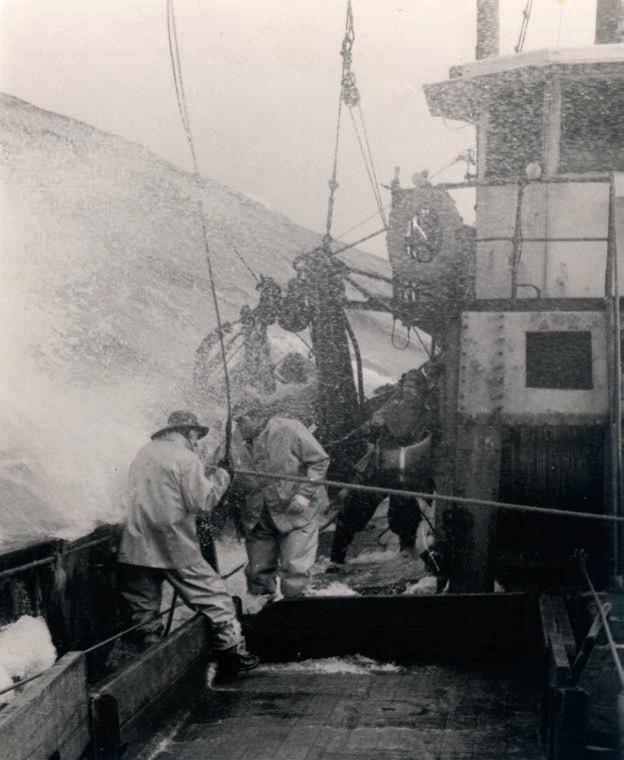
Maga zine Photojournalism, showcasing his remarkable eye for story and understated emotion. Whether you’re viewing the freezing swells faced by Grand Banks fishermen or the steadfastness of a Maine farmer on his well-worn path to a winter barn, once you spend time seeing the world through Ruohomaa’s eye, something will change for you.
Howard Chapnick, who headed the Black Star photo agency, for which Ruohomaa shot many of his images, once said, “The word [‘artist’] is thrown around with gay abandon in photography: ‘This picture looks like a Rembrandt, this one like a Renoir.’ Kosti’s photographs do not have to be compared to the work of painters. A Ruohomaa picture looks like a Ruohomaa!” mainestatemuseum.org —Mel Allen
The Pelatiah Leete House is one of the earliest surviving dwellings built in Guilford, CT in the early 18th century, by Pelatiah Leete, the grandson of Guilford founder, and Connecticut governor, William Leete. It is one of only a handful of properties in Guilford that is included on the National Register of Historic Places. In 1781, during the American Revolution, the Battle of Leetes Island was fought across the road from the house and its surviving 1705 barn, and Simeon Leete, who lived in the house at that time with his wife and three small children, was mortally wounded near the conclusion of the battle. He was brought back to the house, where he died, at age 28, the following day. His gravestone is around the corner from the house, on land owned by the Leete family since 1661, and an annual celebration of his life is held every June on the Sunday nearest June 19, the anniversary of his death date. The Sixth Connecticut Regiment of the Continental Line performs musket drills and live firing at the event, which draws numerous neighbors and townspeople.



AUTHENTIC COLOURS crafted by masters of 18th and 19th Century color fidelity - fifth generation paintmakers. The Old Village paint craftsmen create the authentic colors that simply cannot be matched by a mass production process or by guessing and mixing. Old Village Paints are of superb quality, using natural earth pigments from around the world, as well as the heartland of America.


P.O. Box 130
• Perkiomenville PA 18074



Email: info@old-village.com

Tel: 215-256-0077 • Fax: 215-256-0022
Toll Free: 800-498-7687 | www.old-village.com








